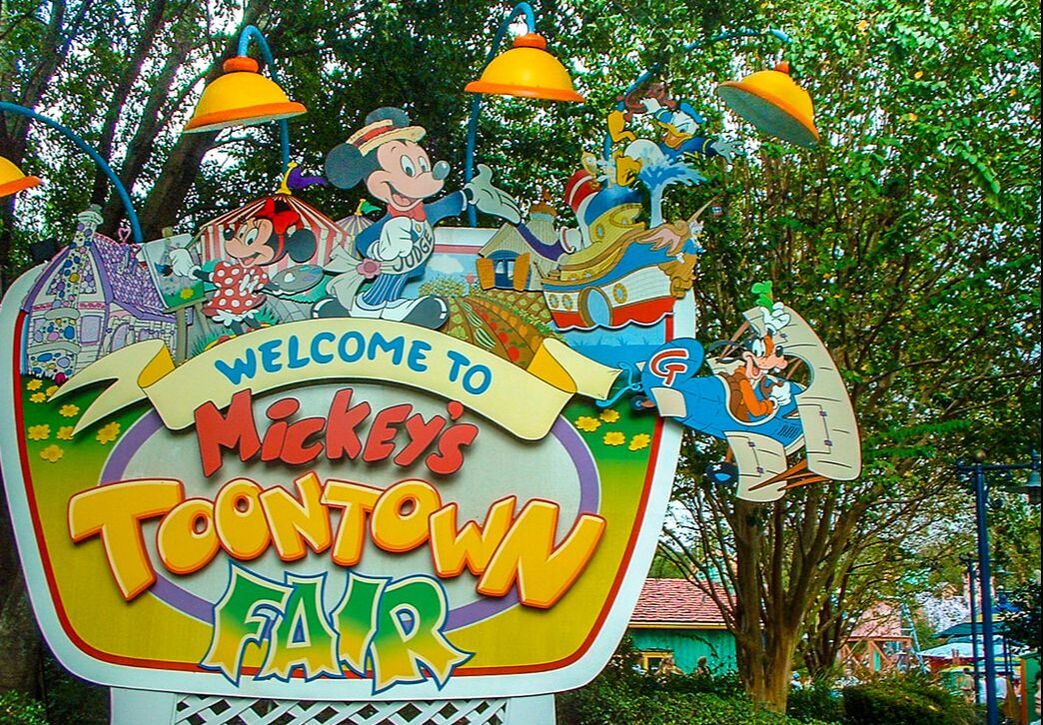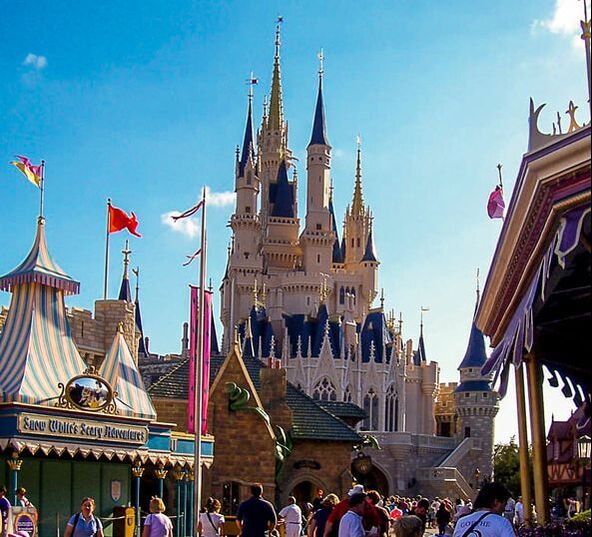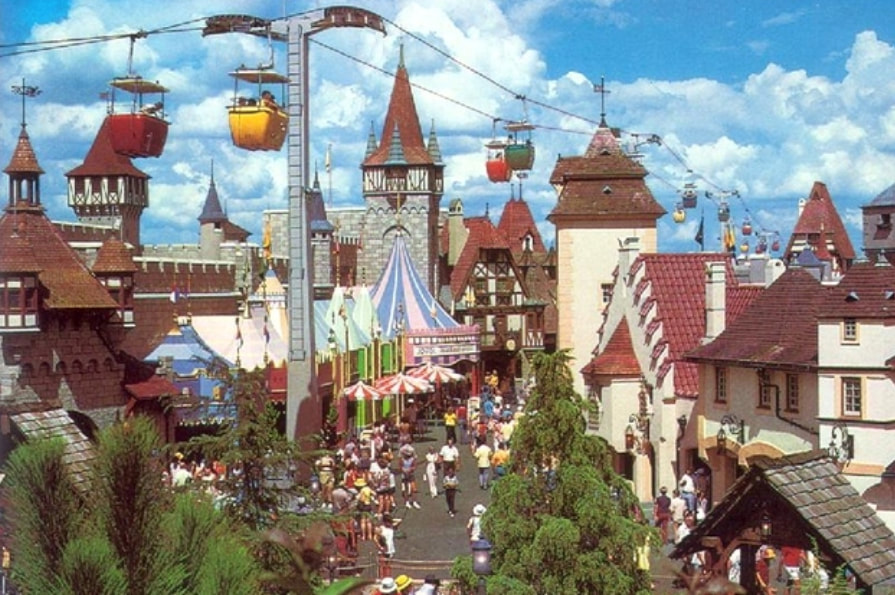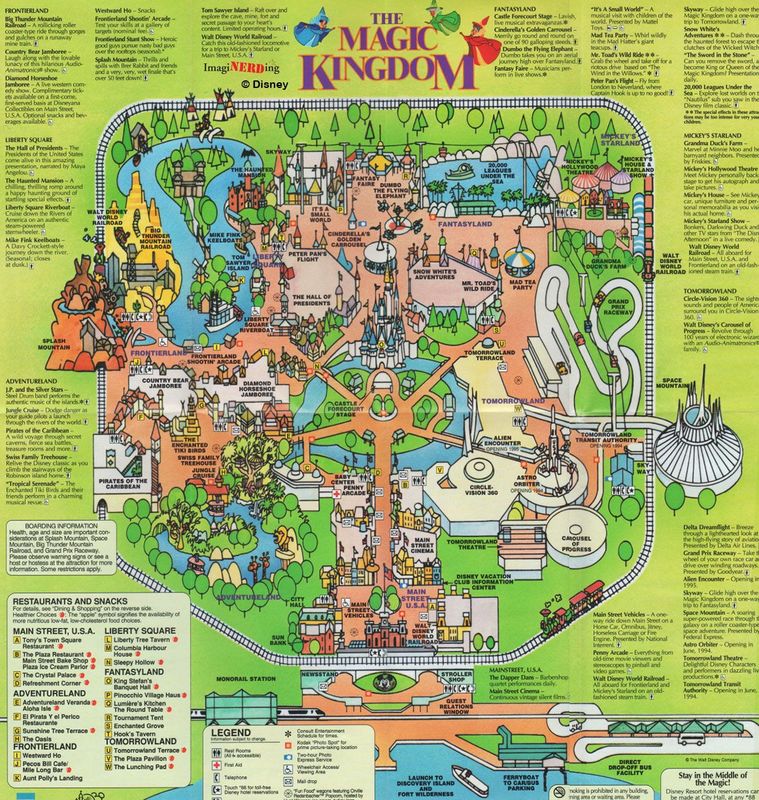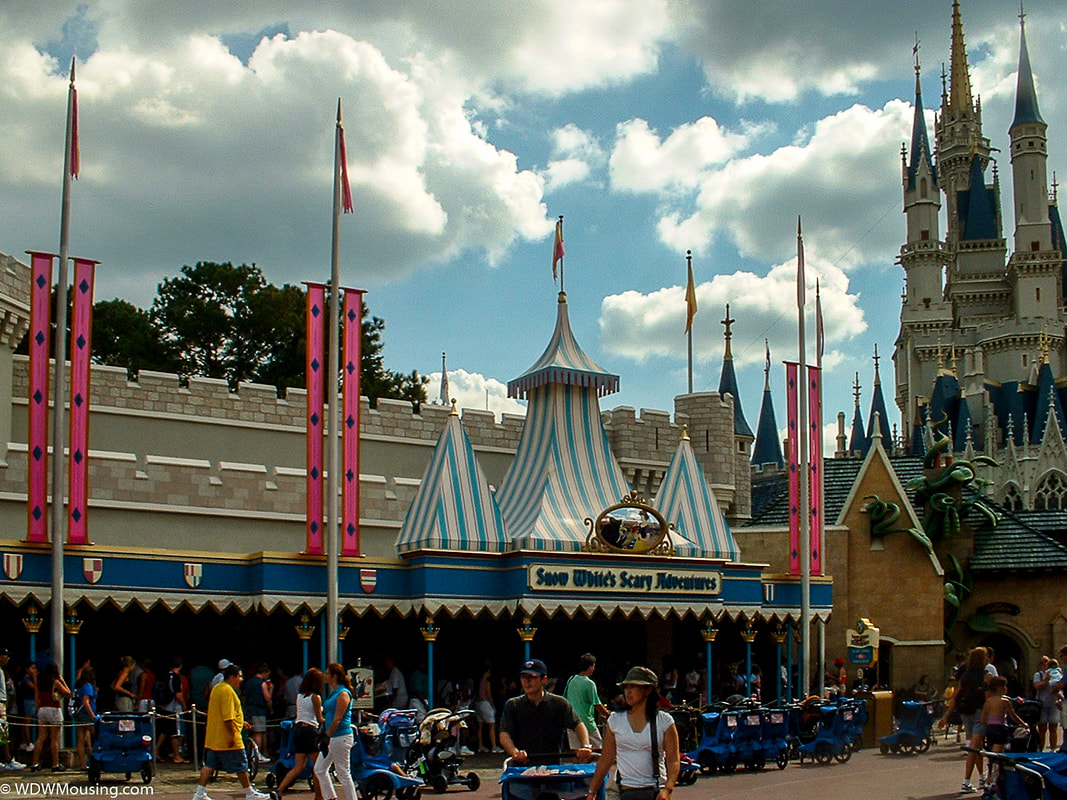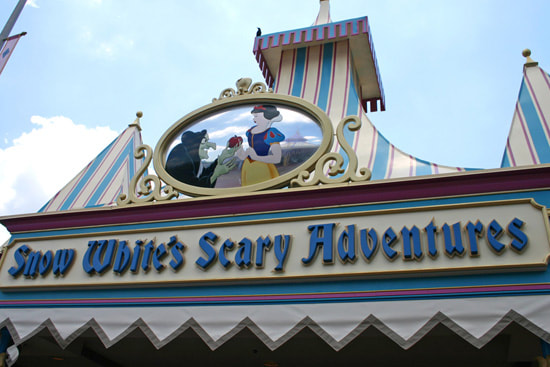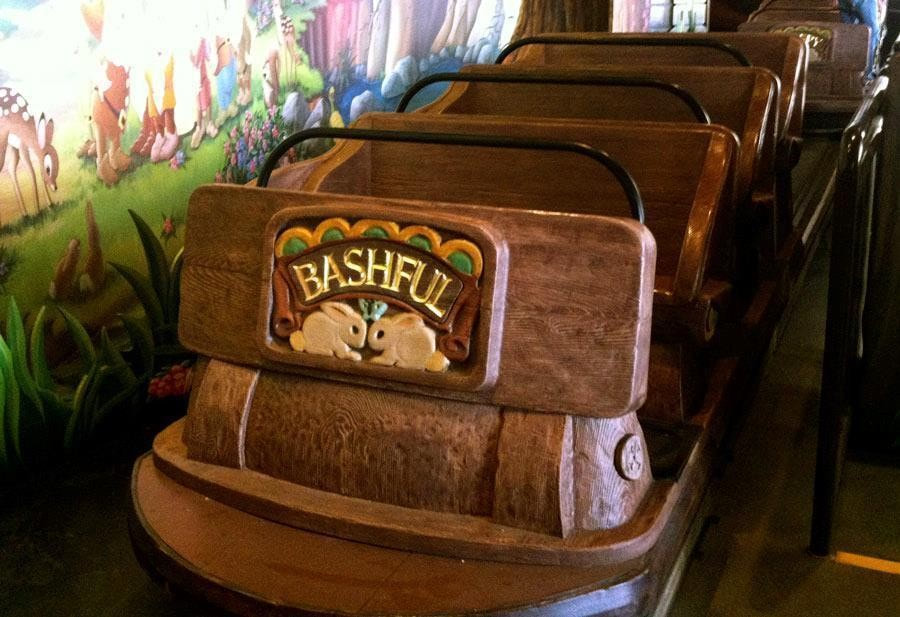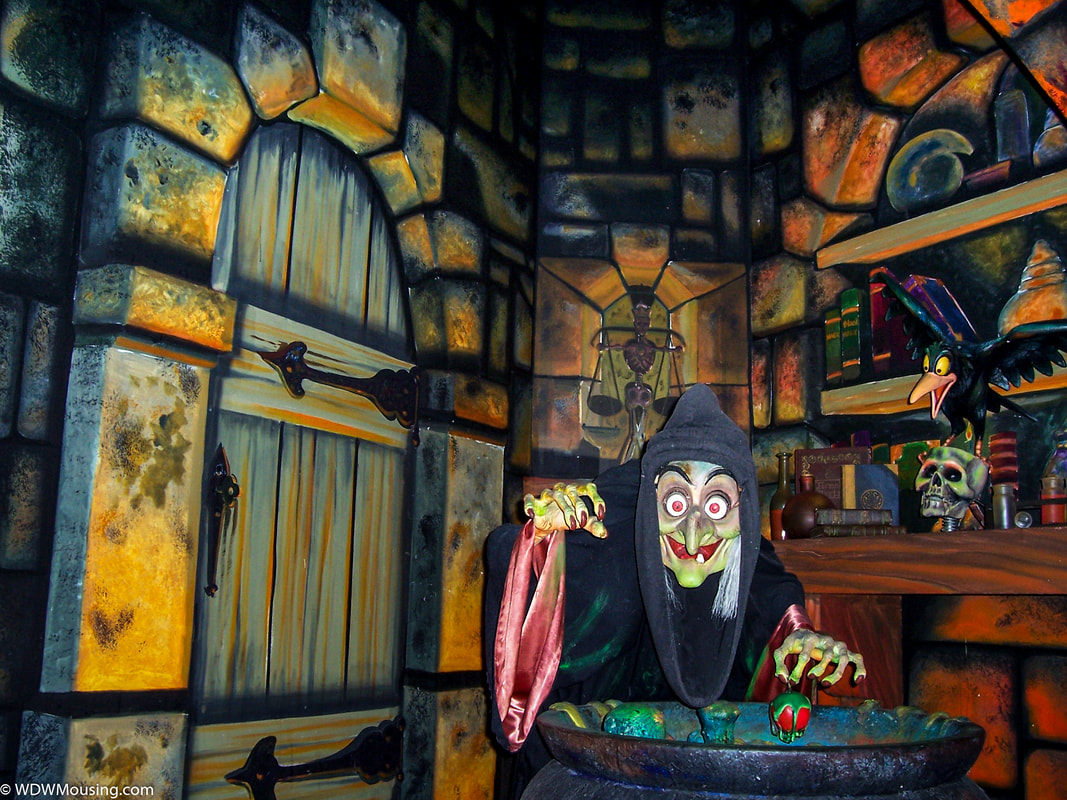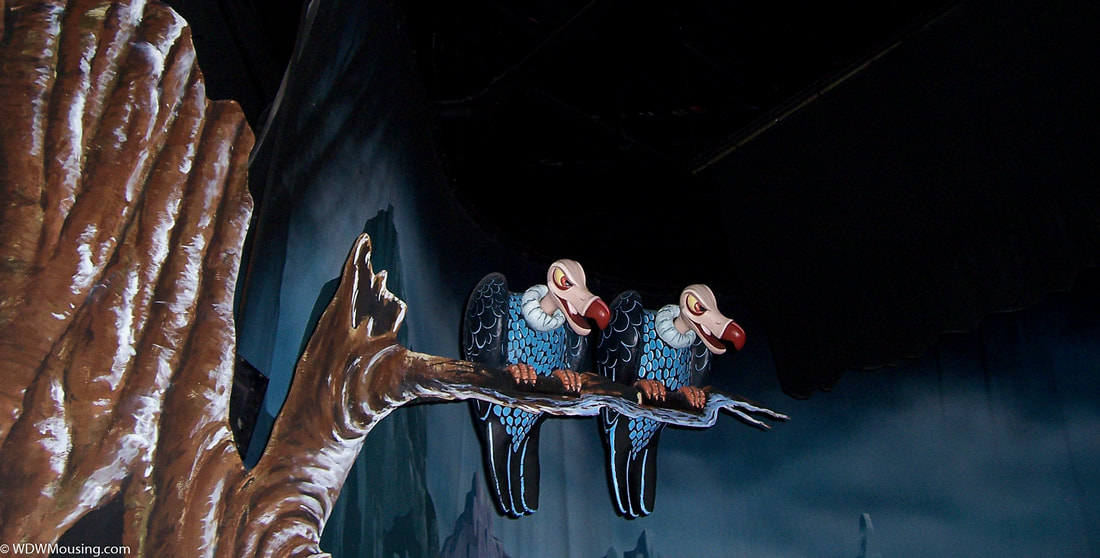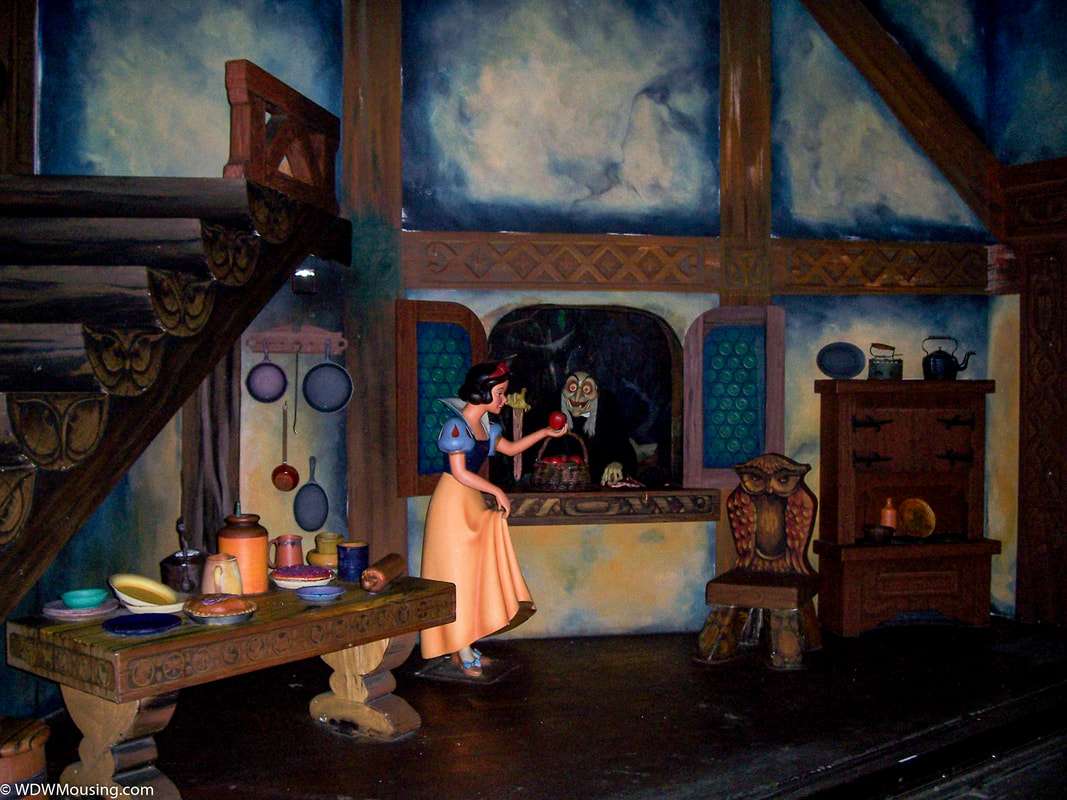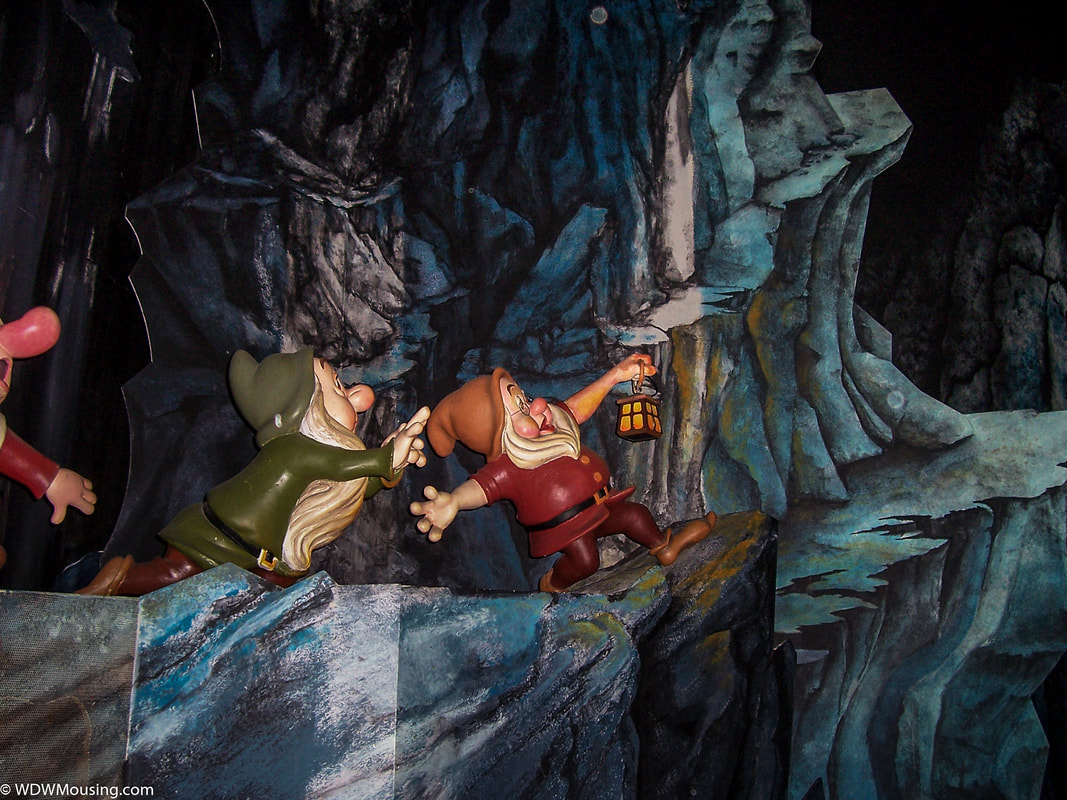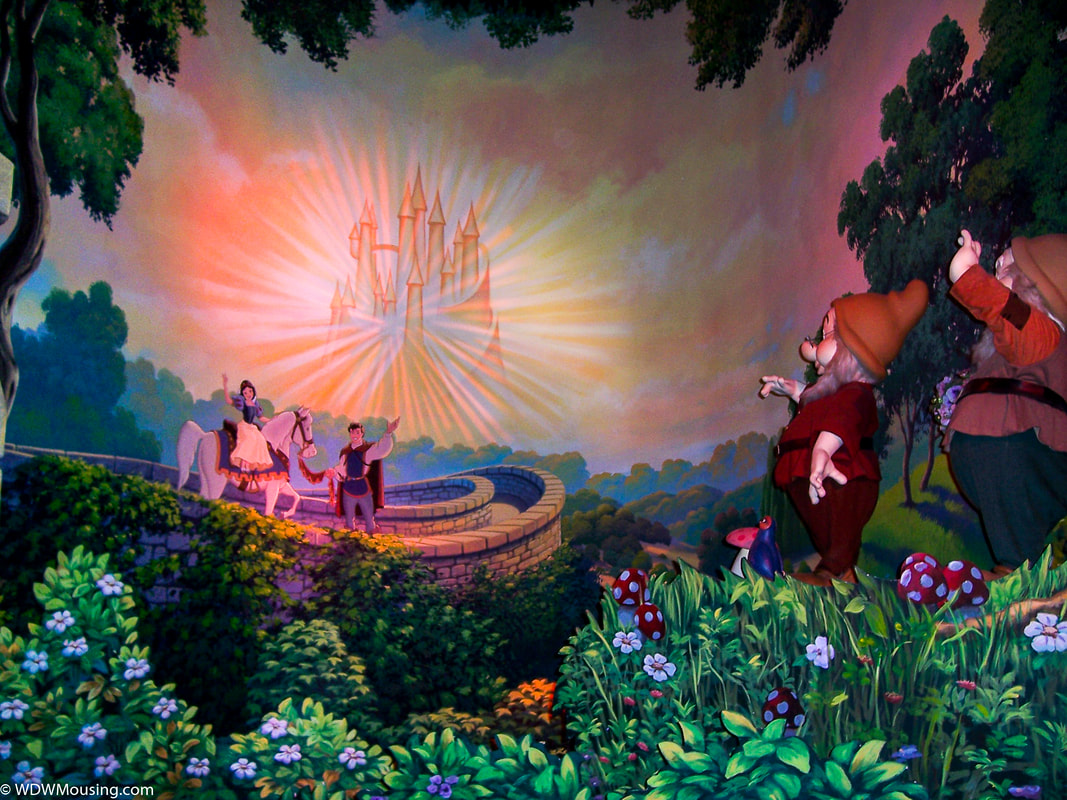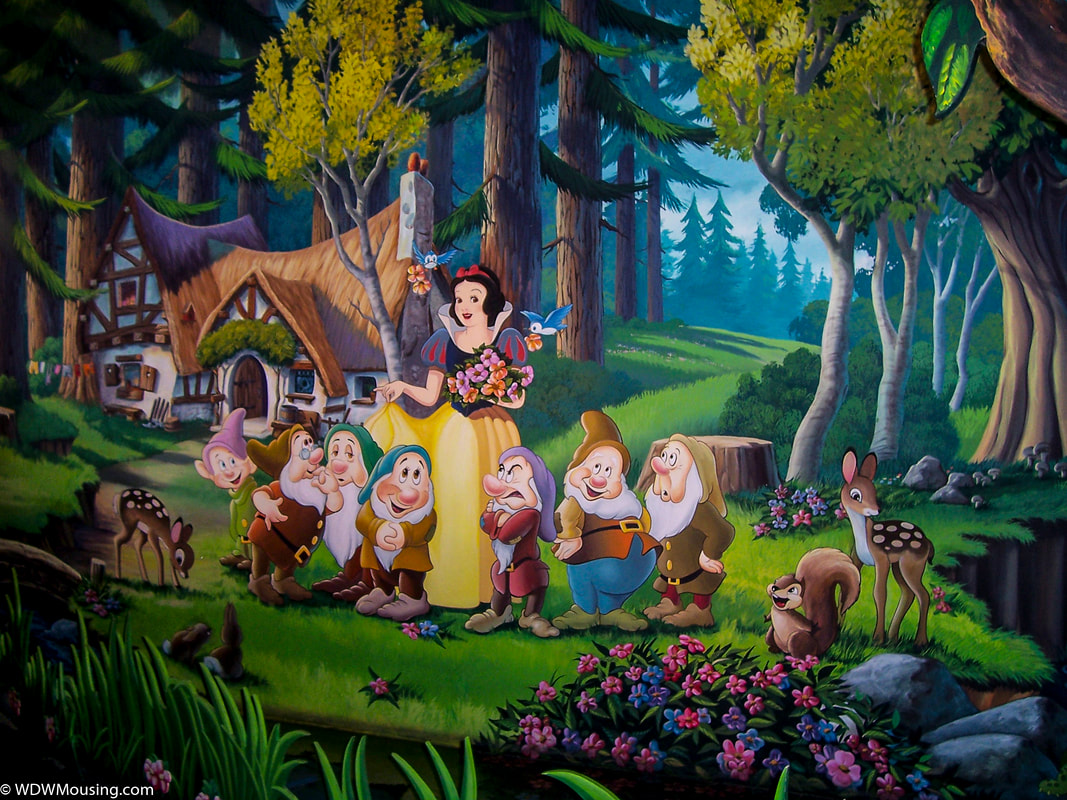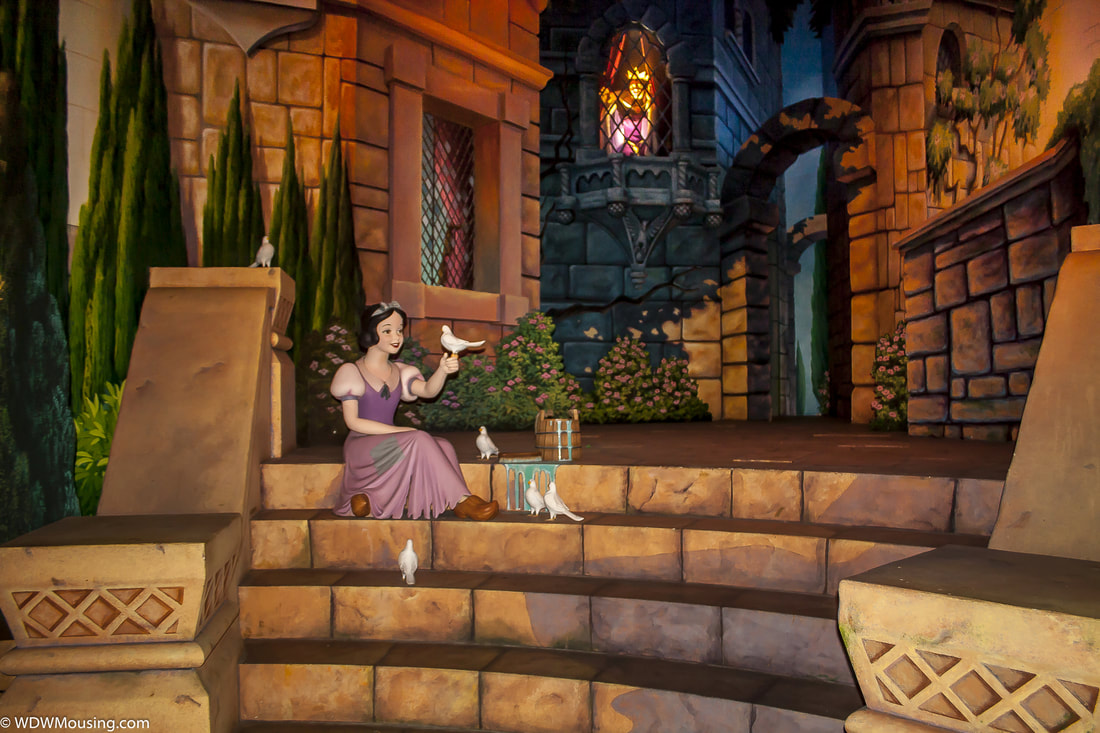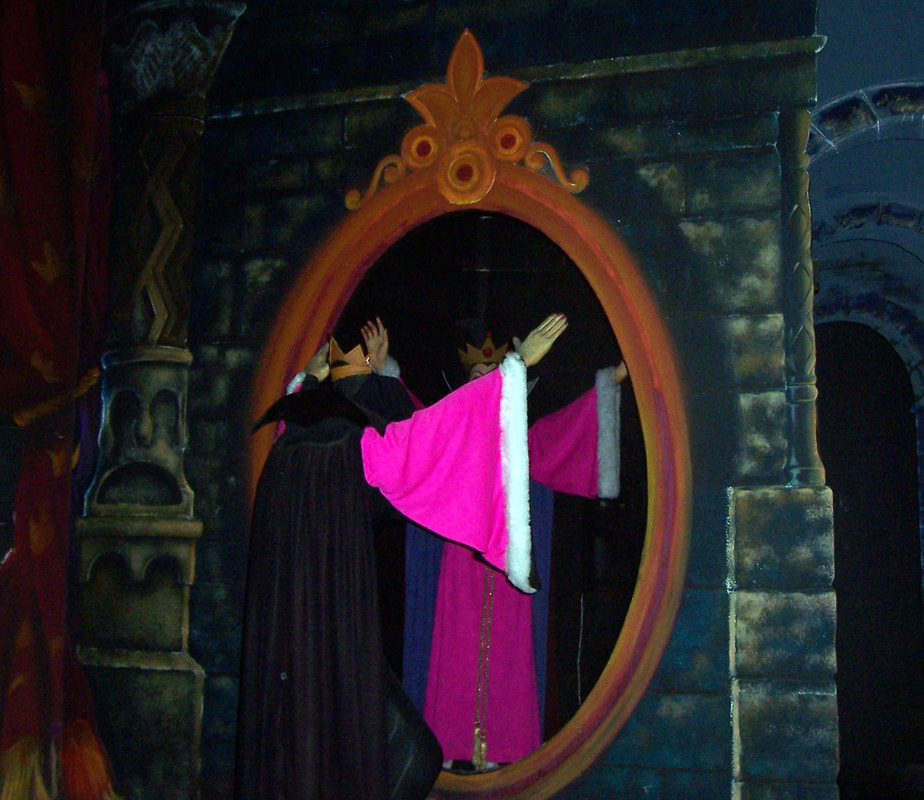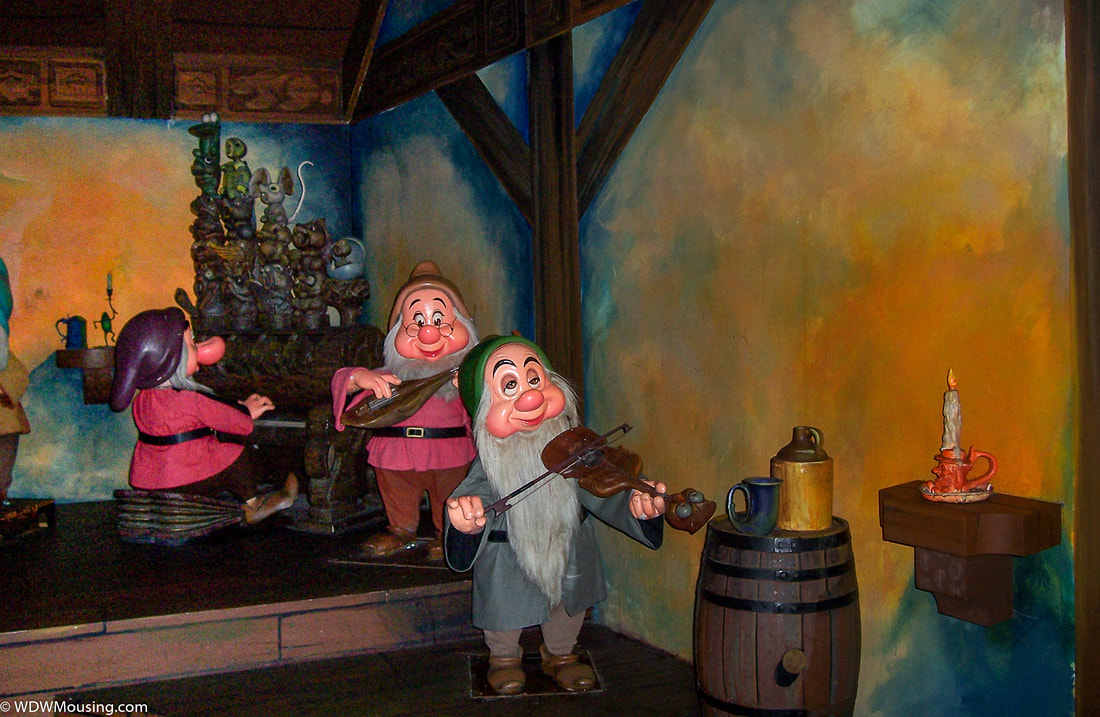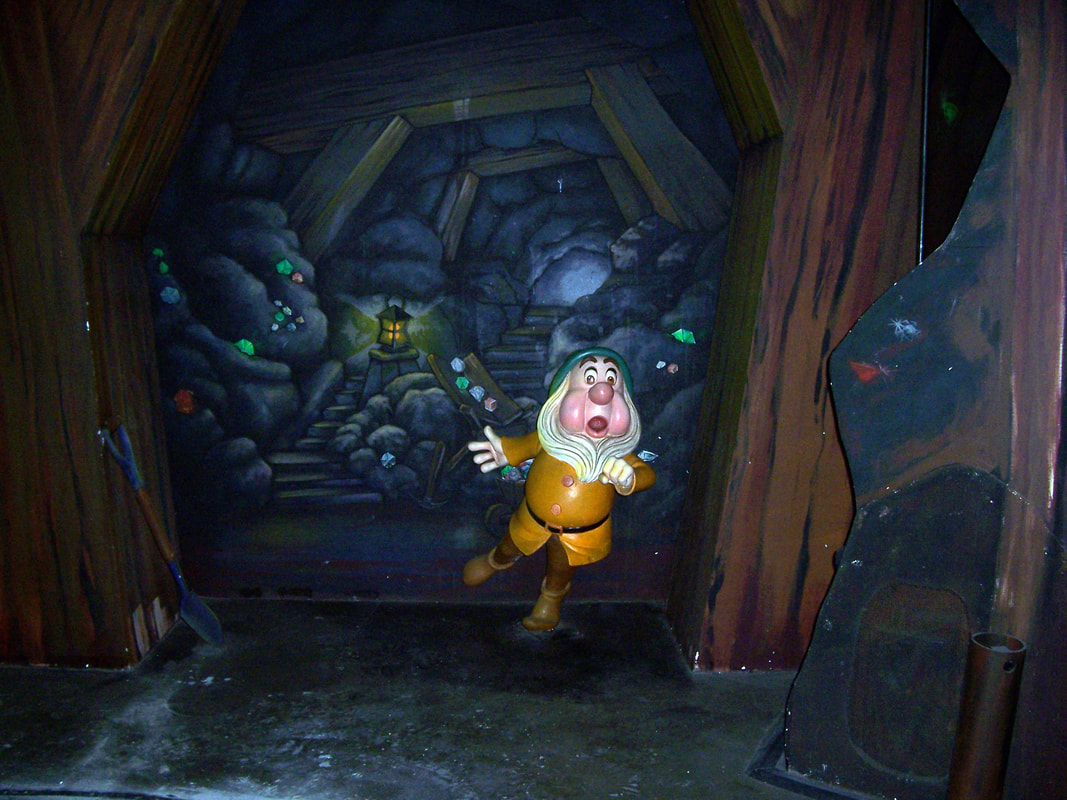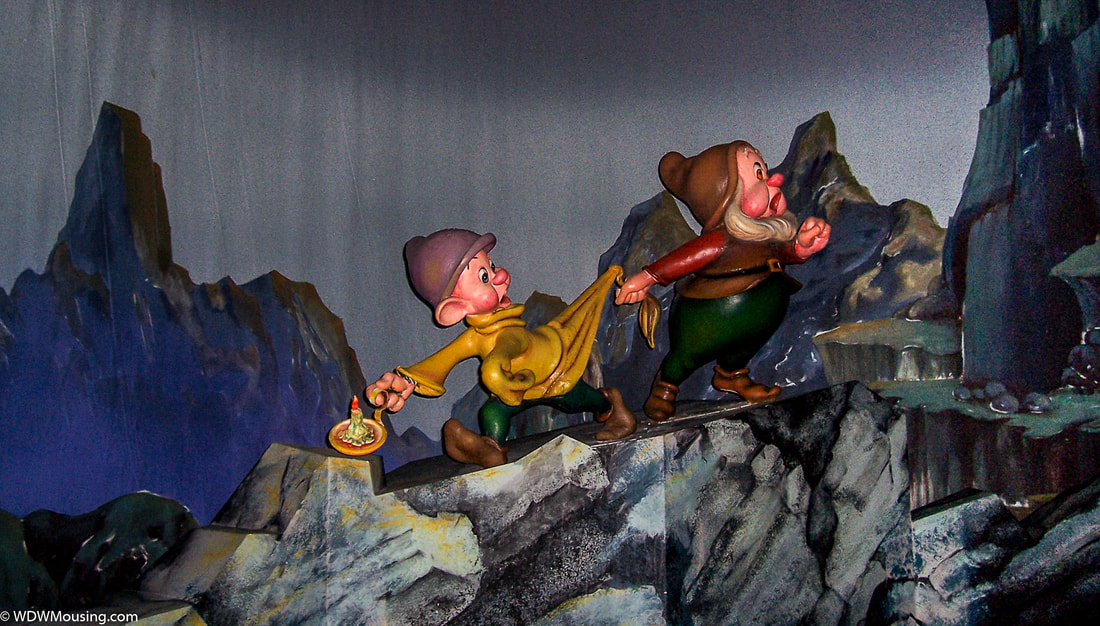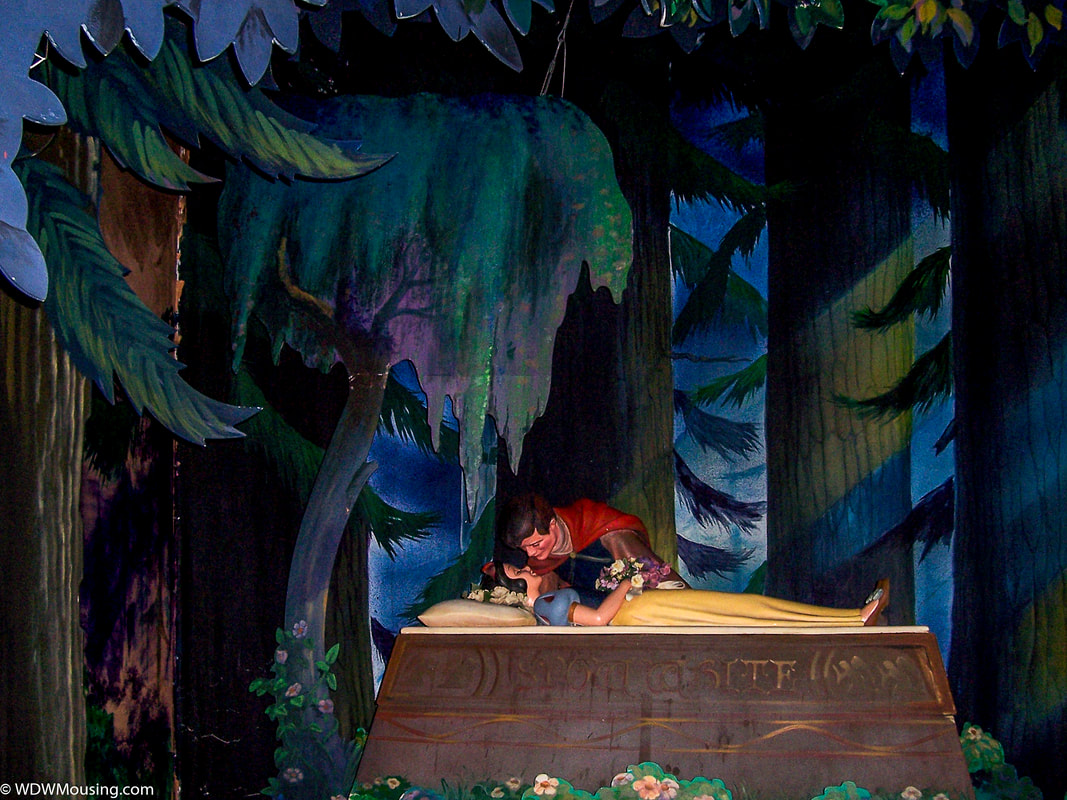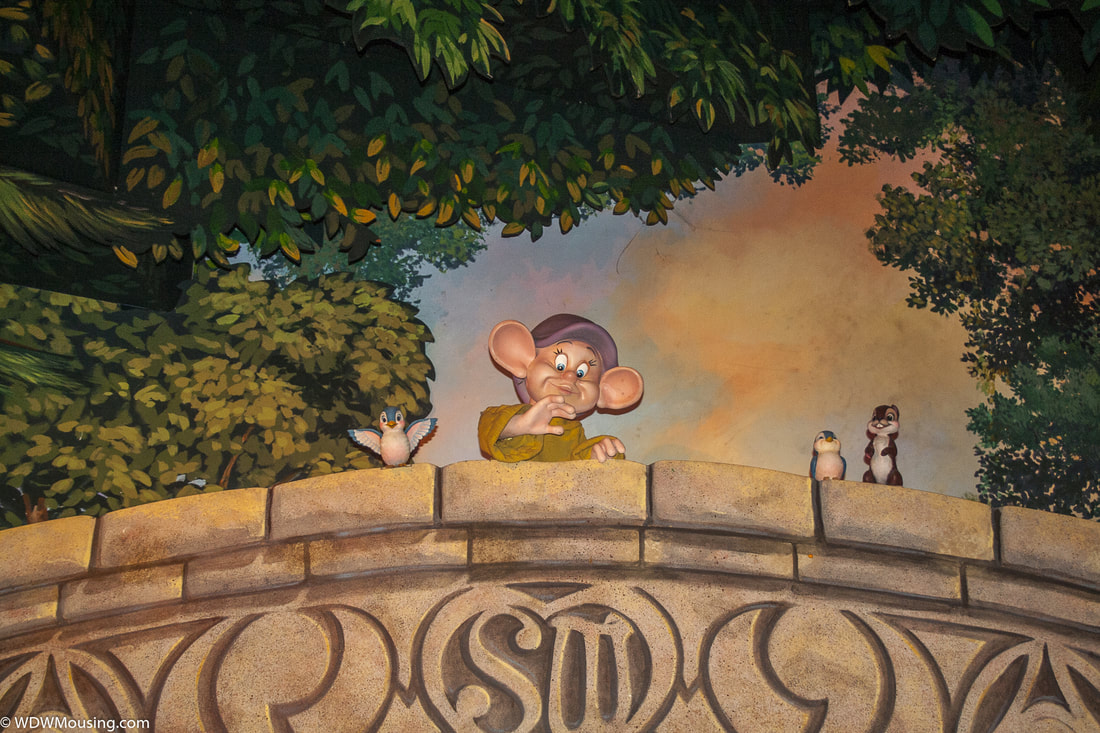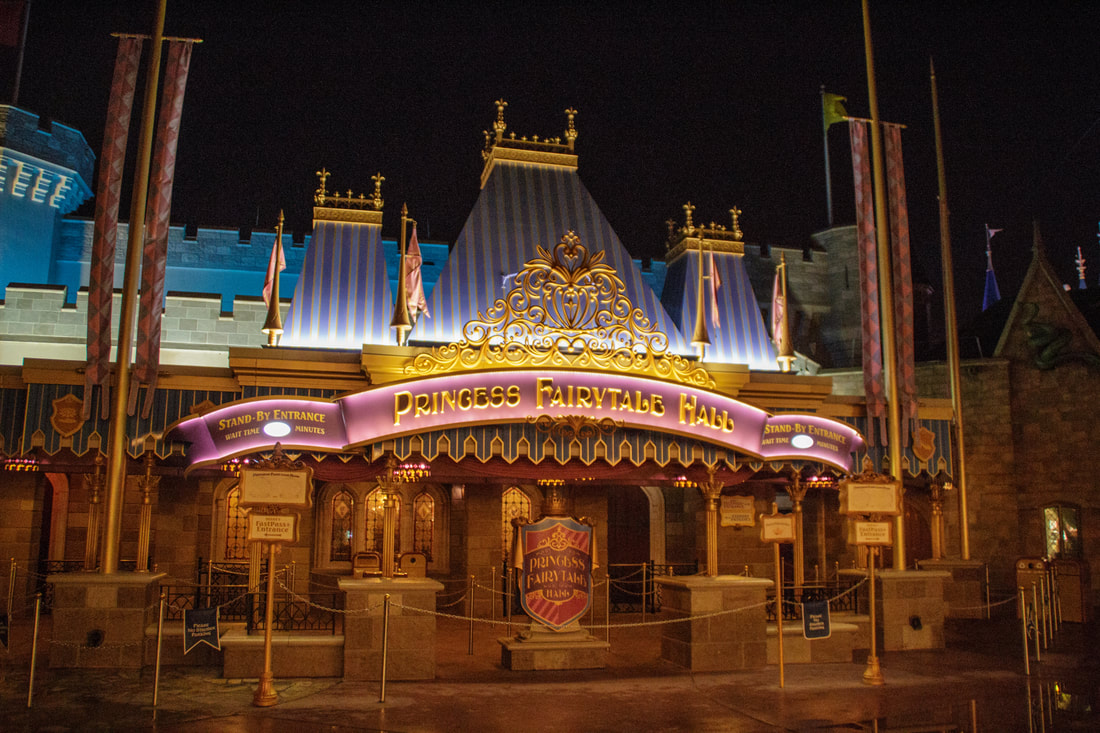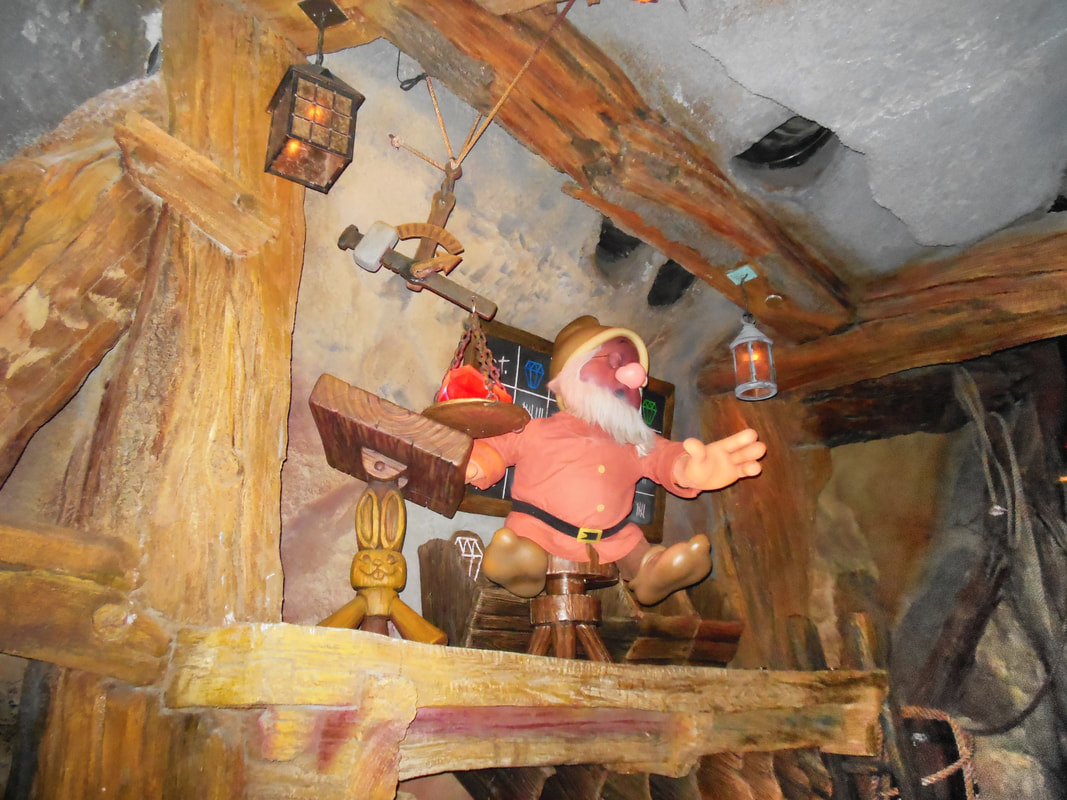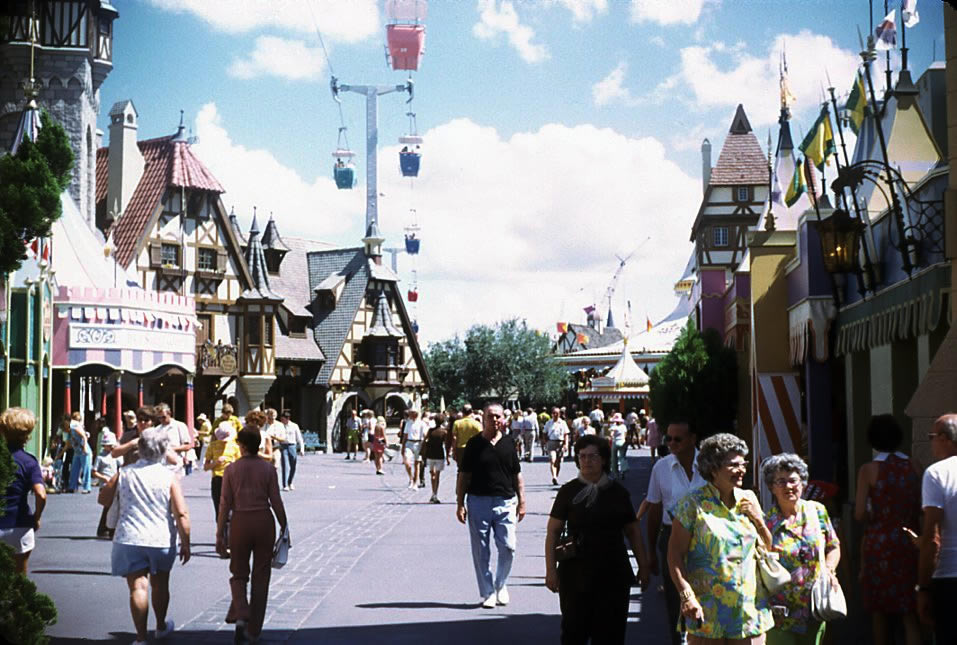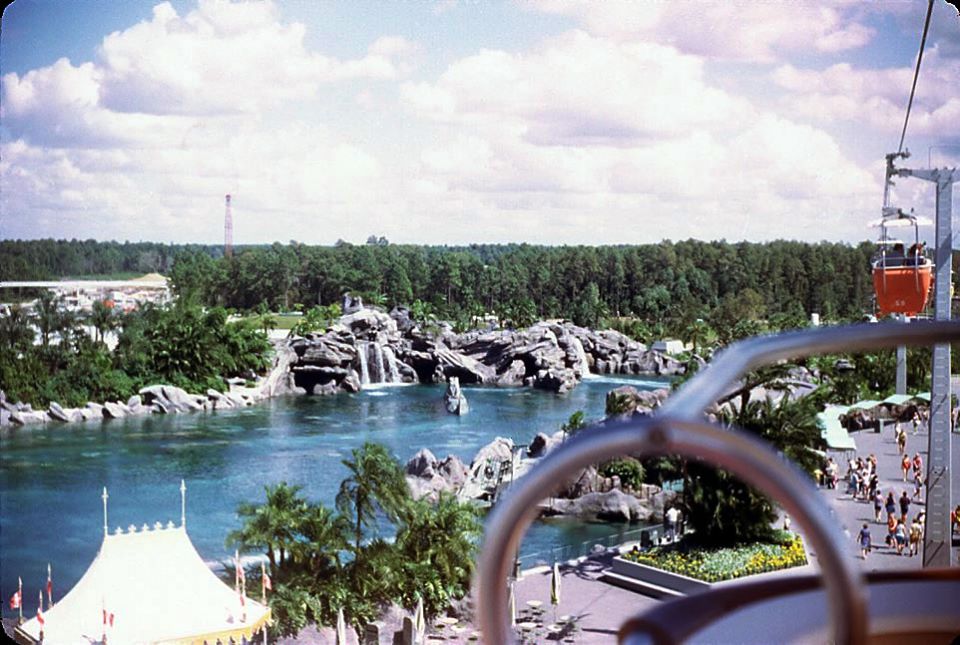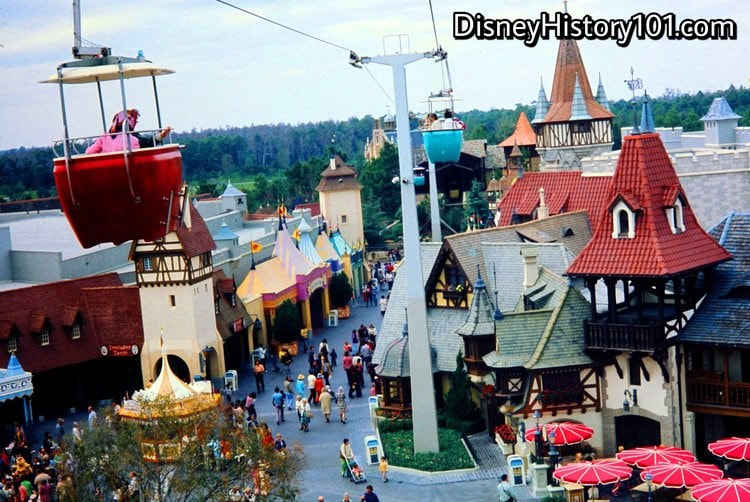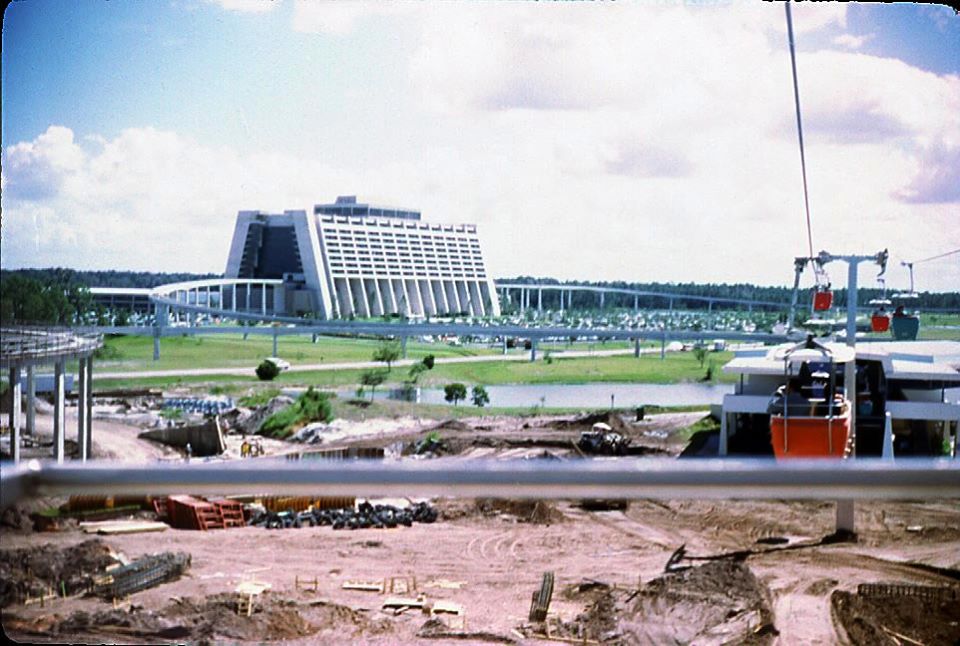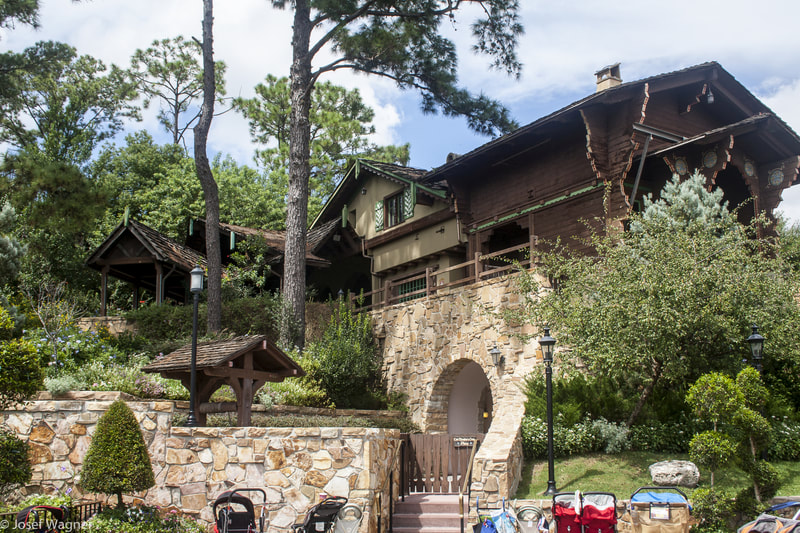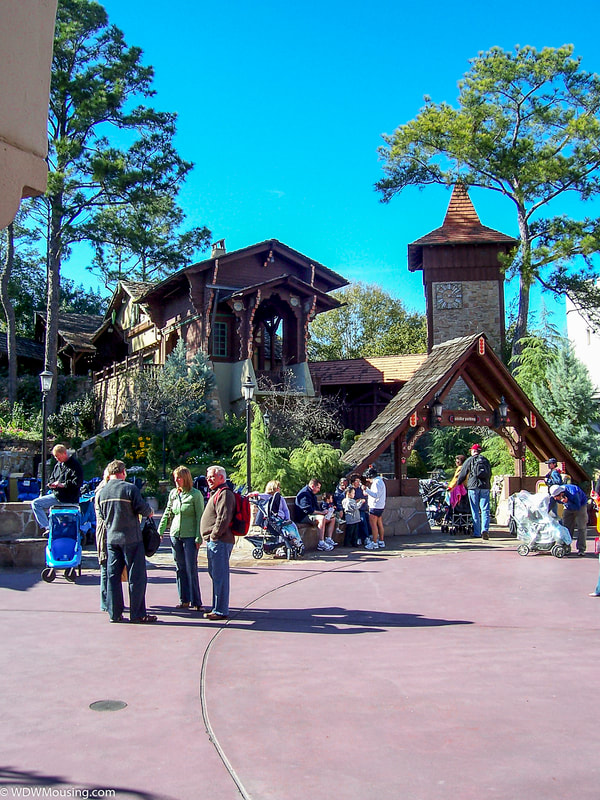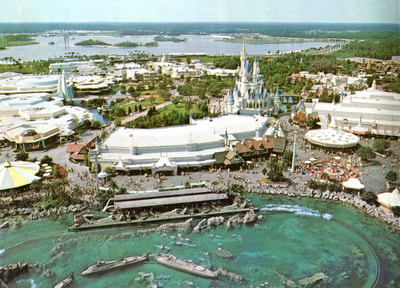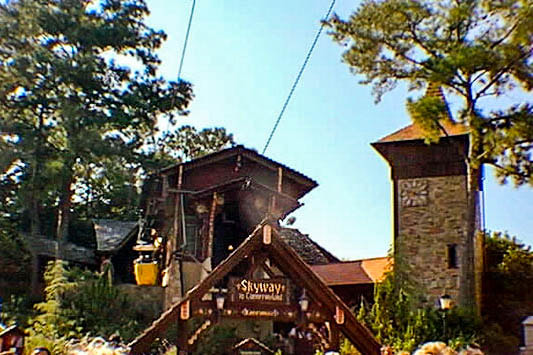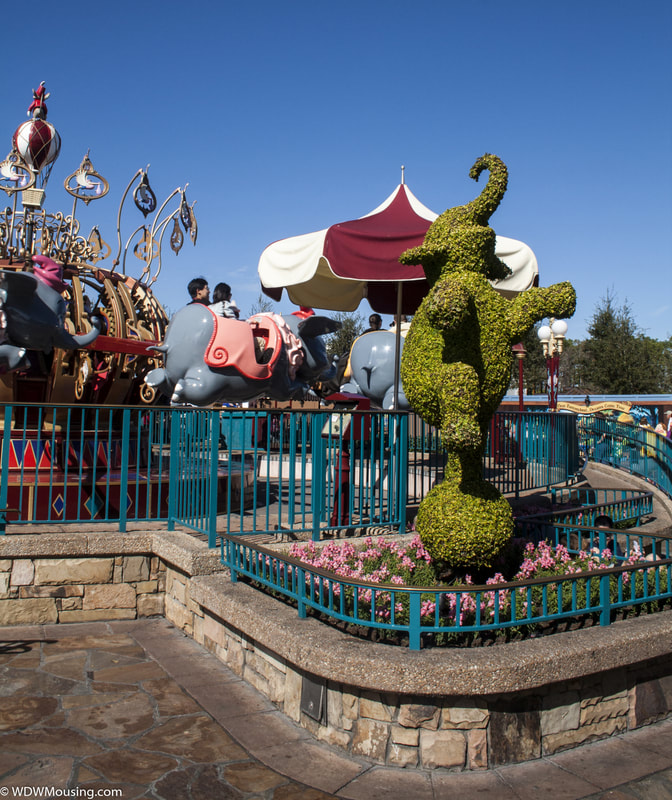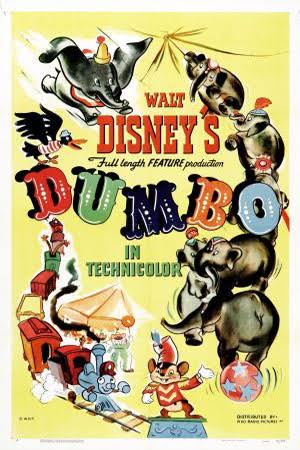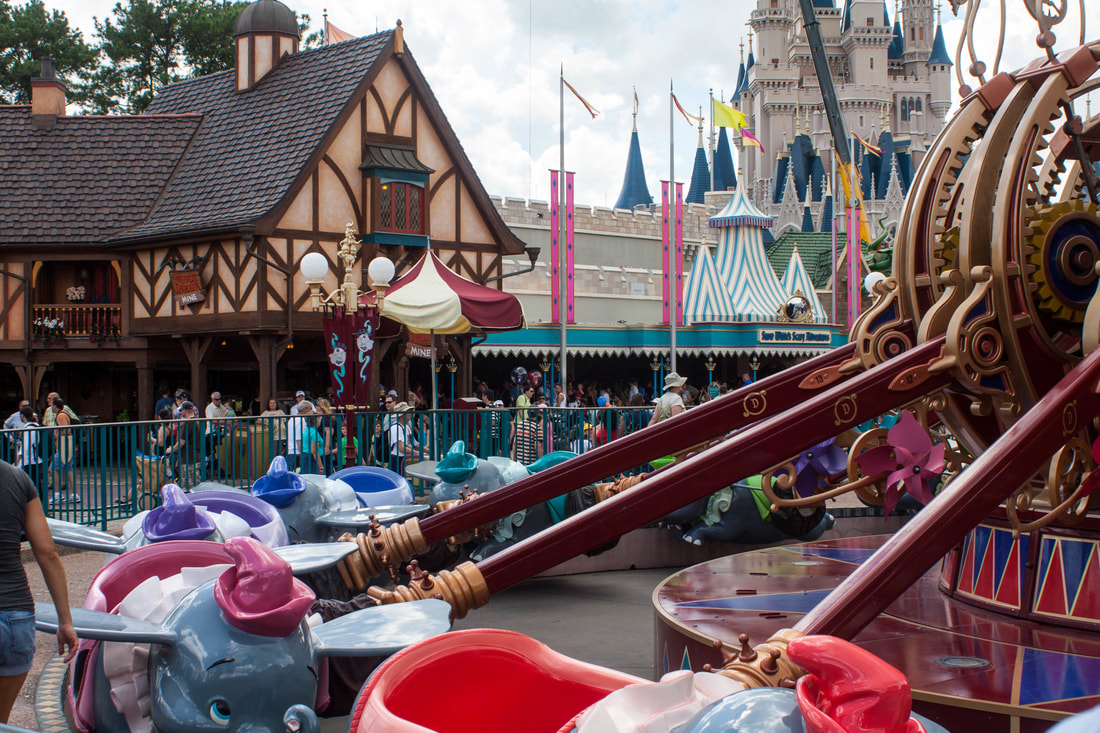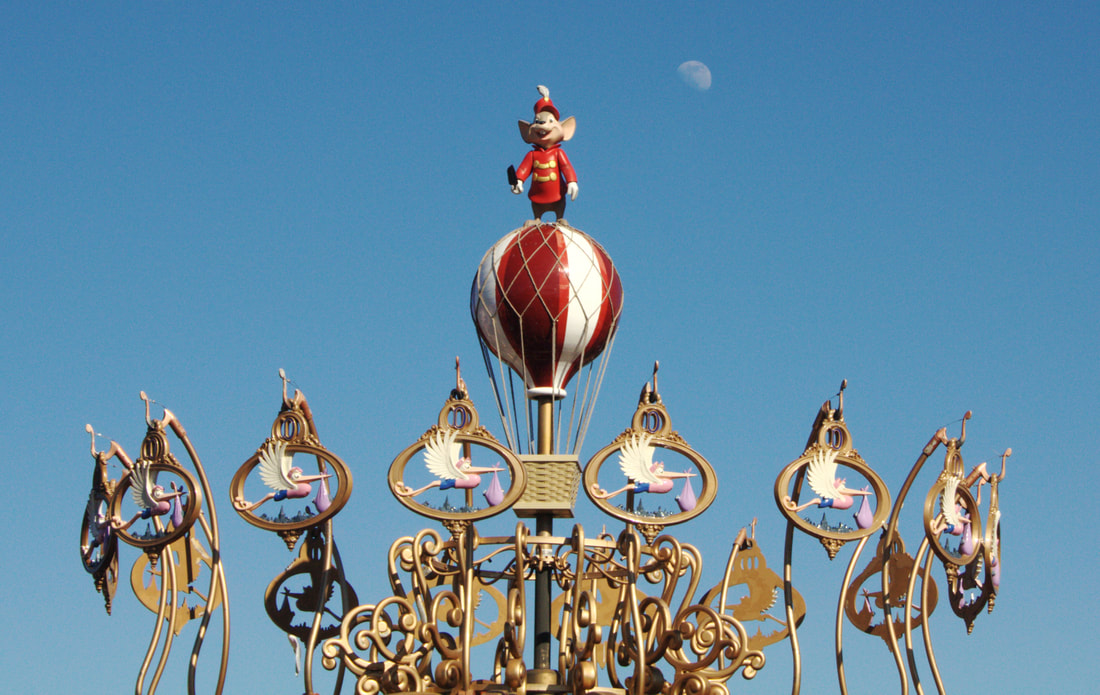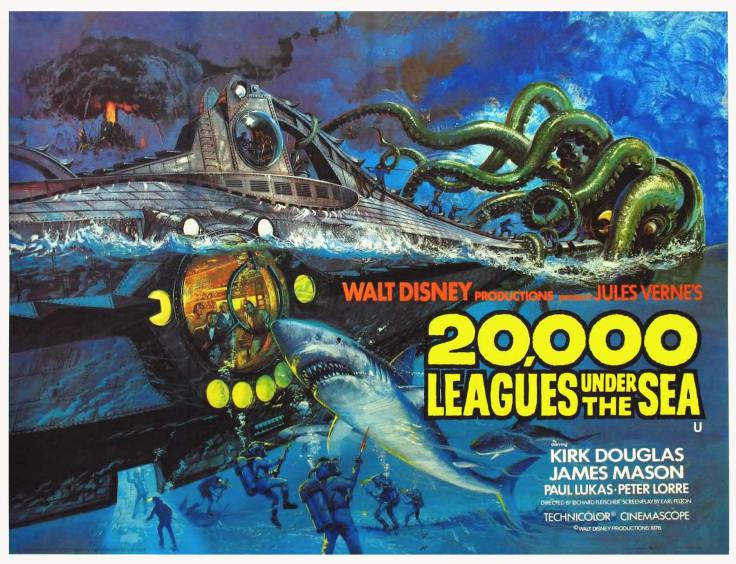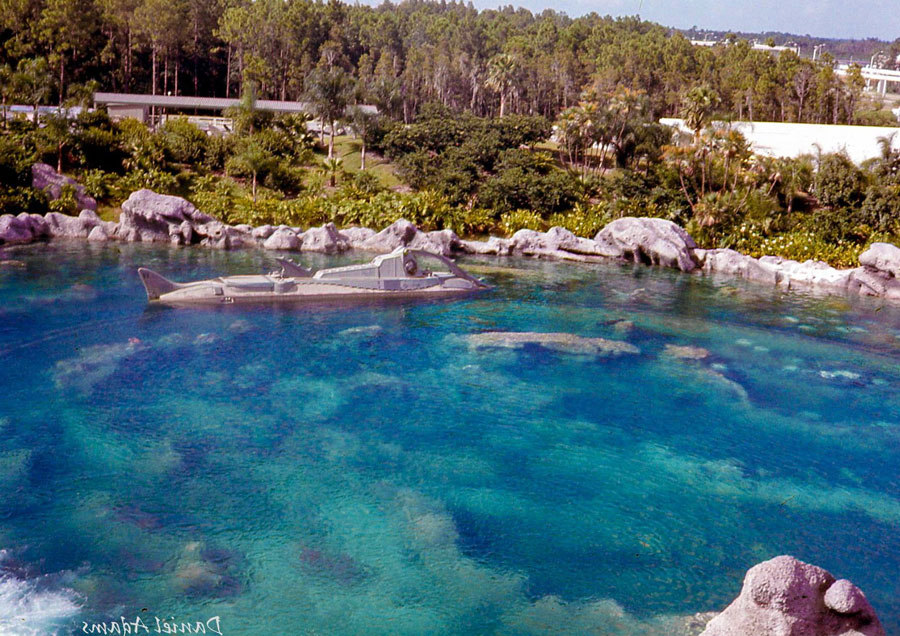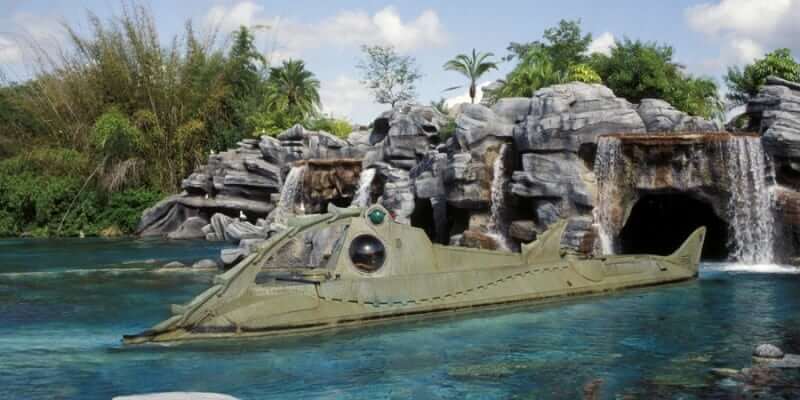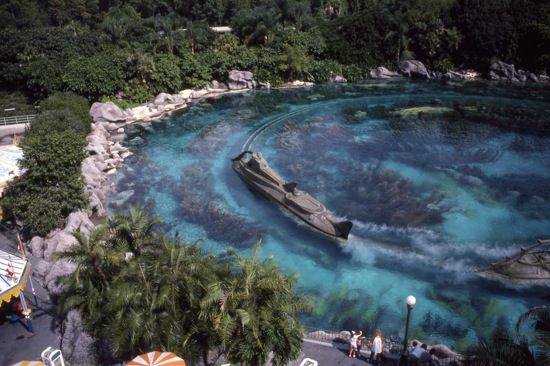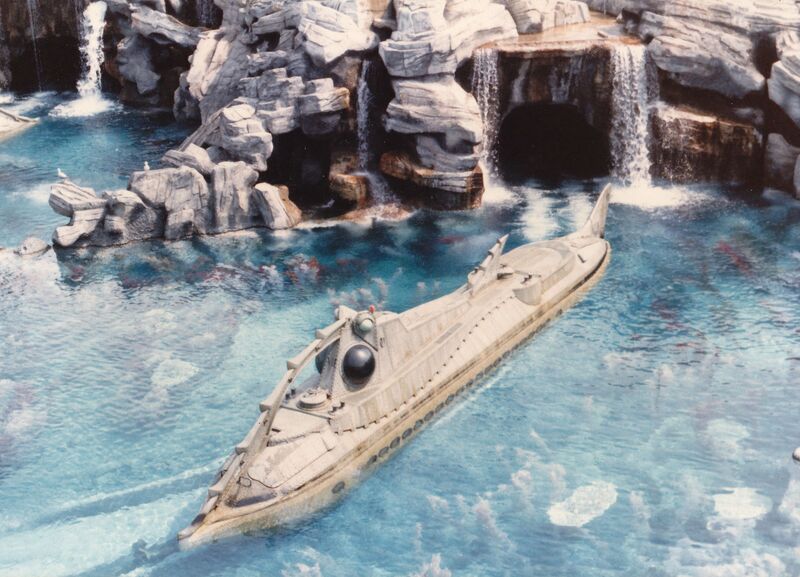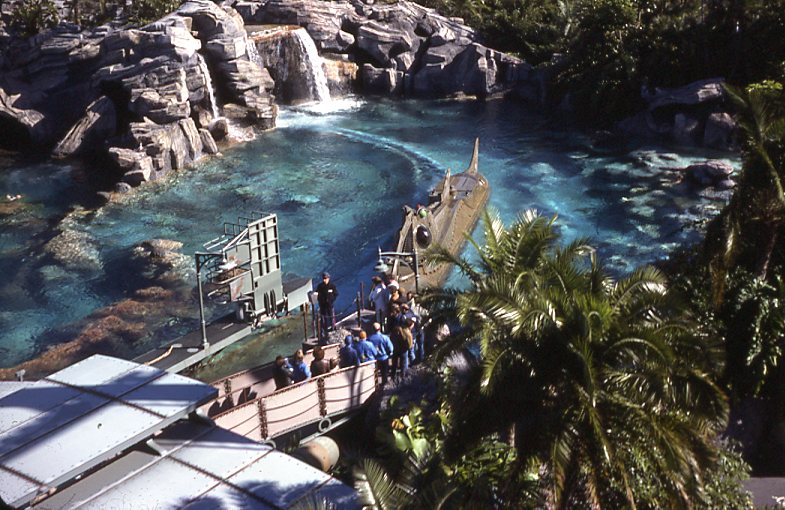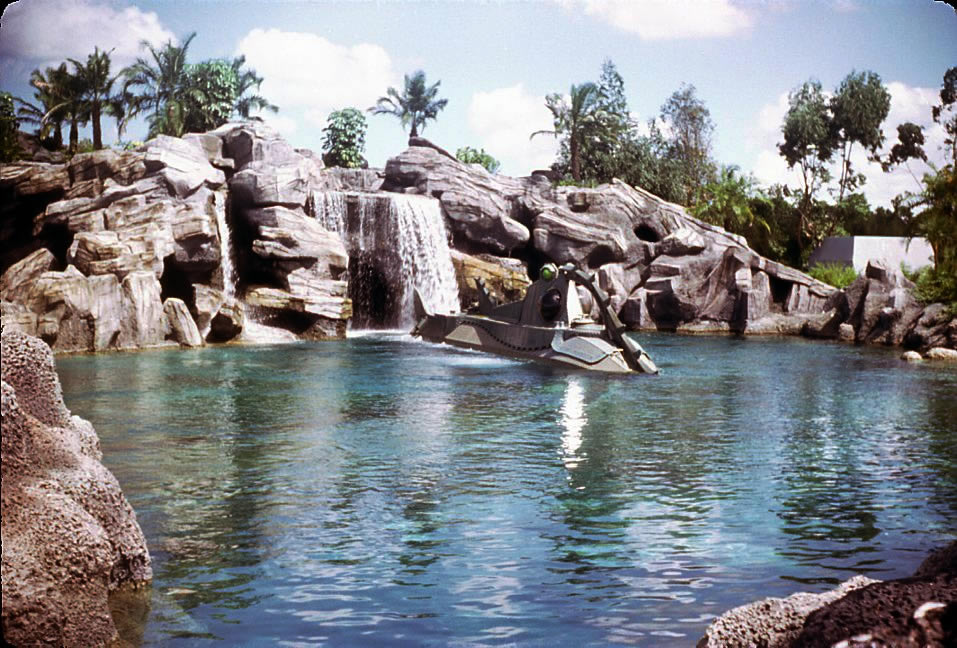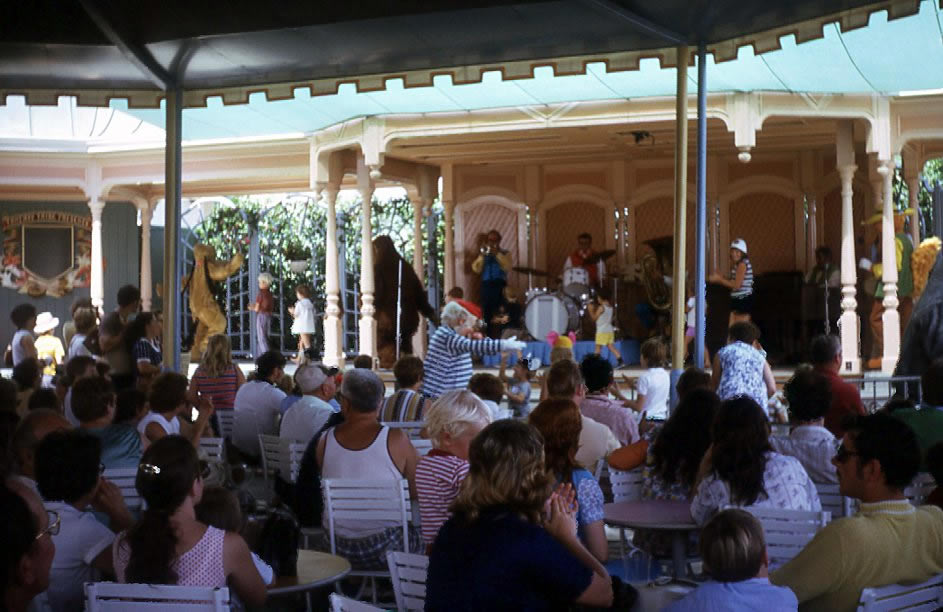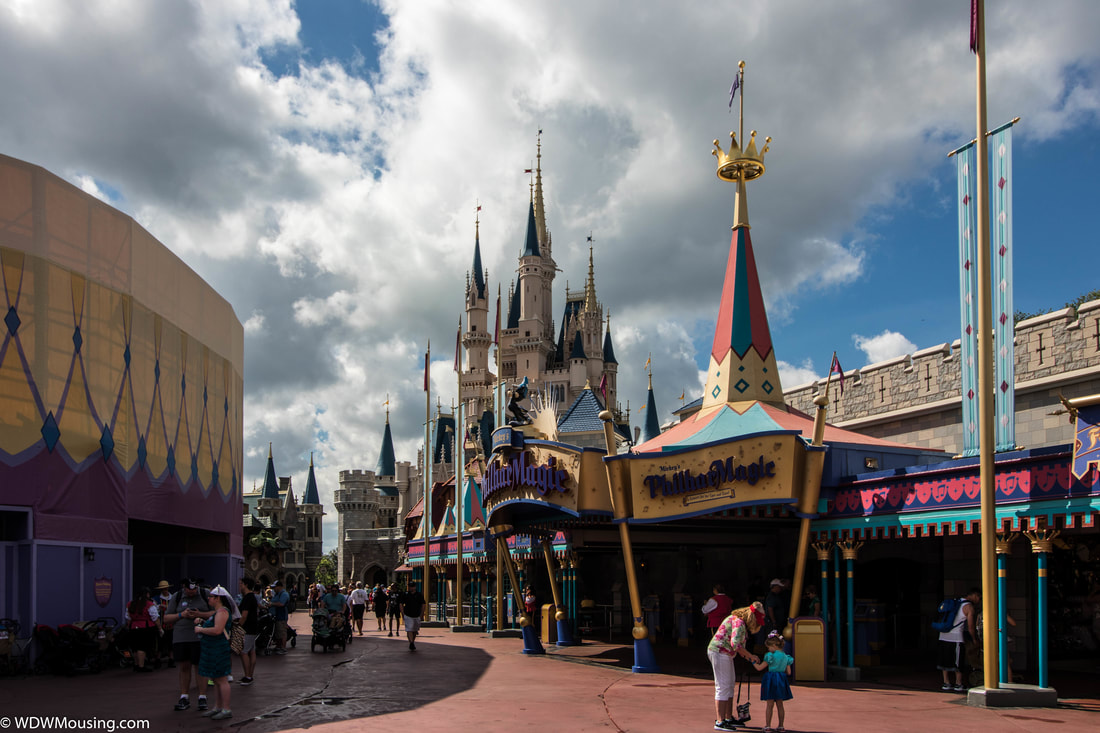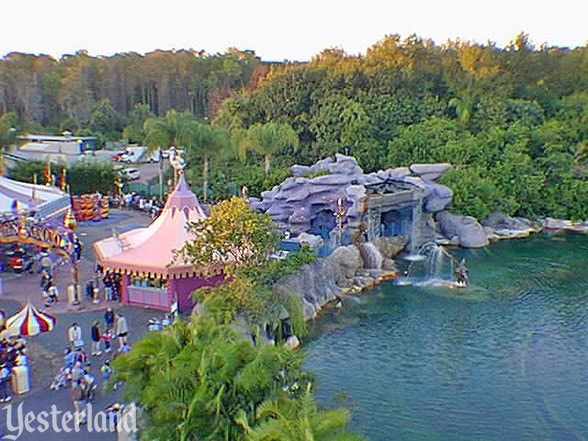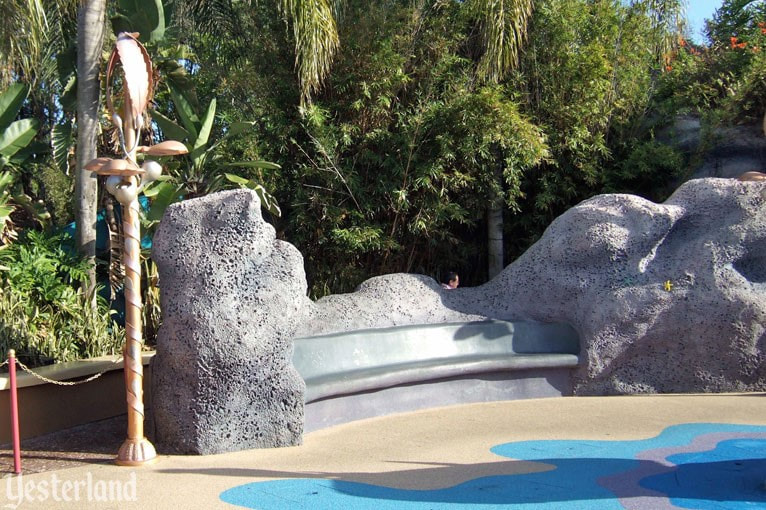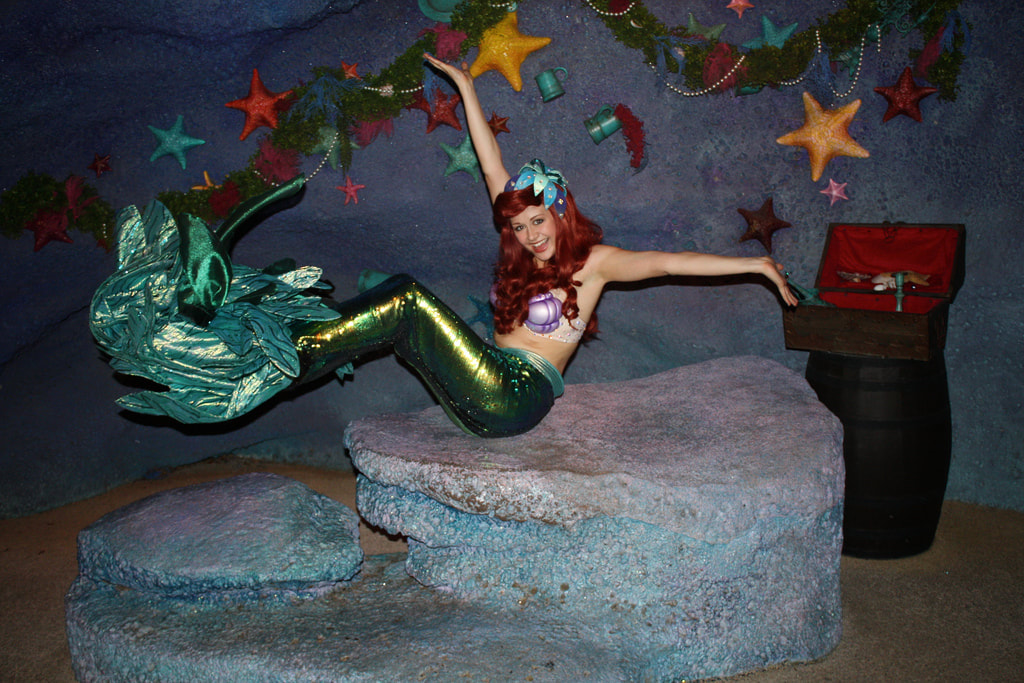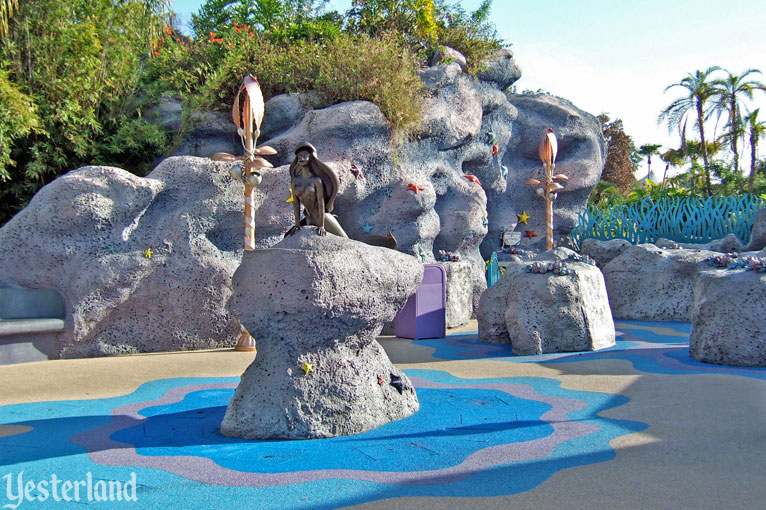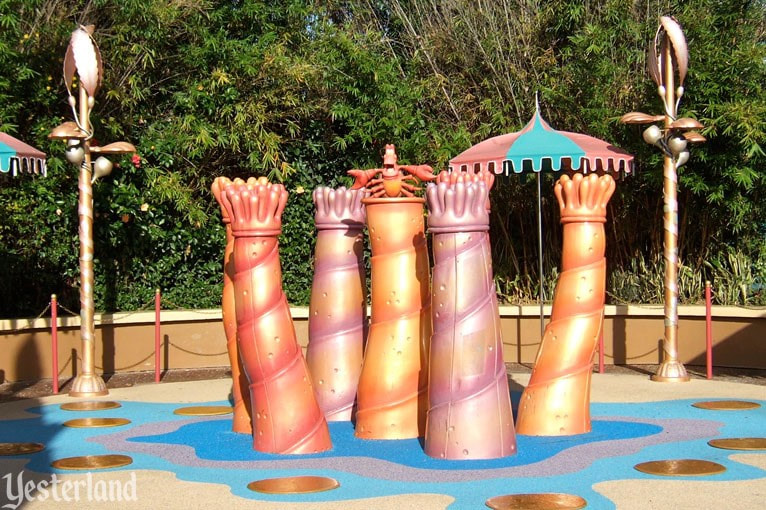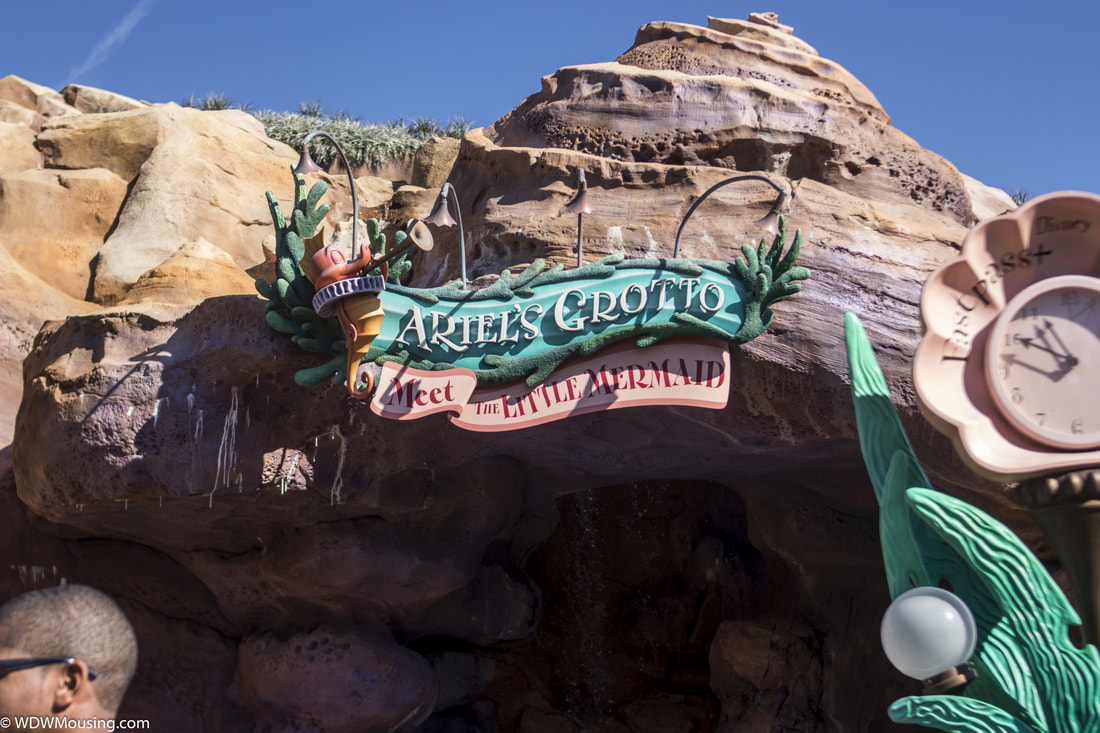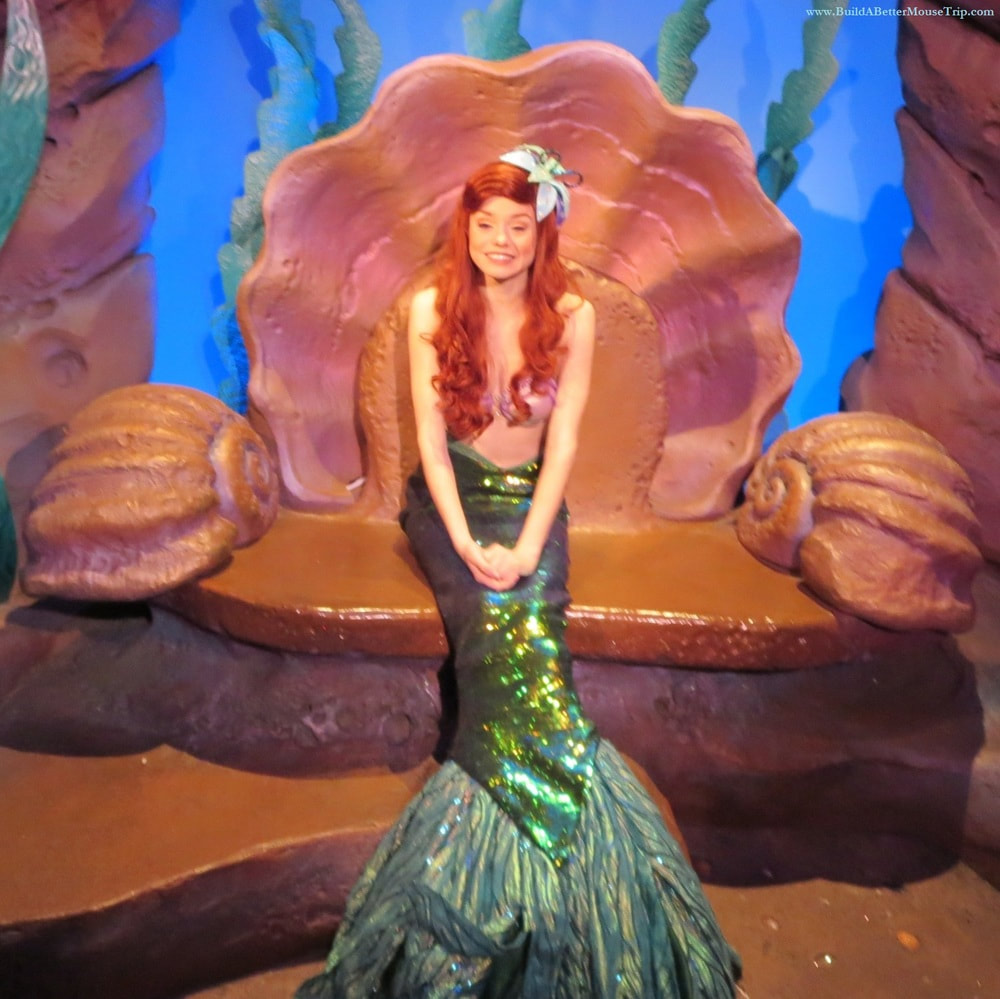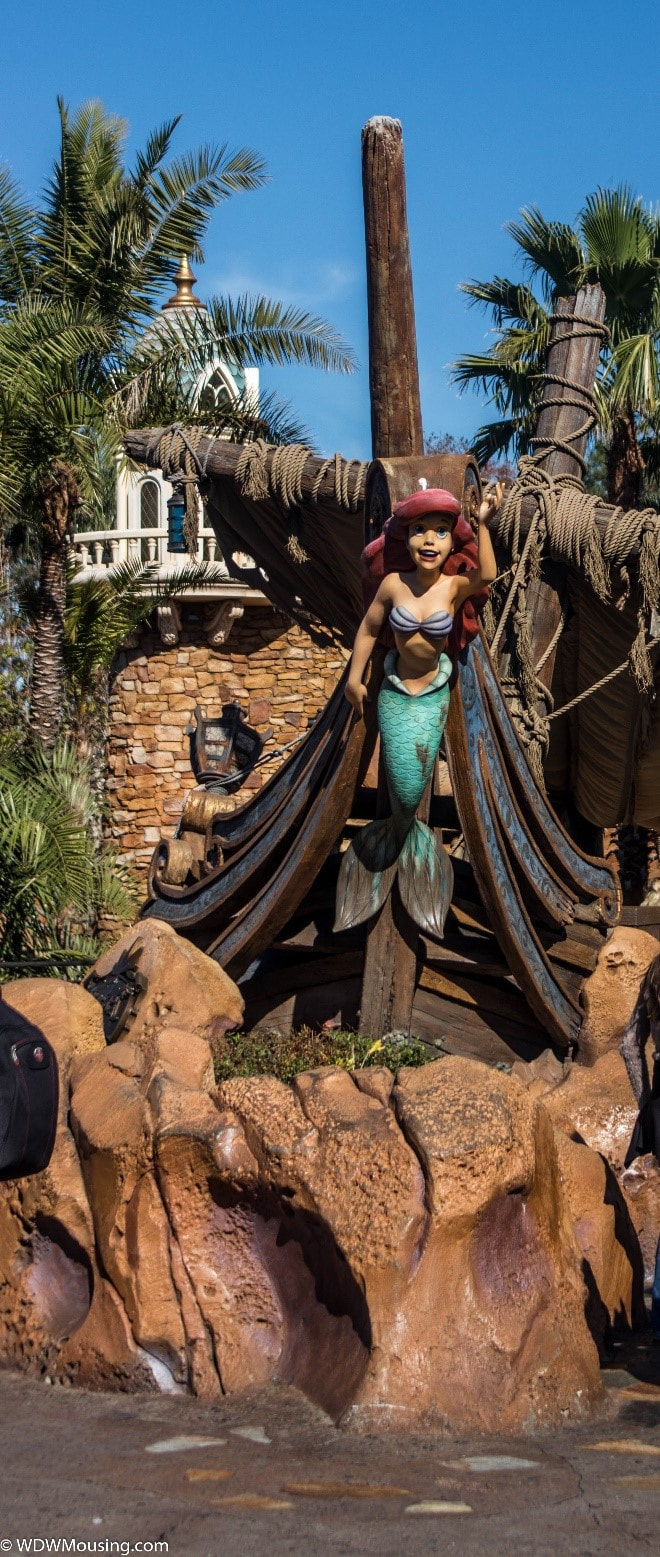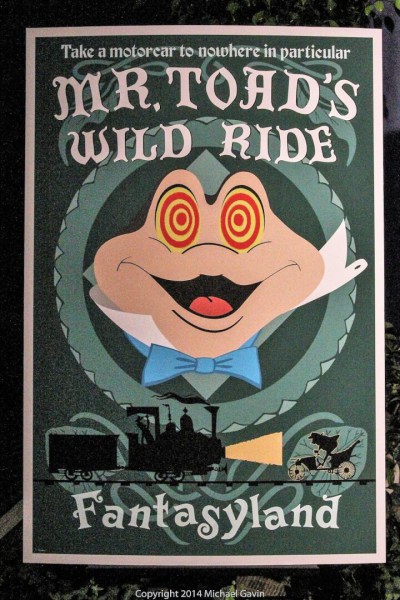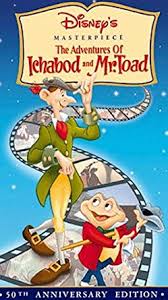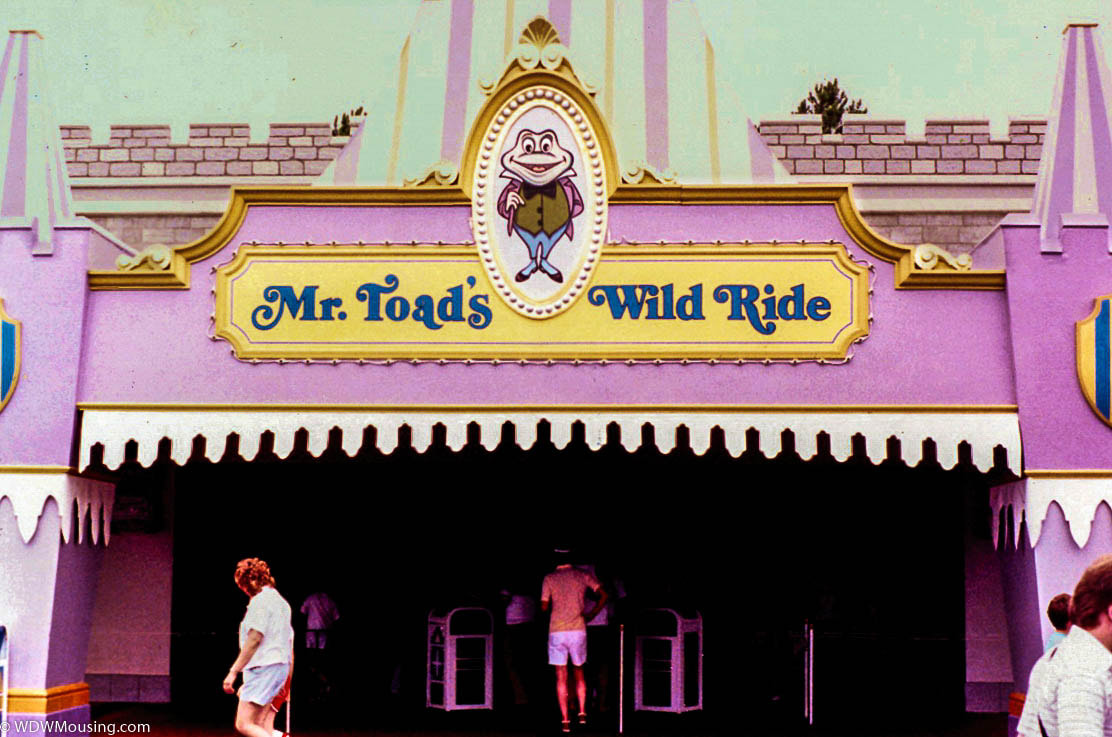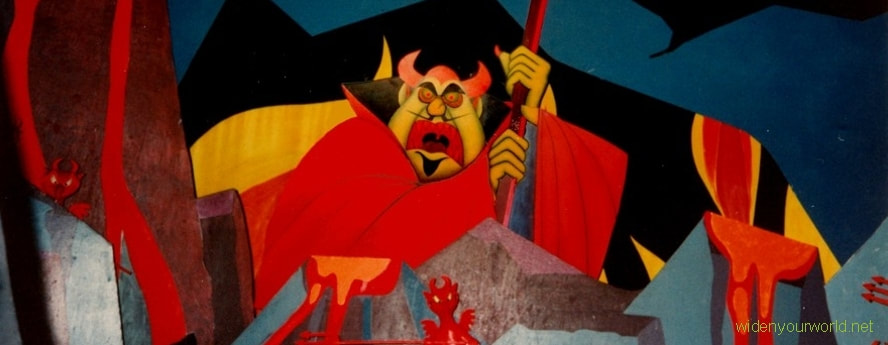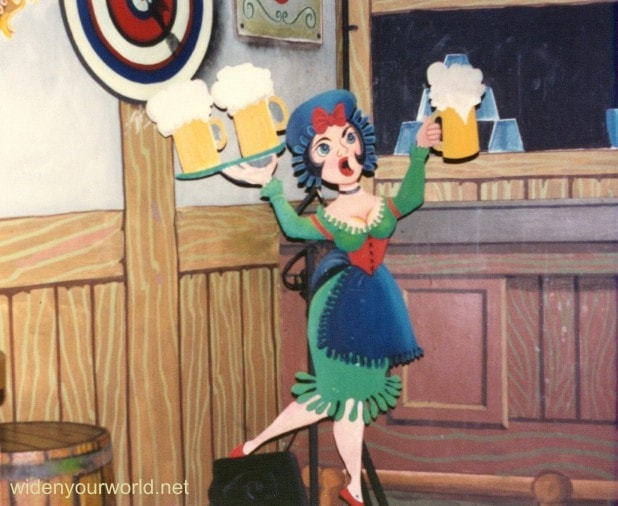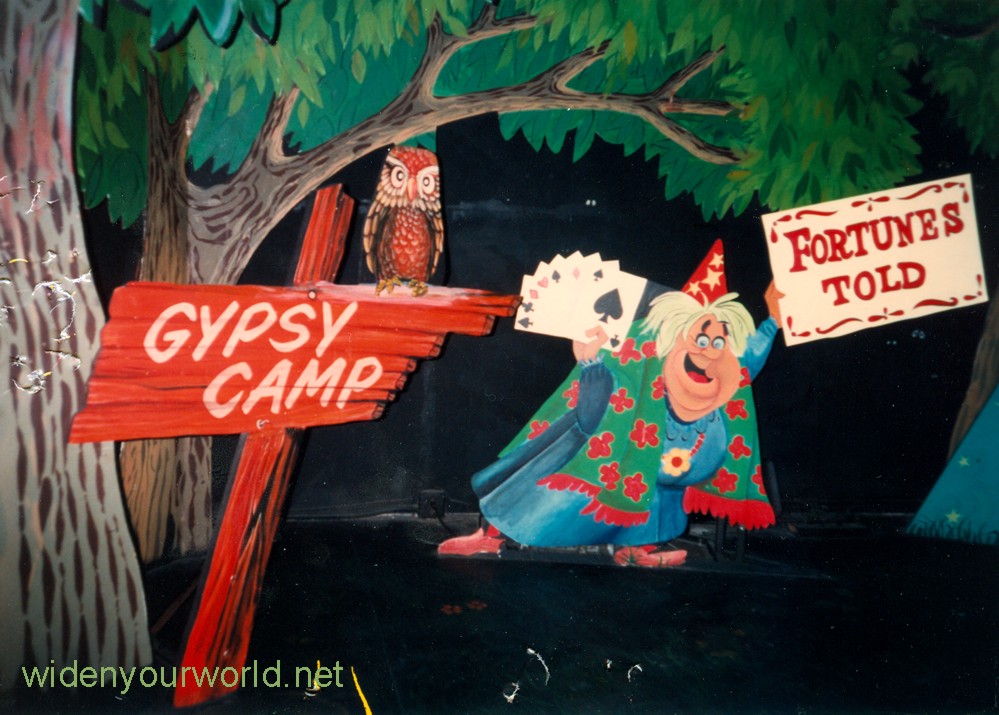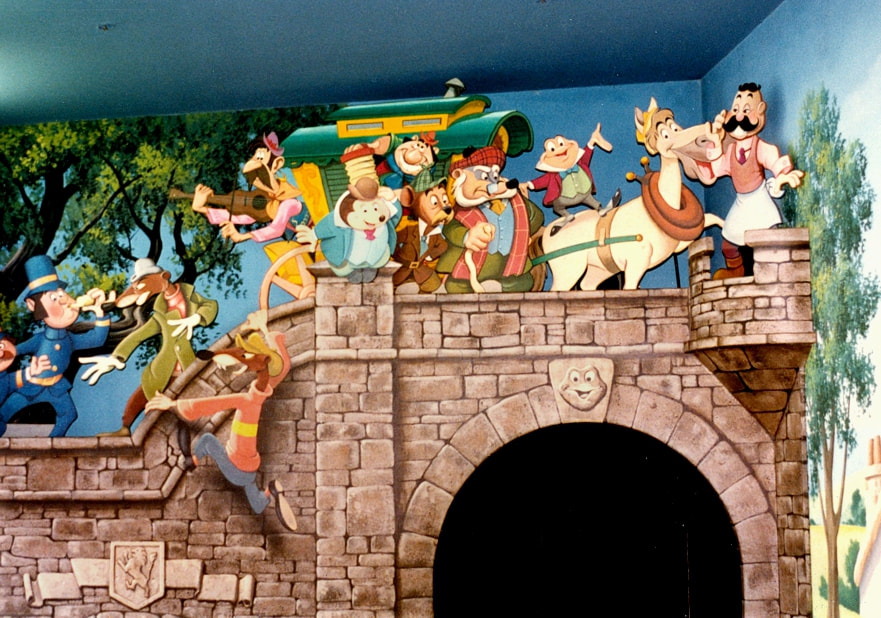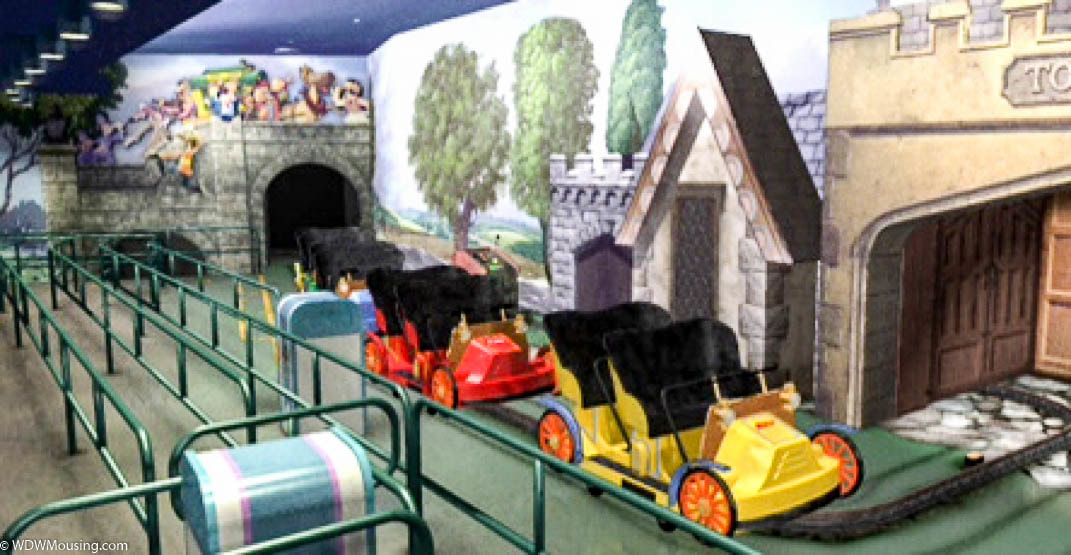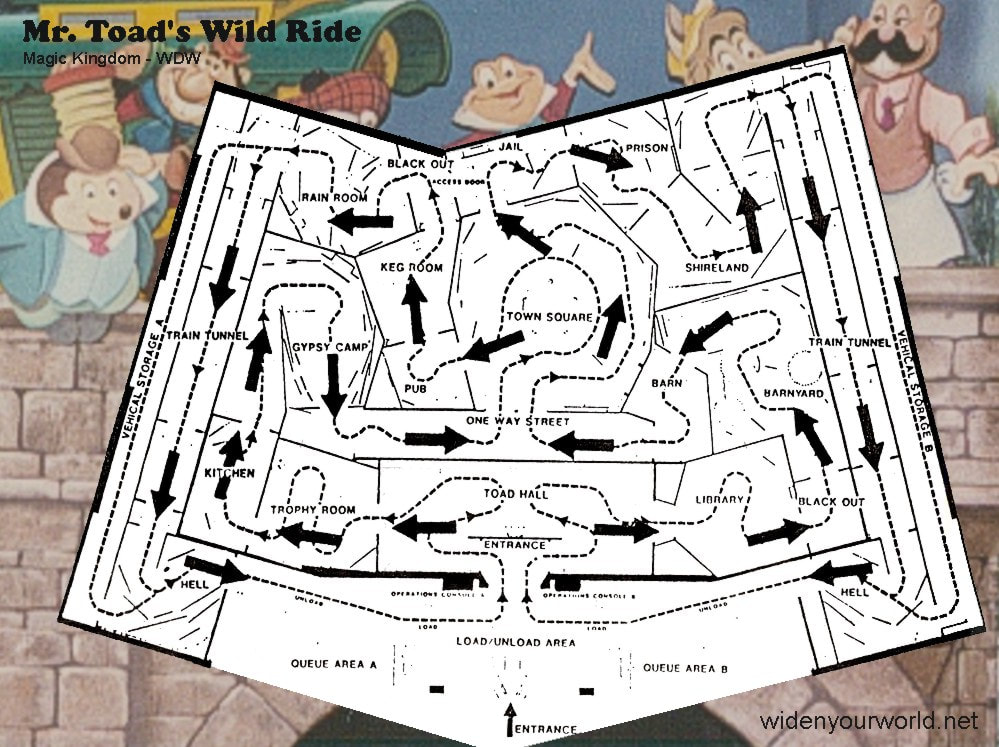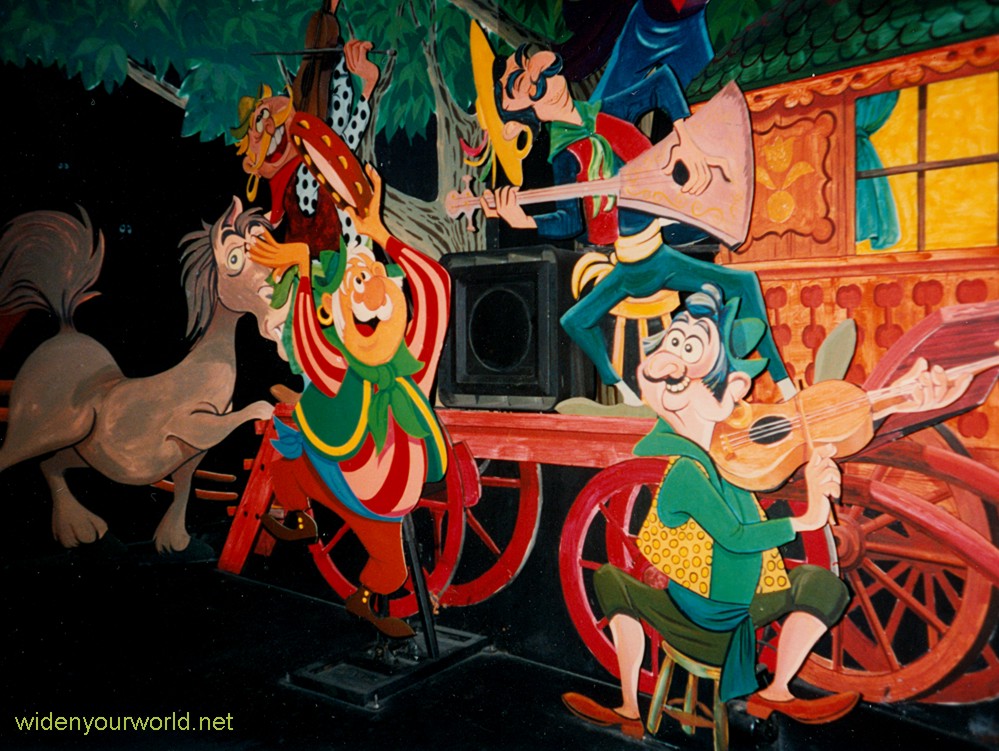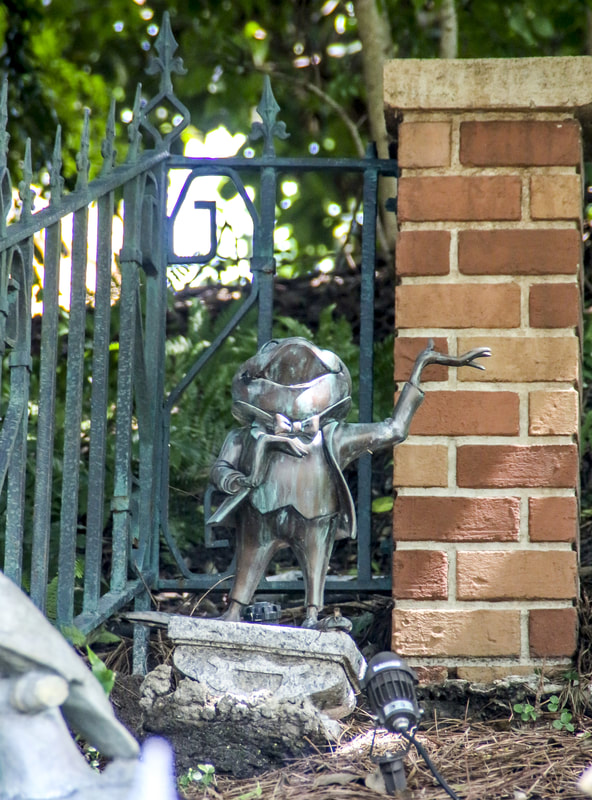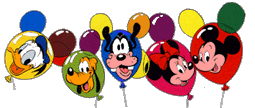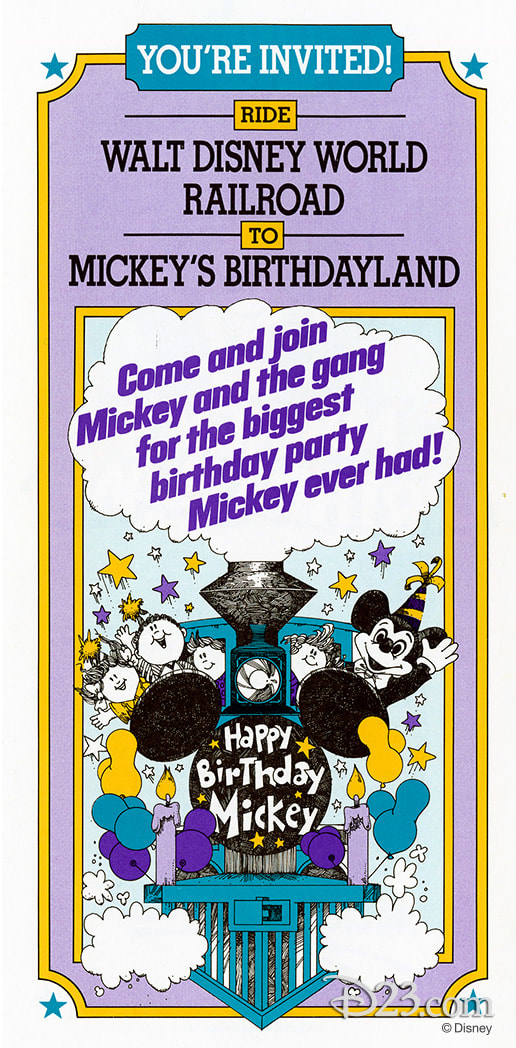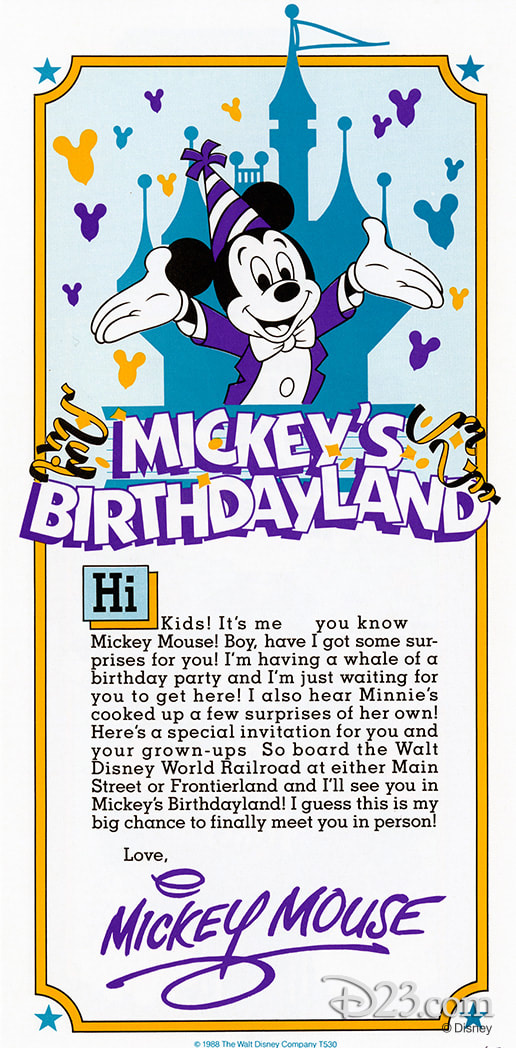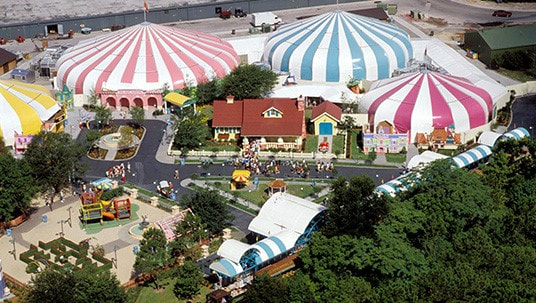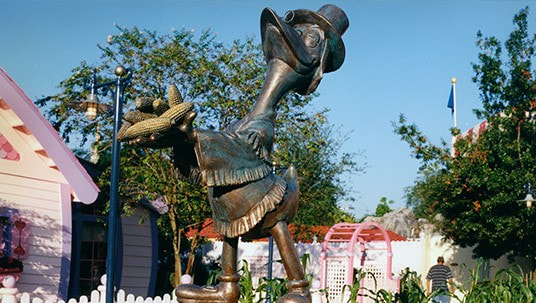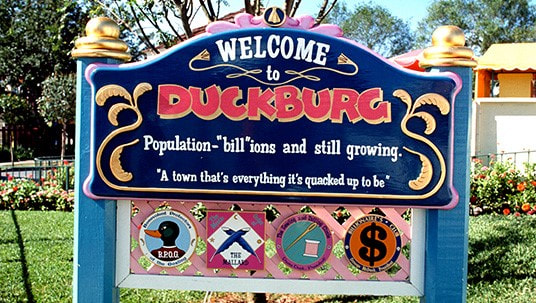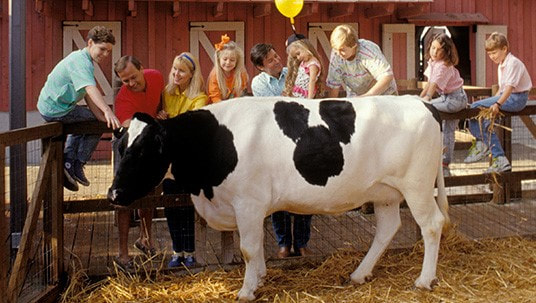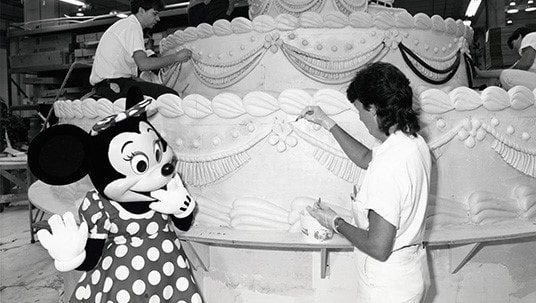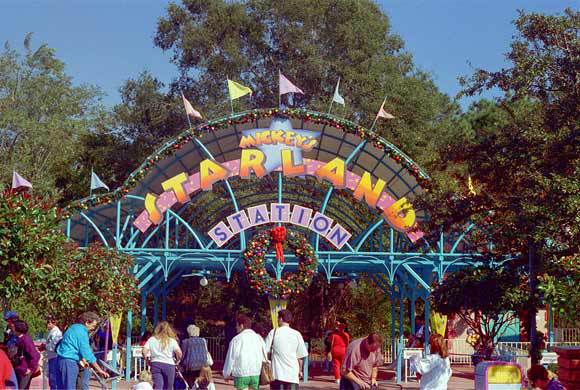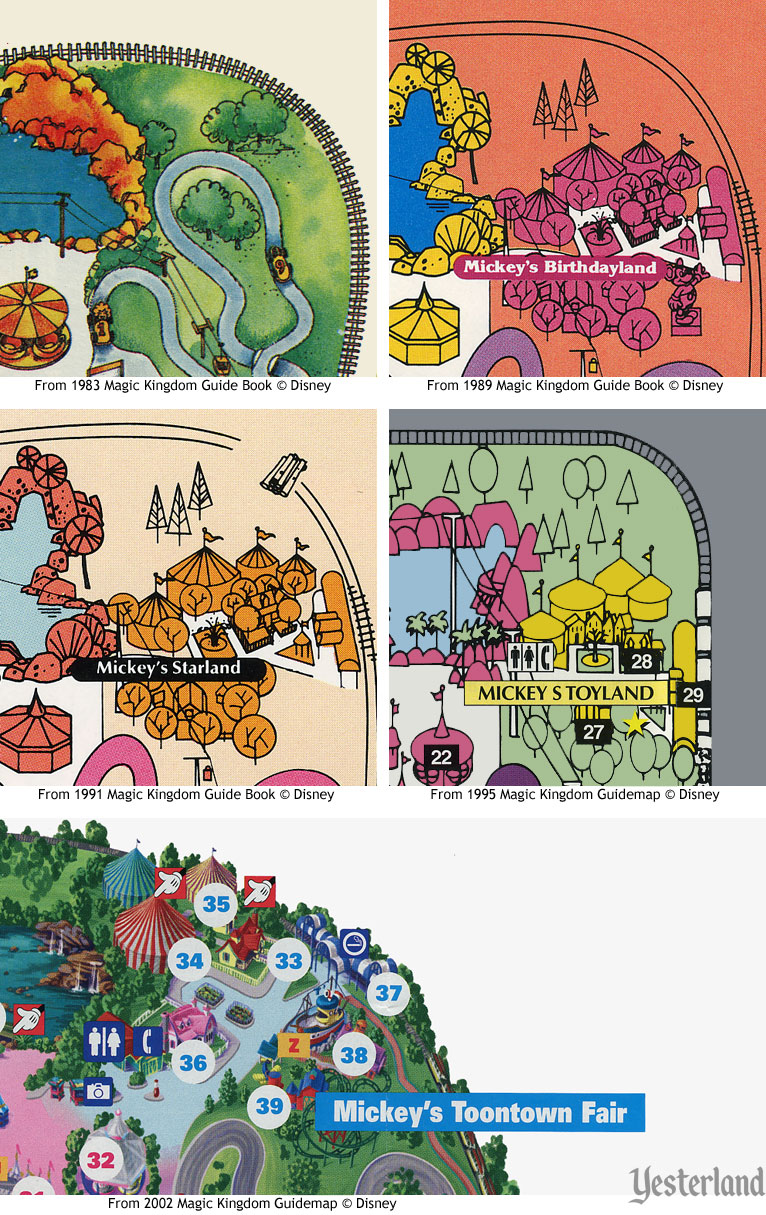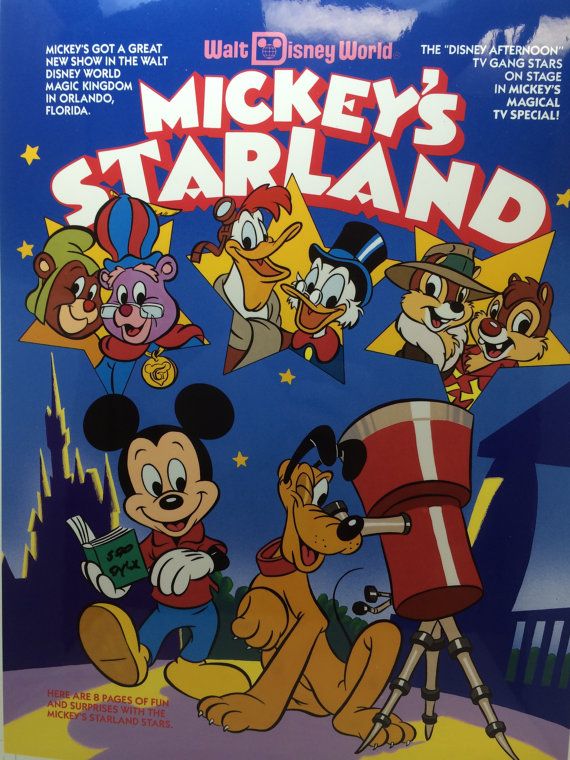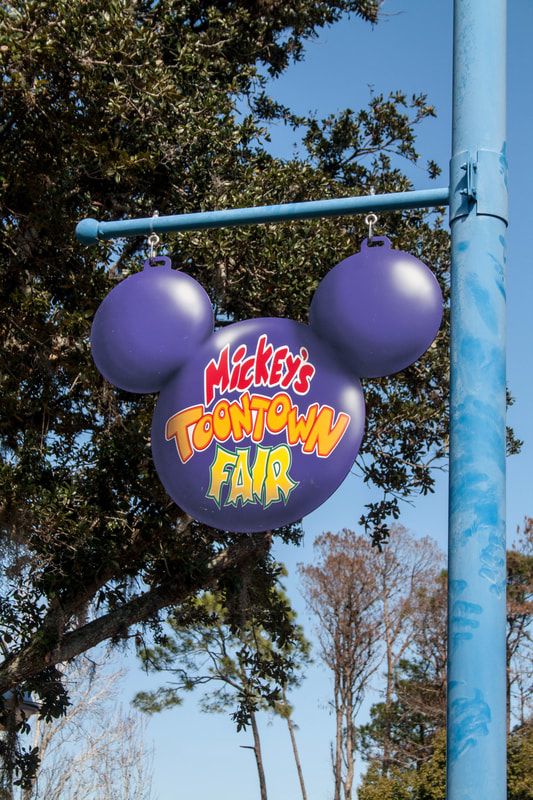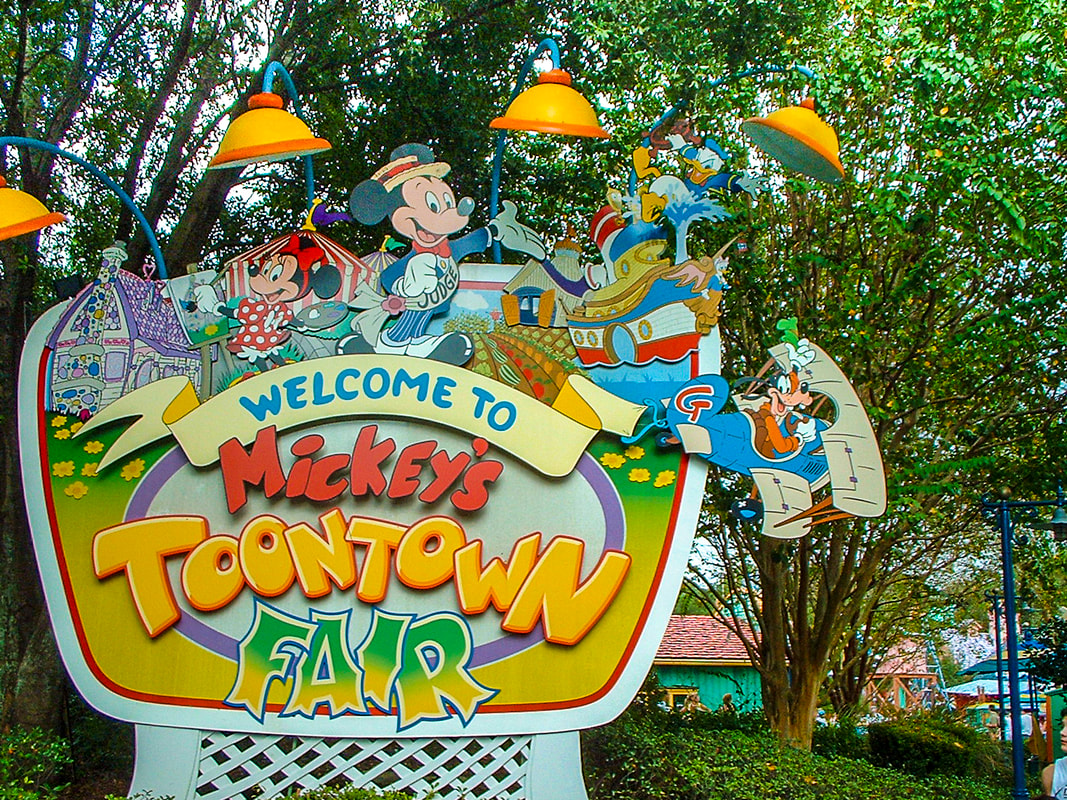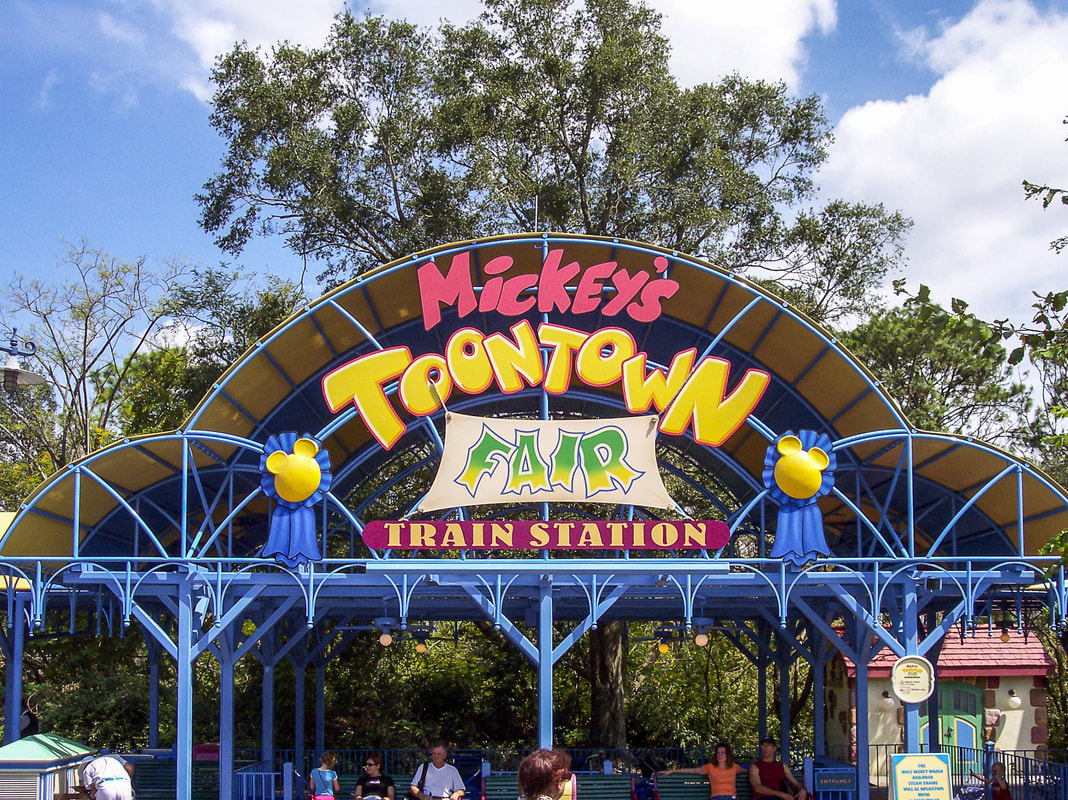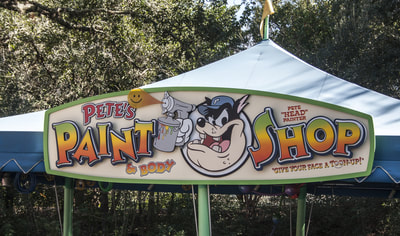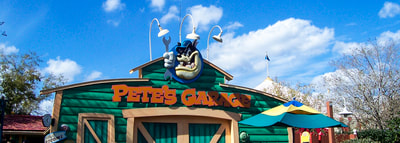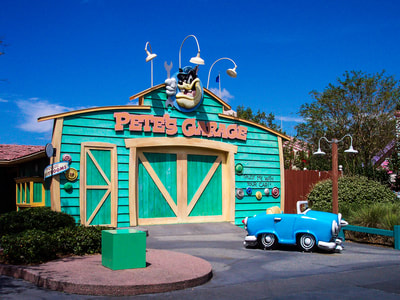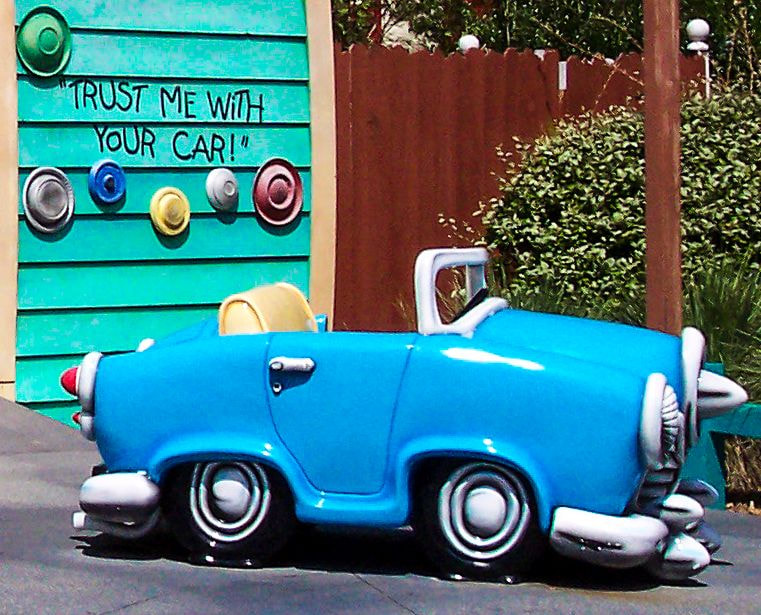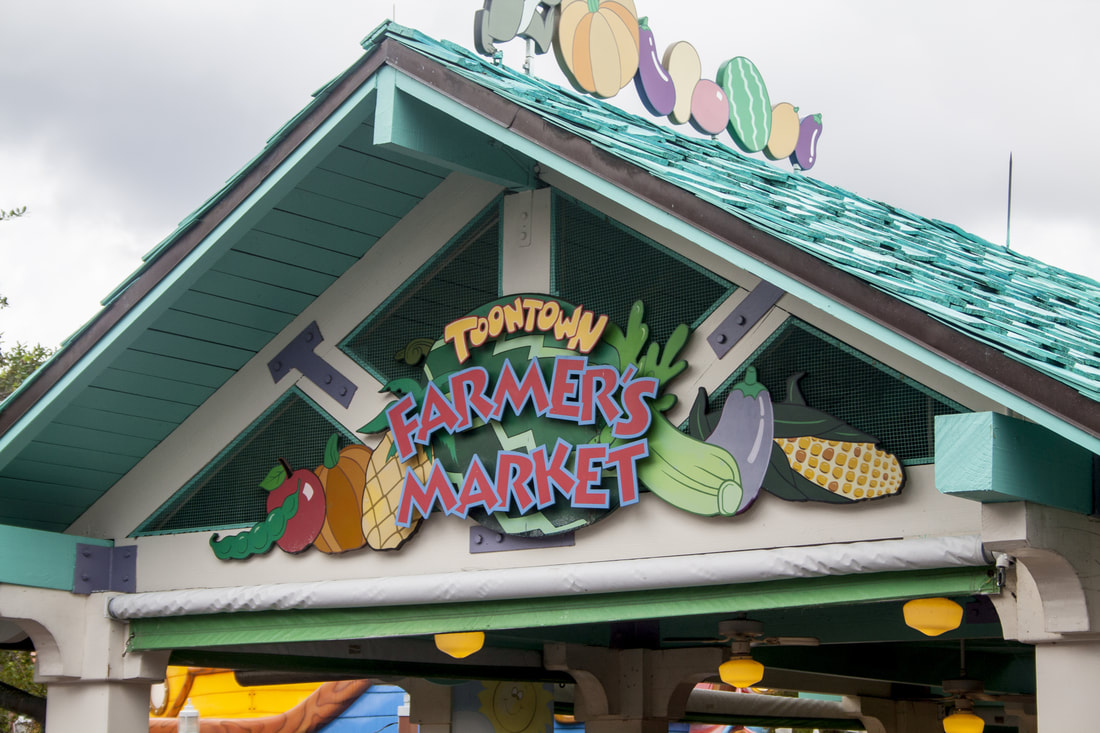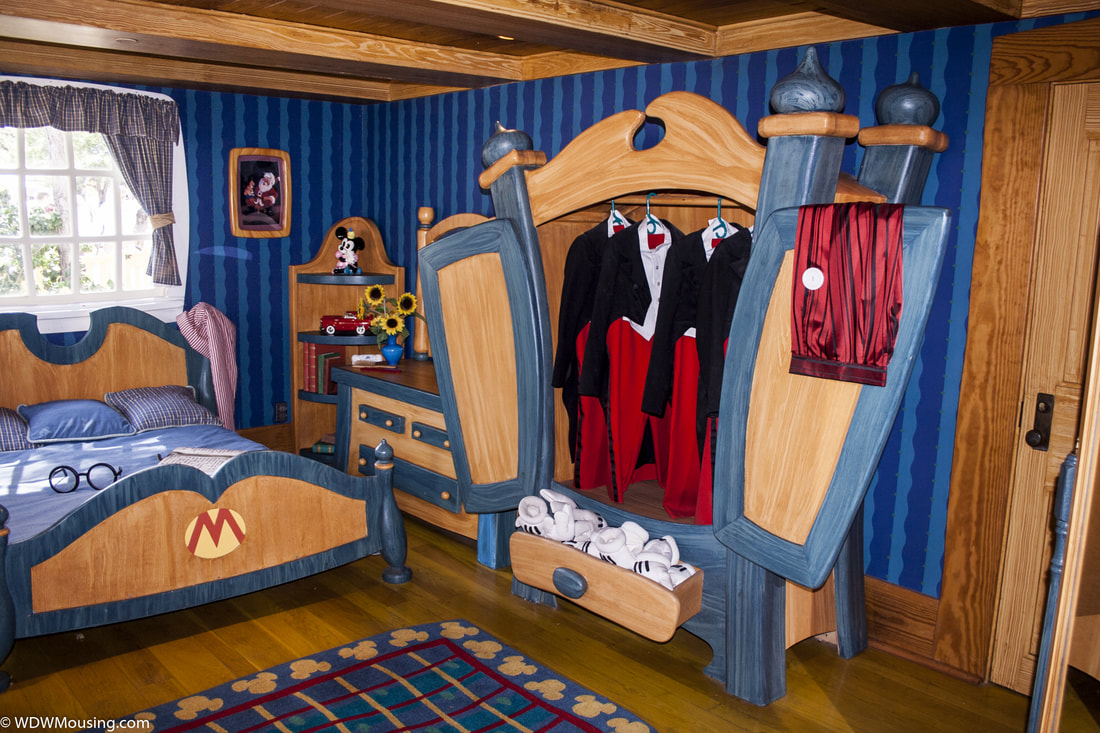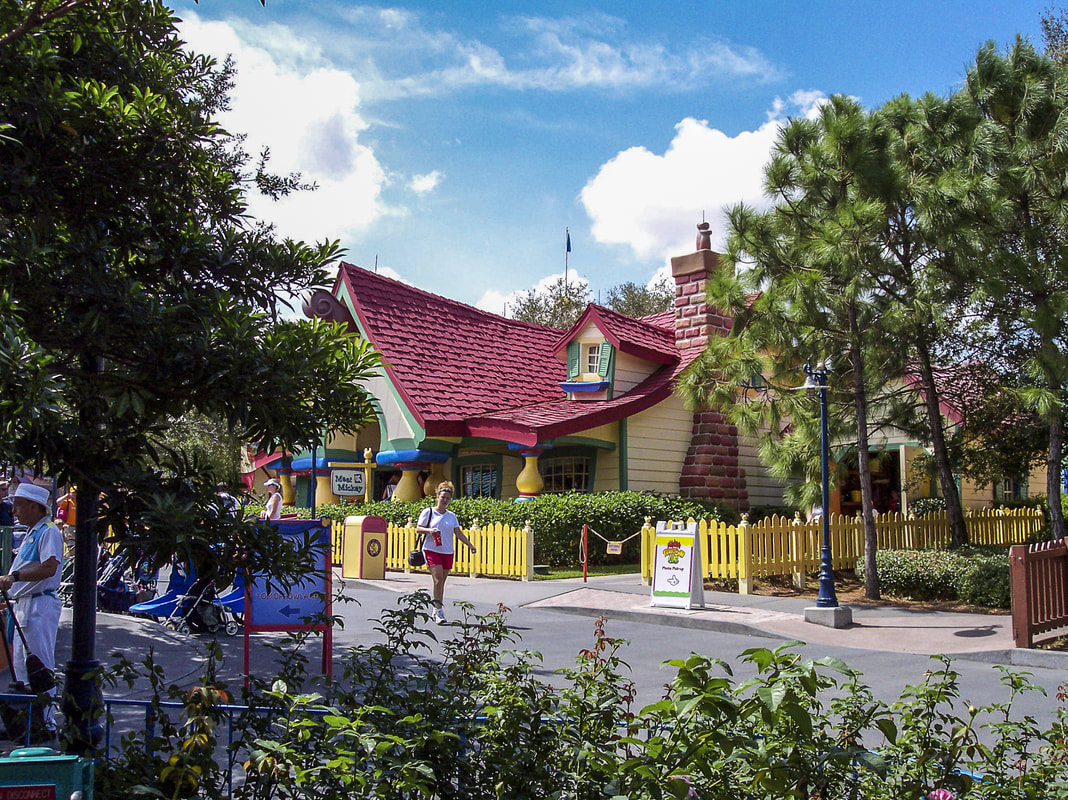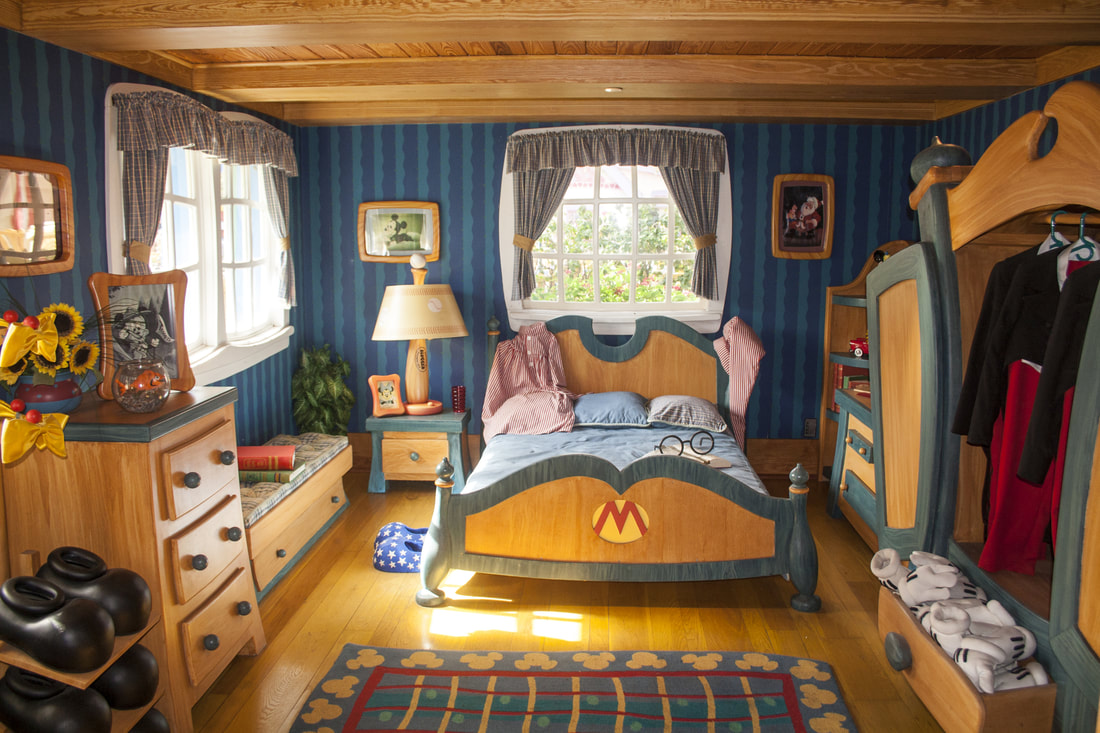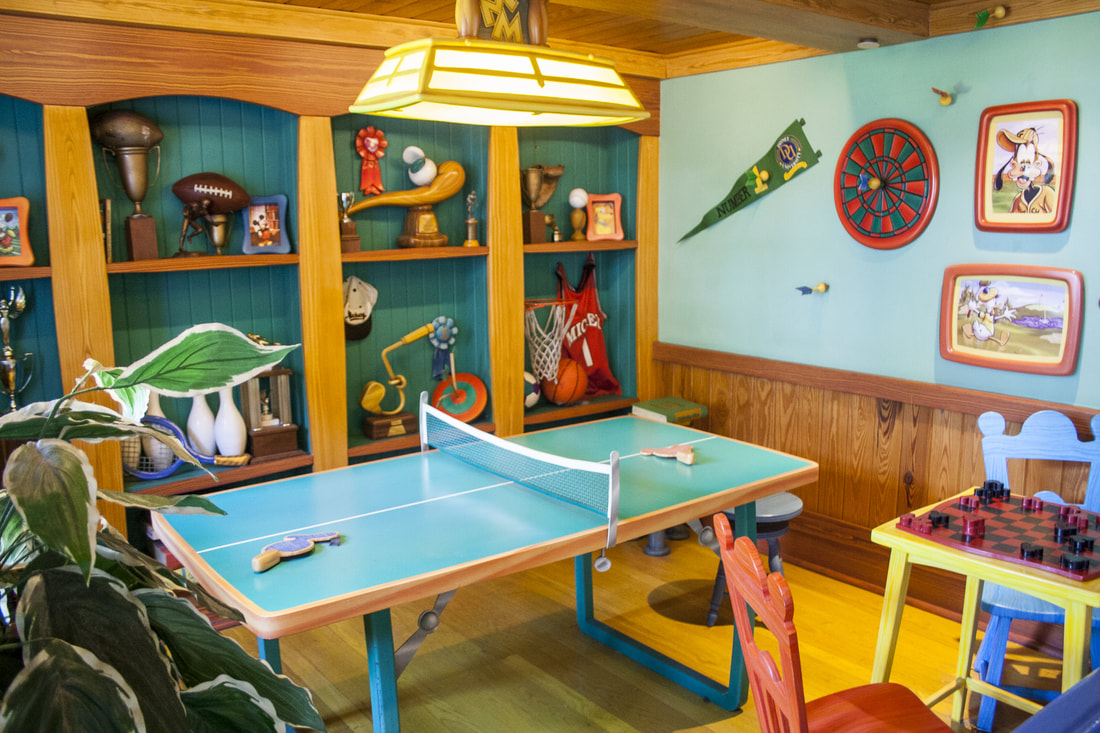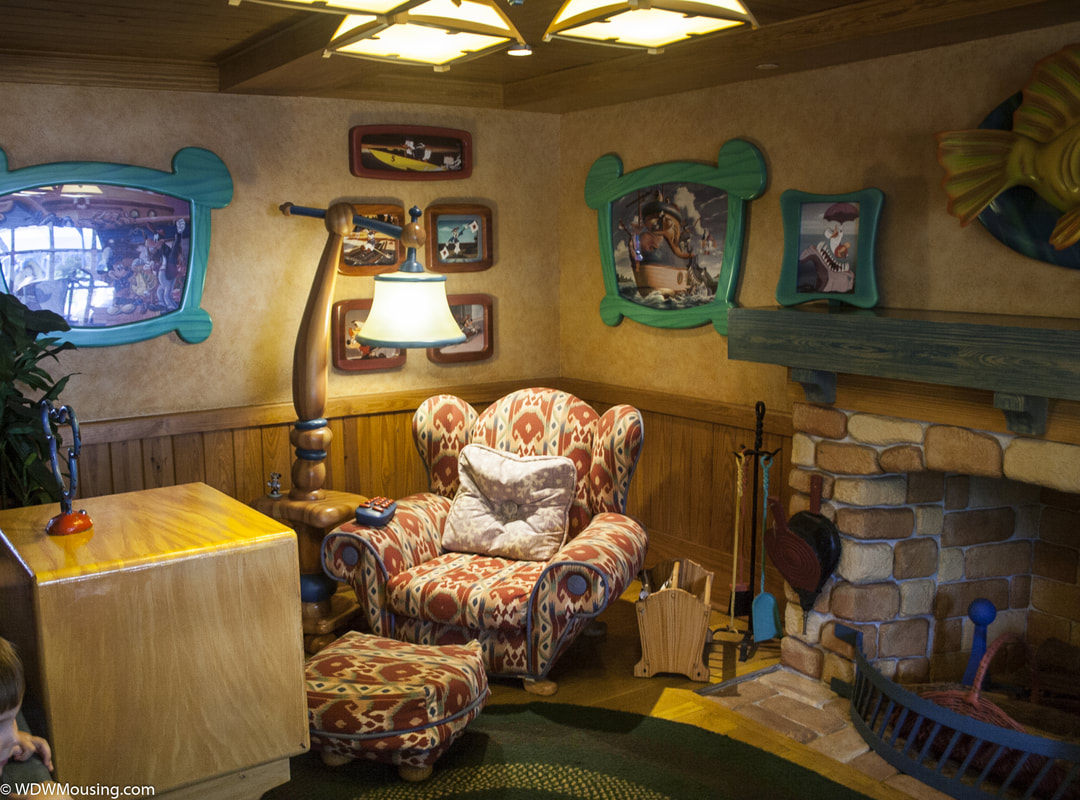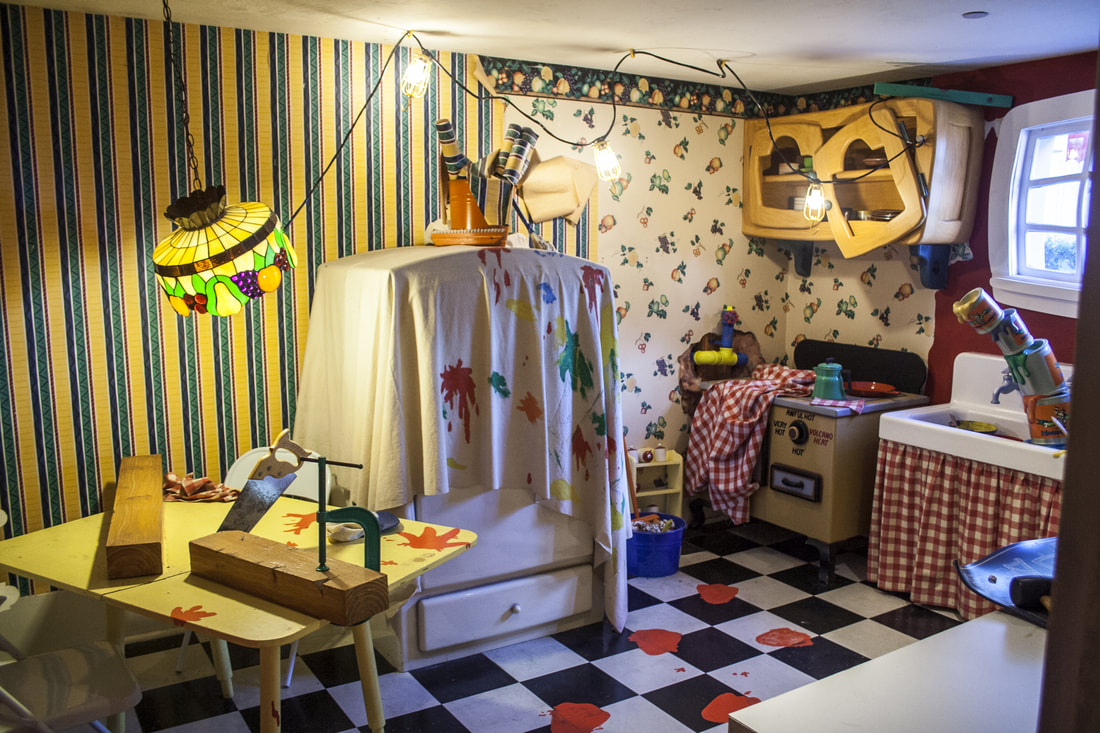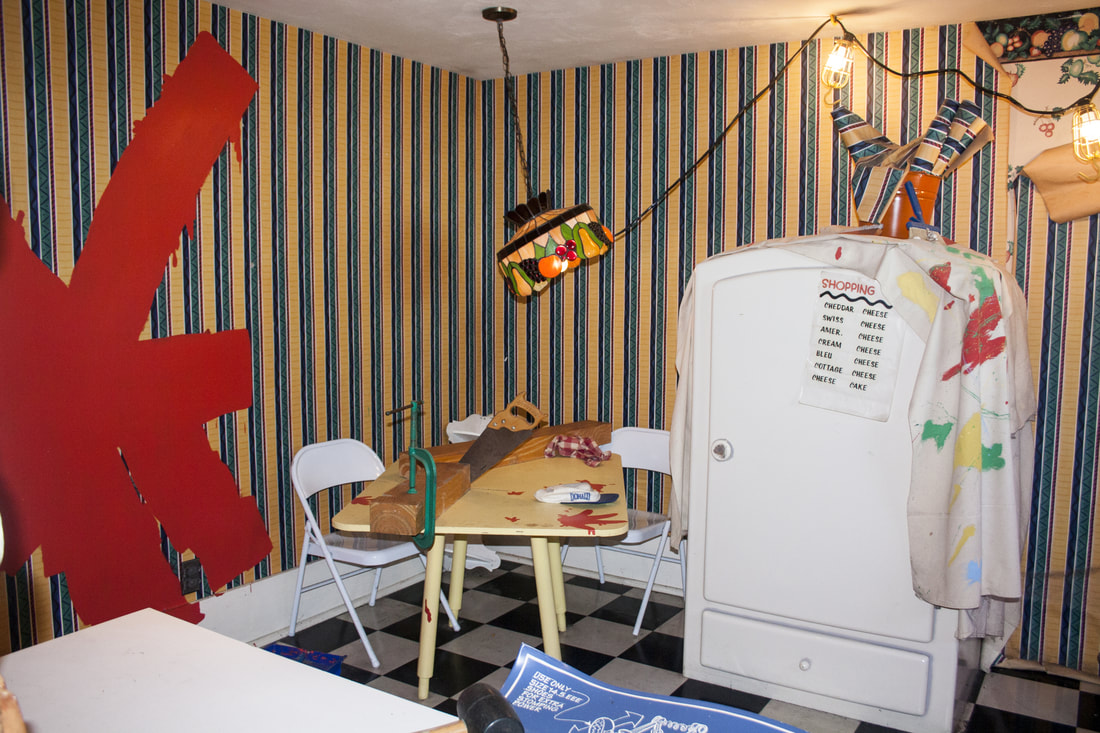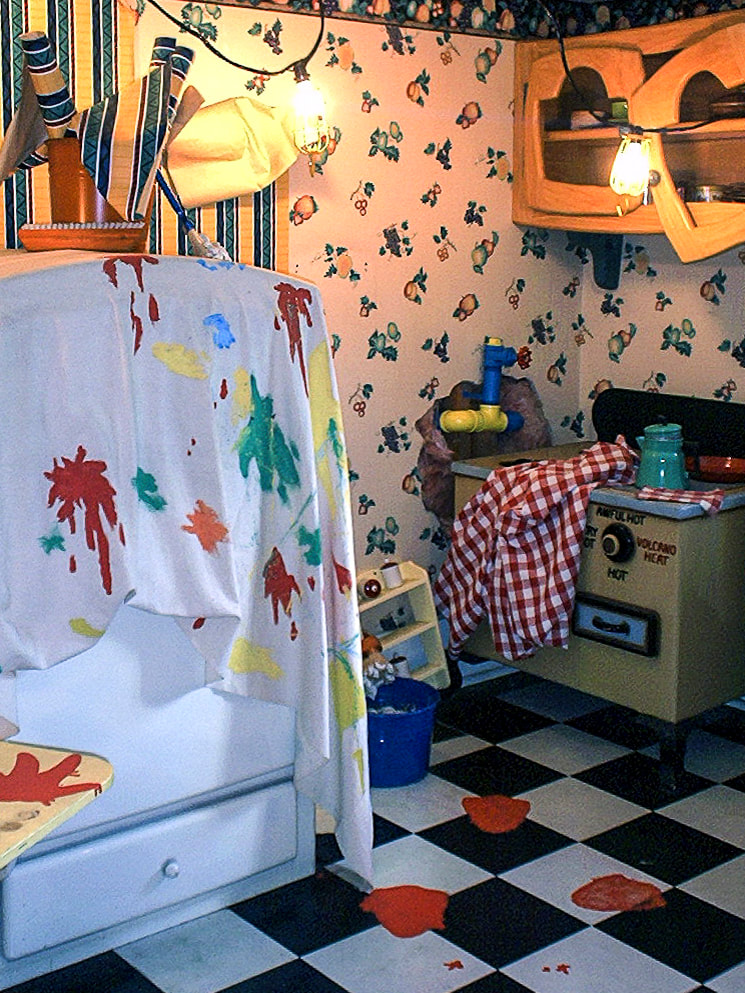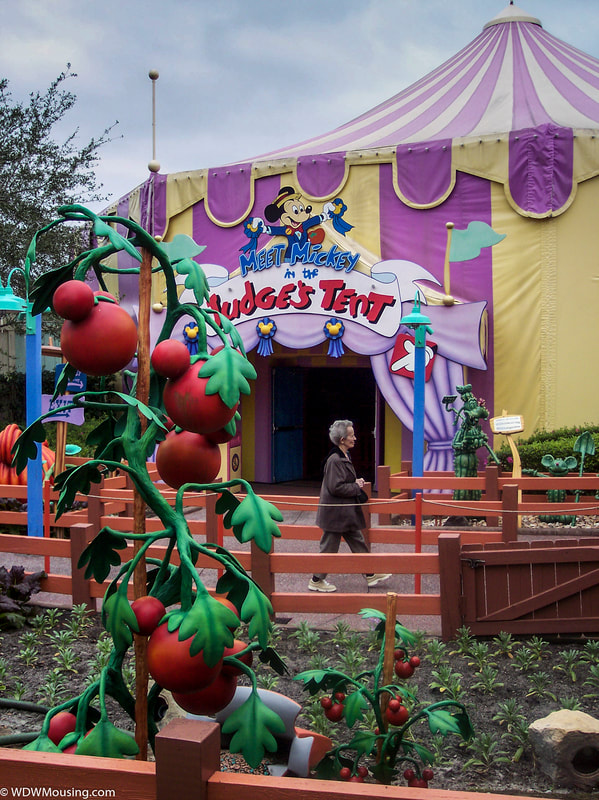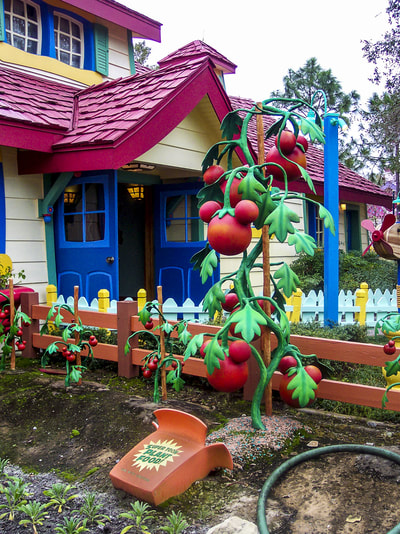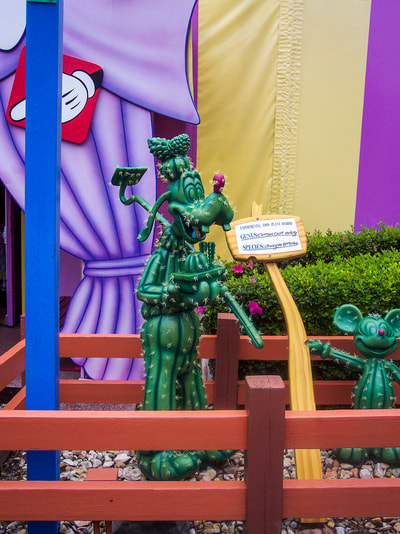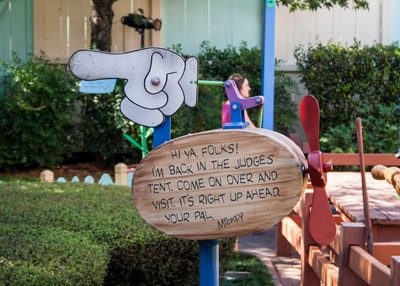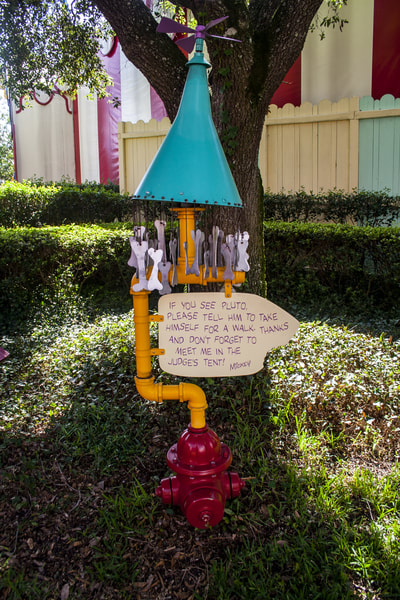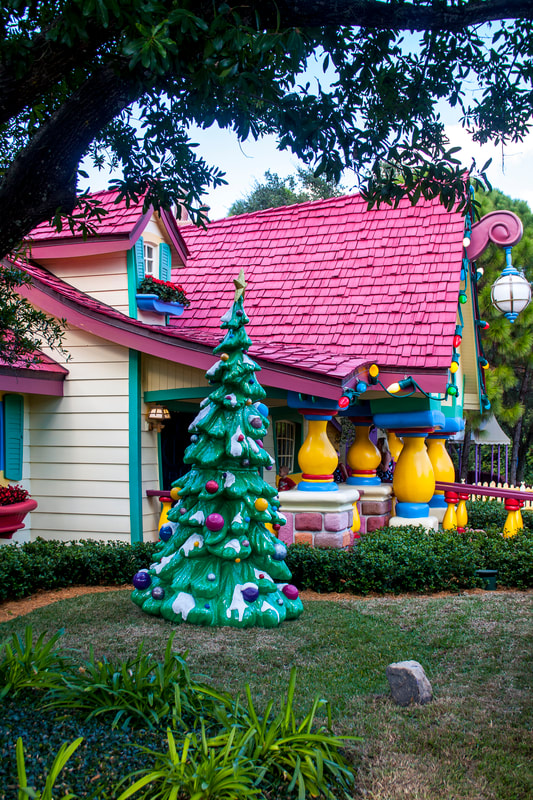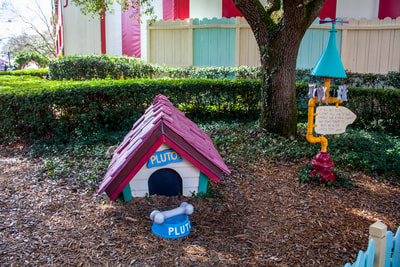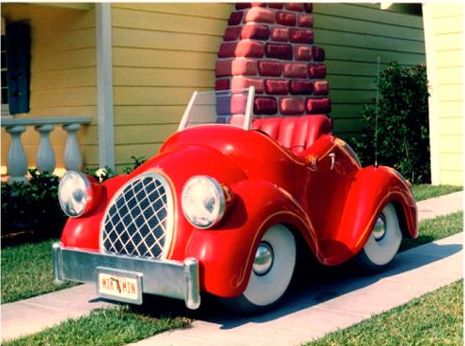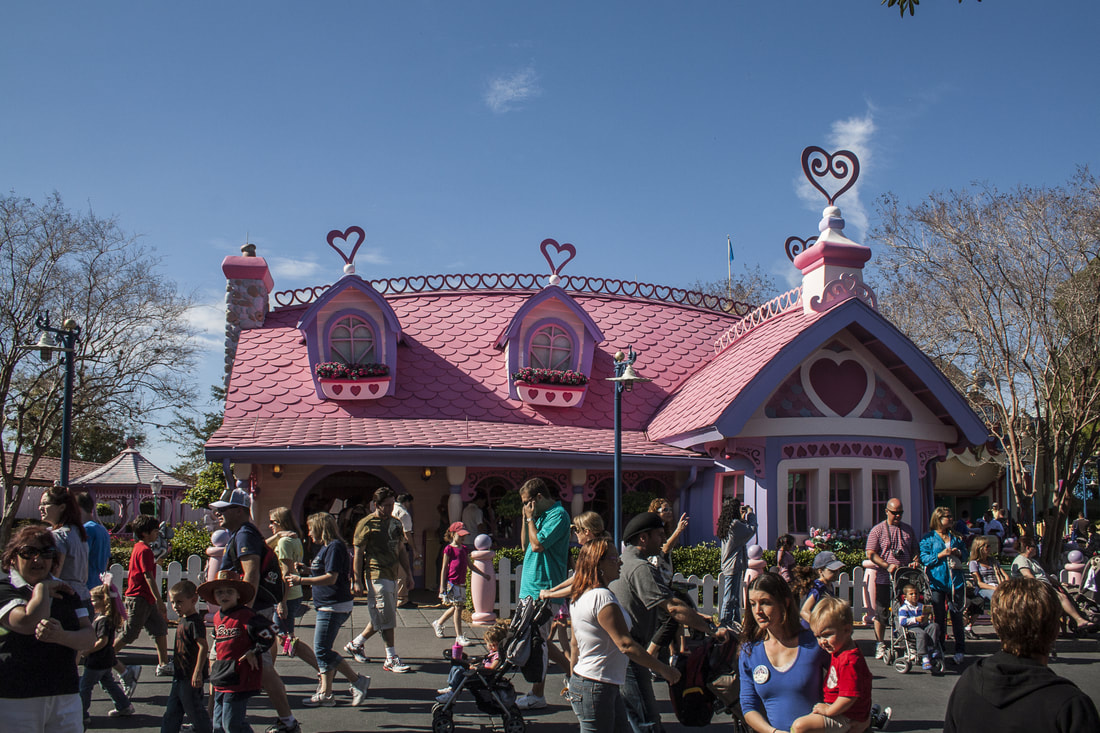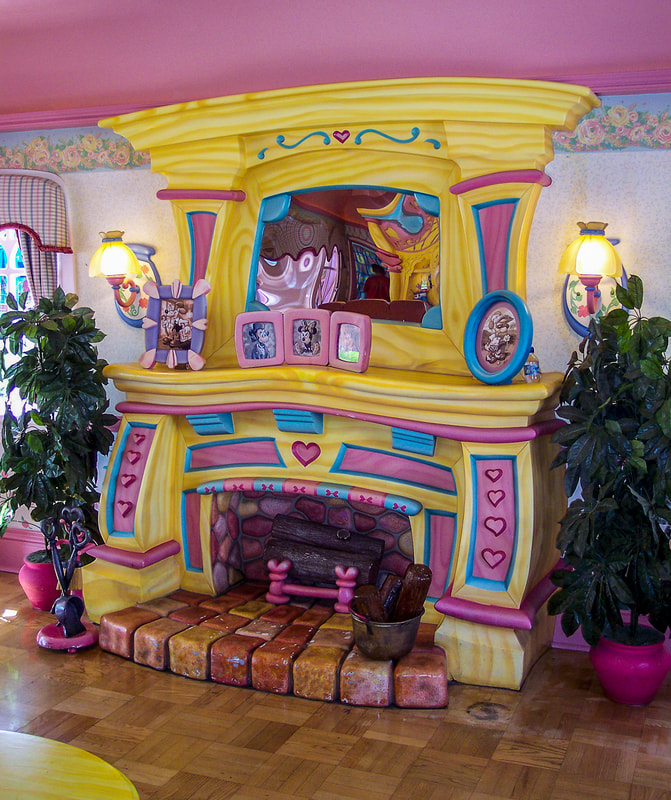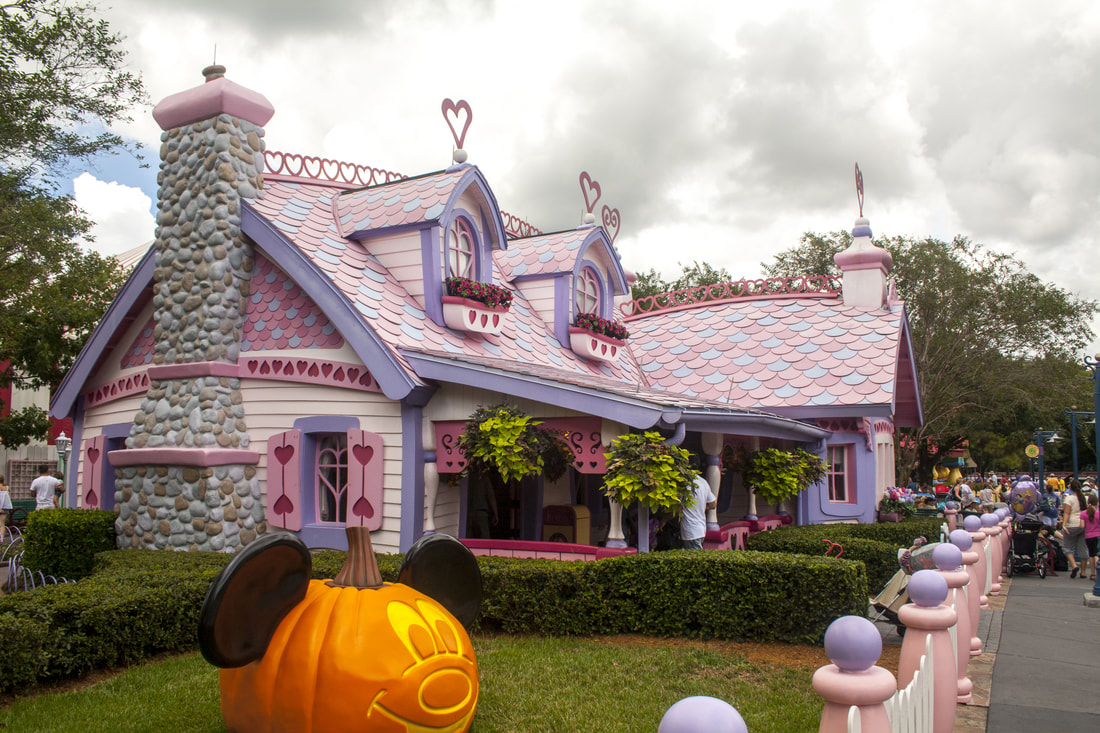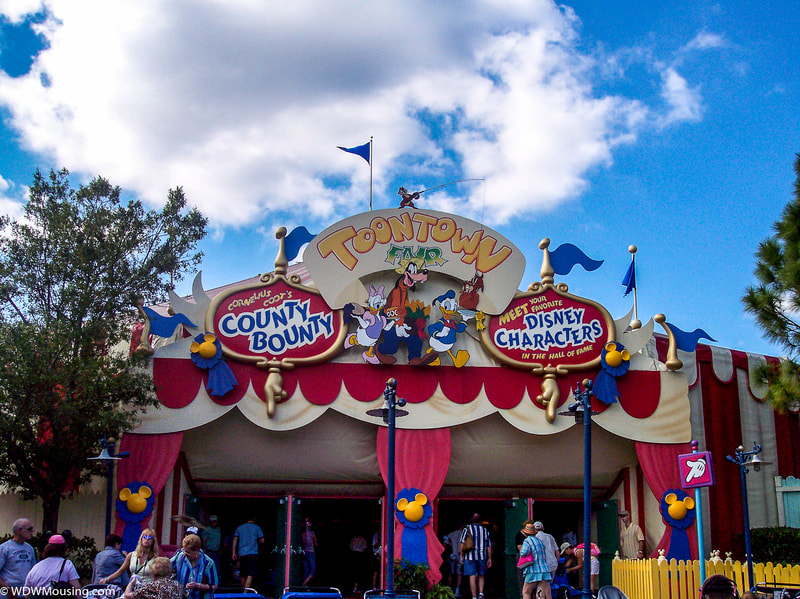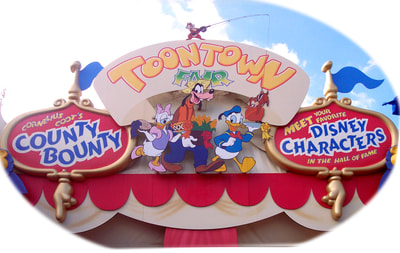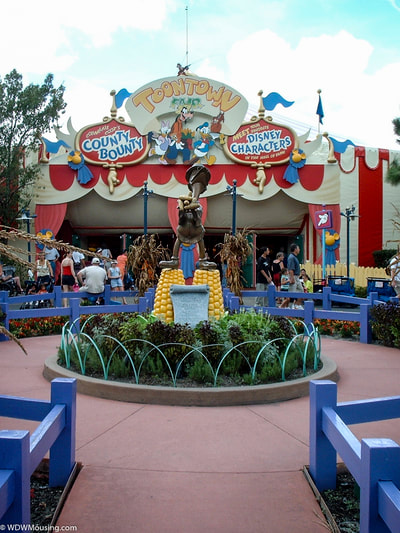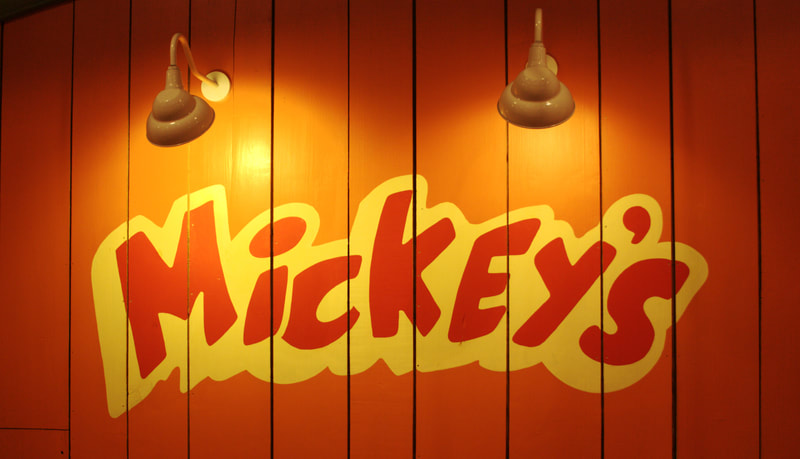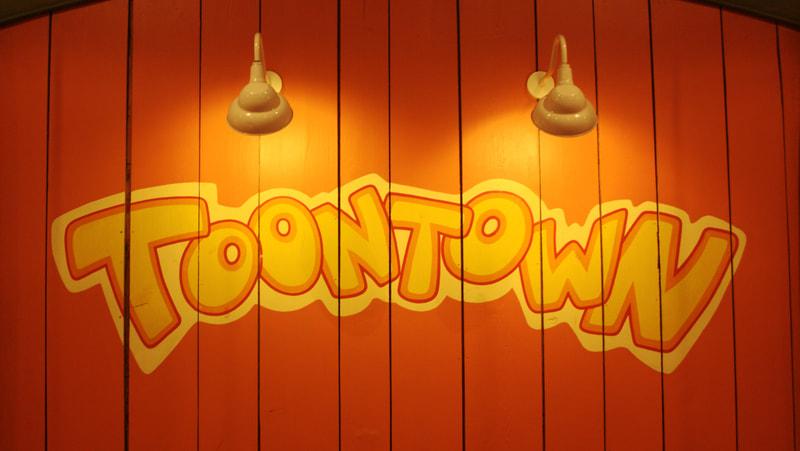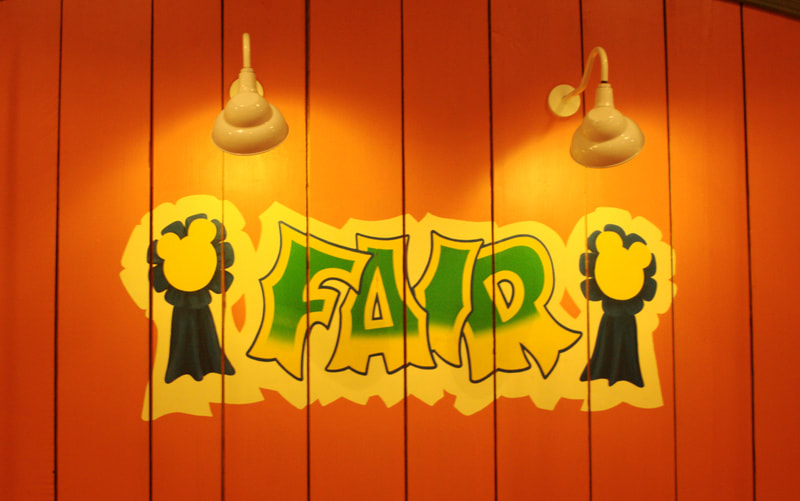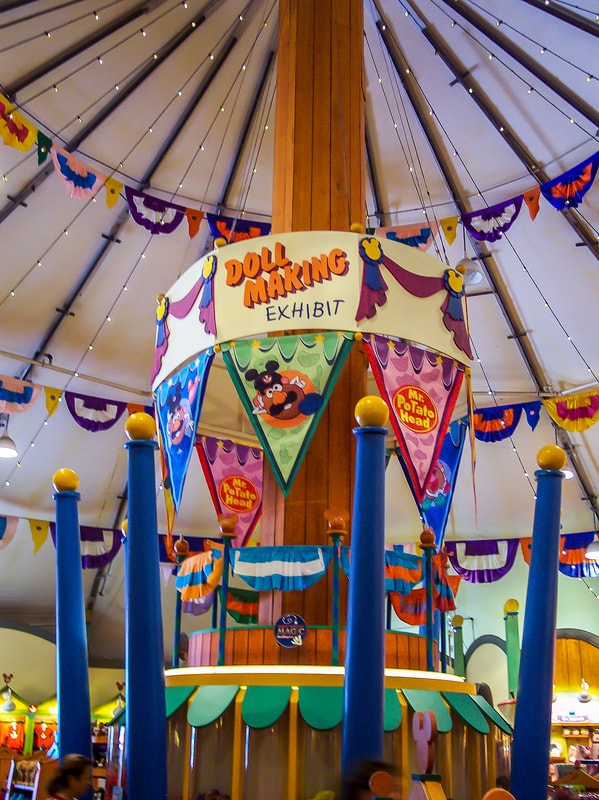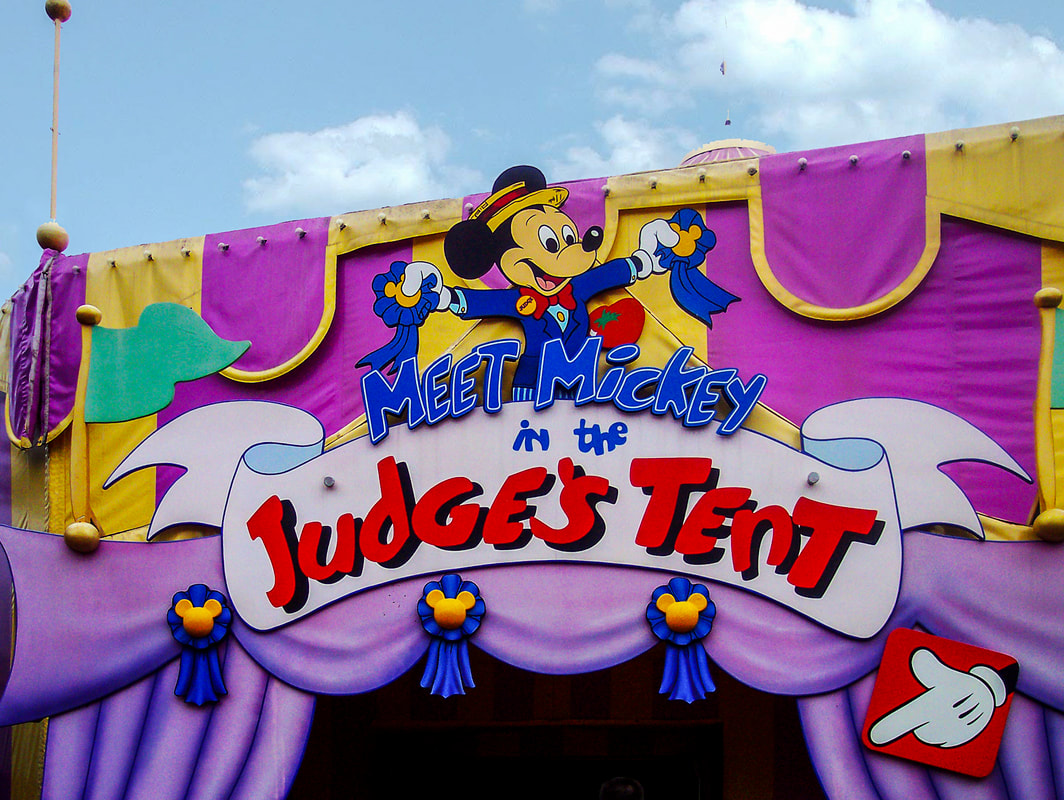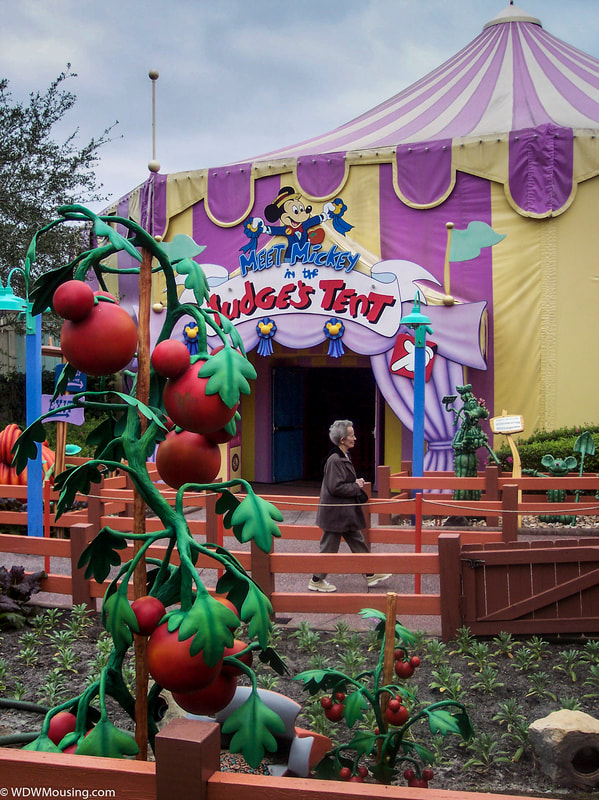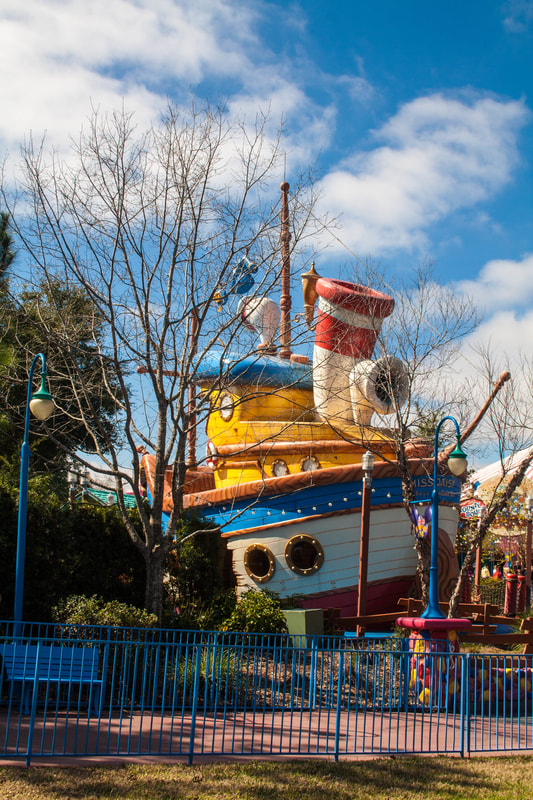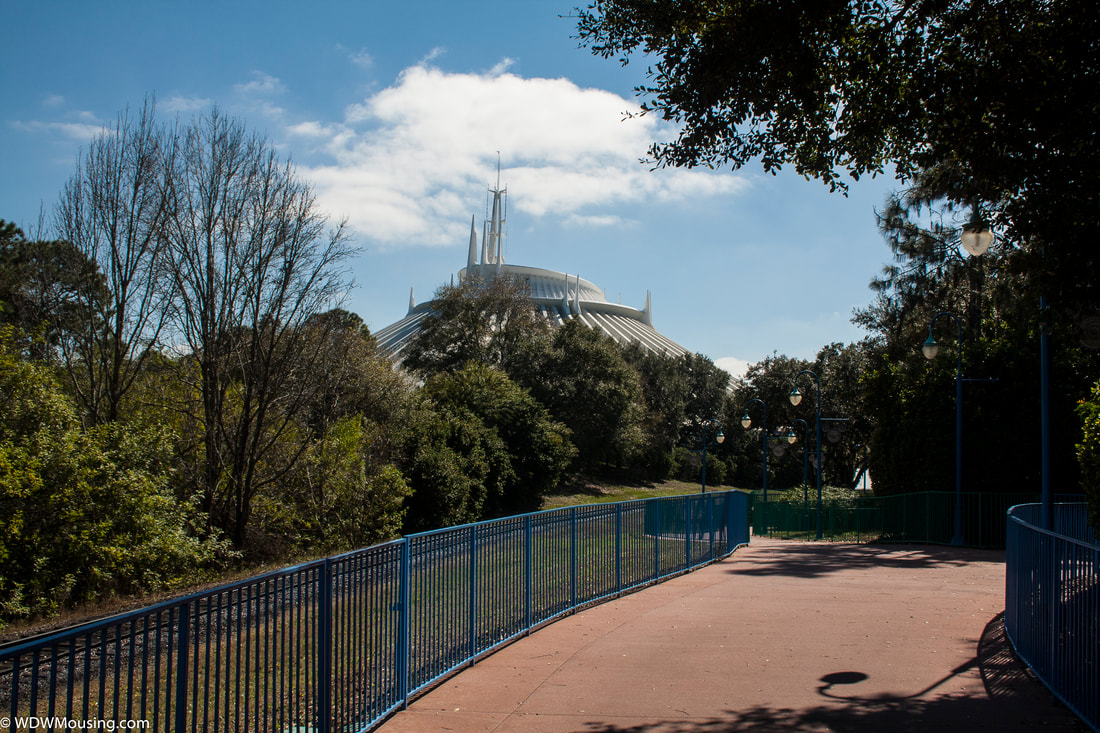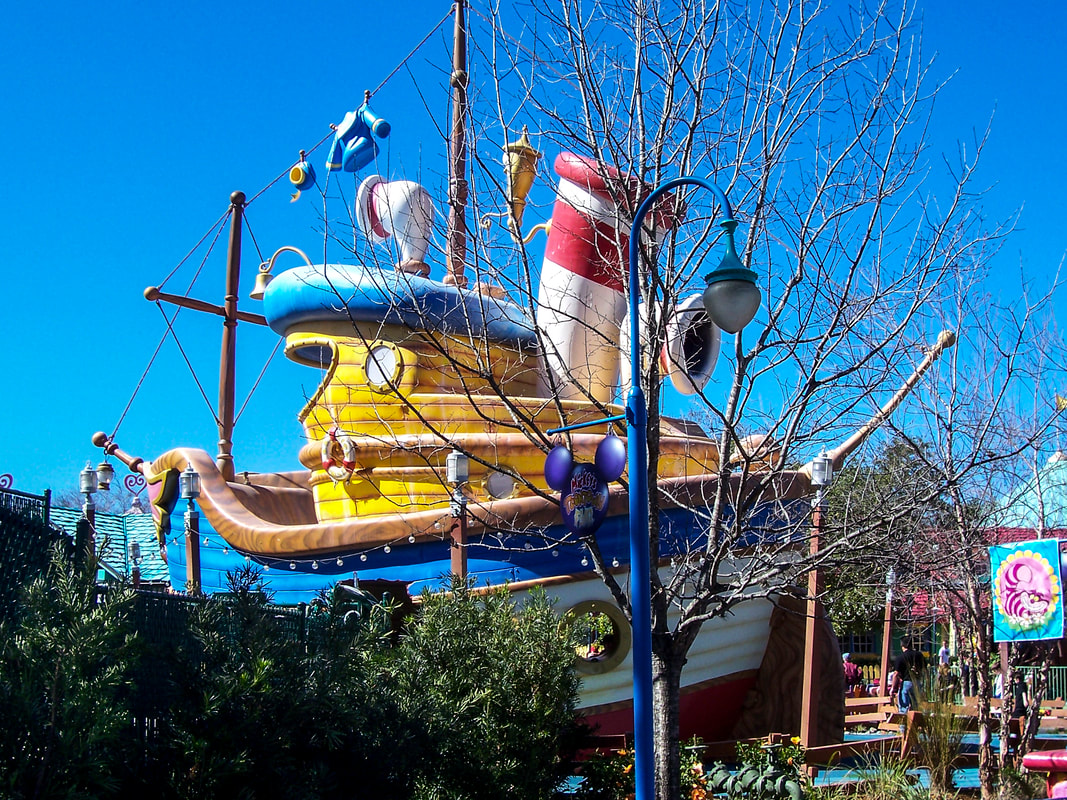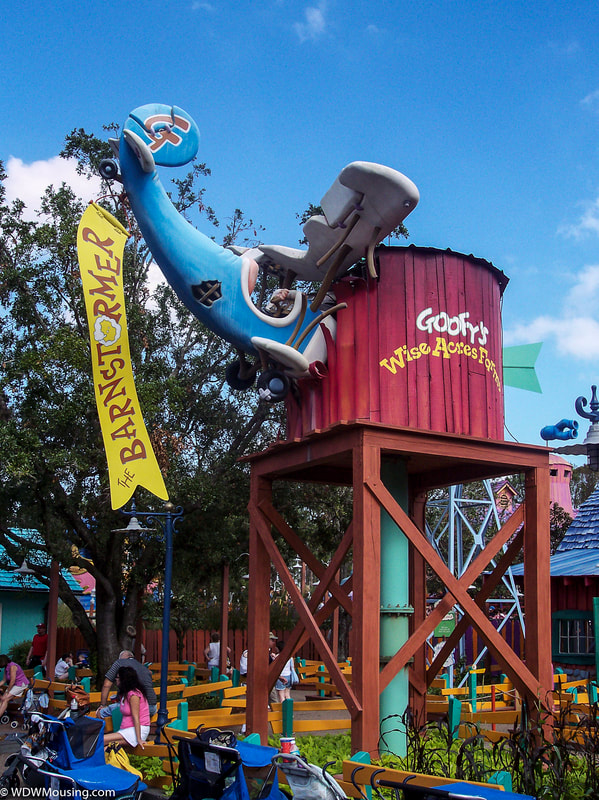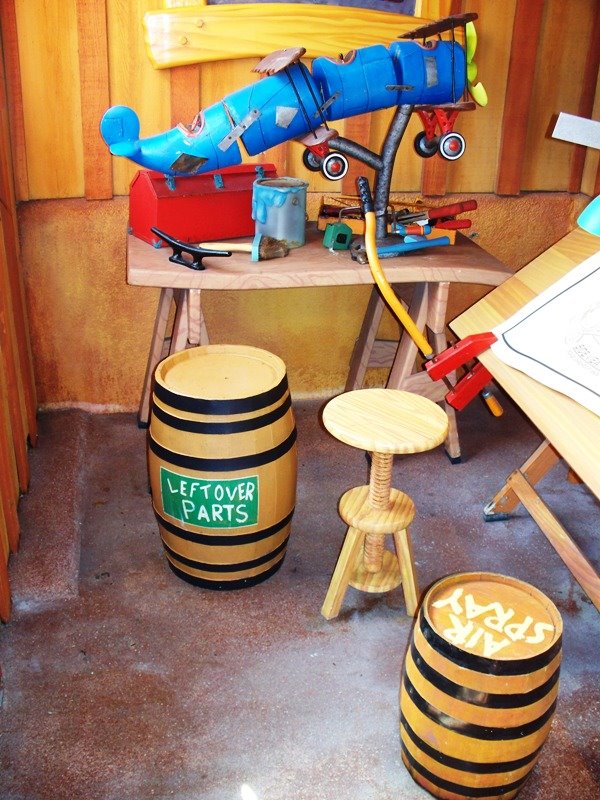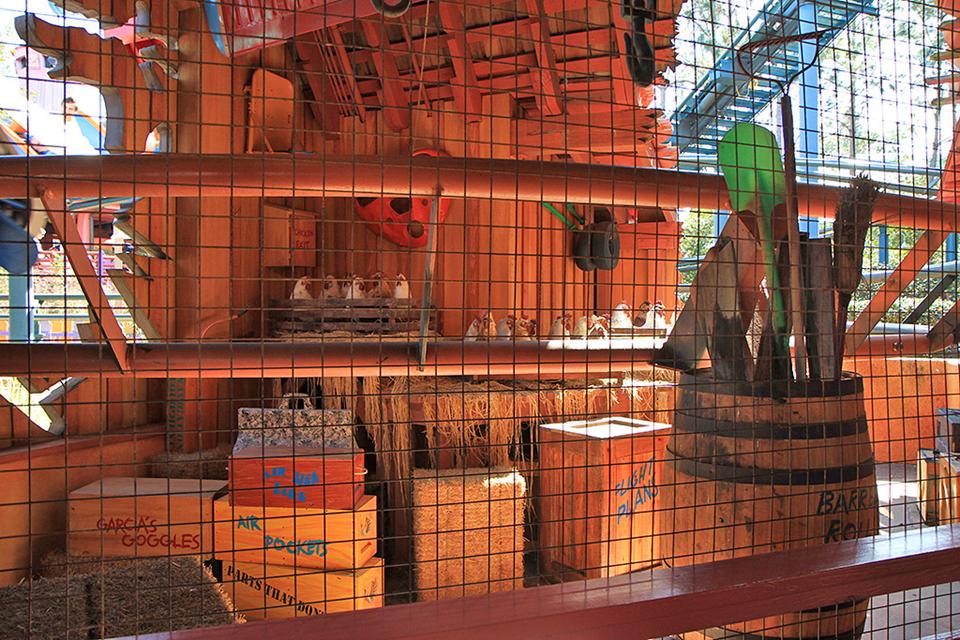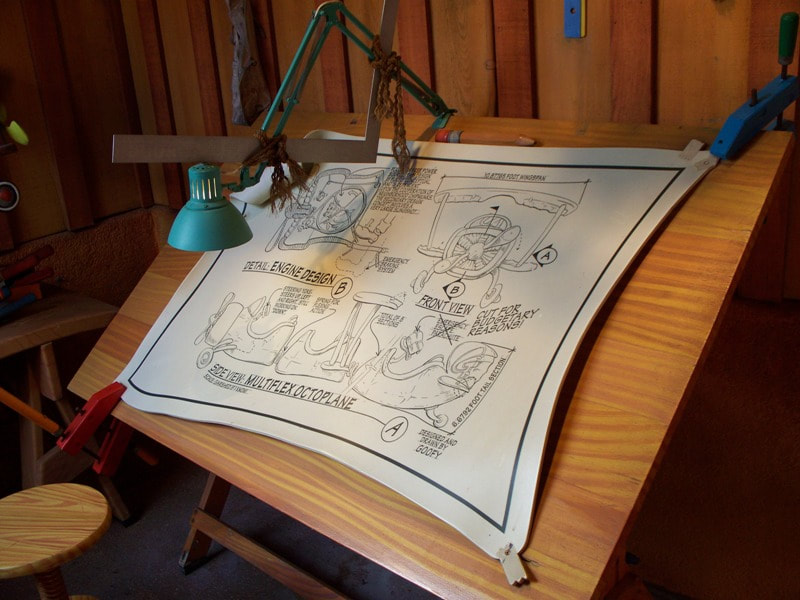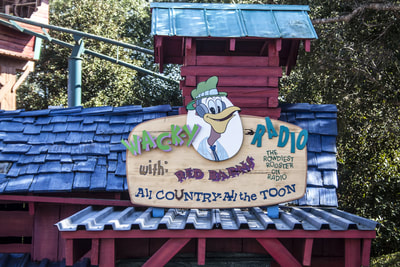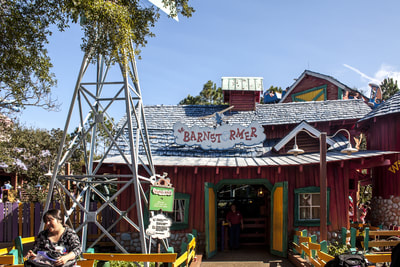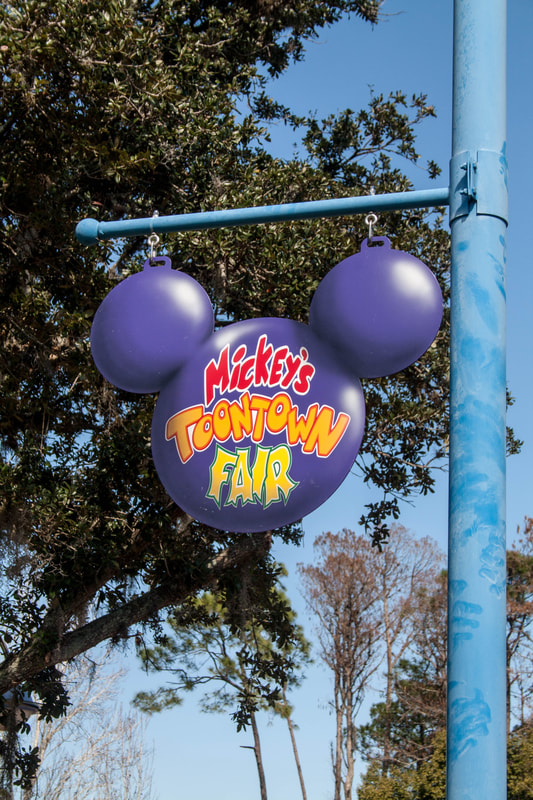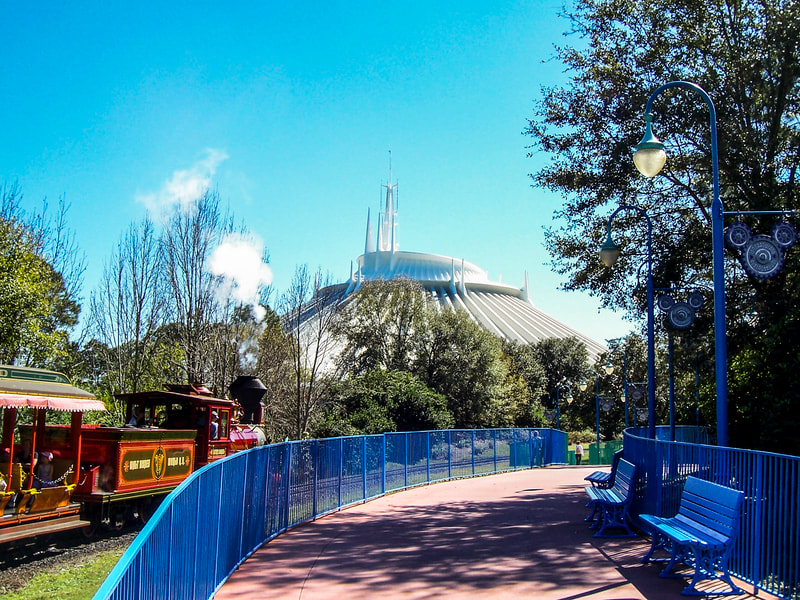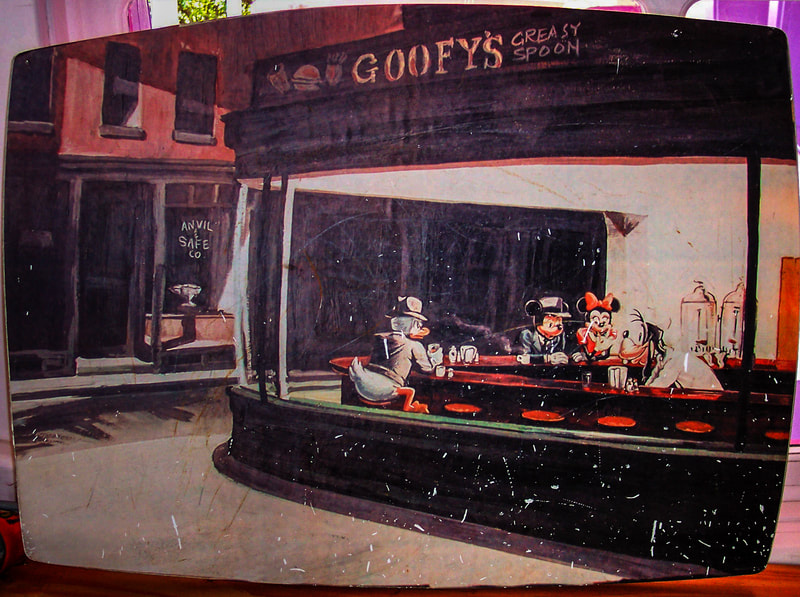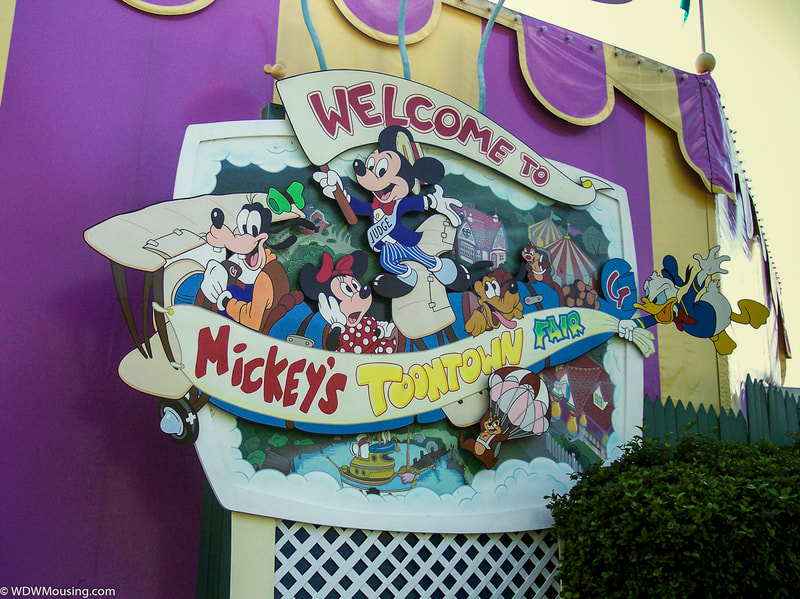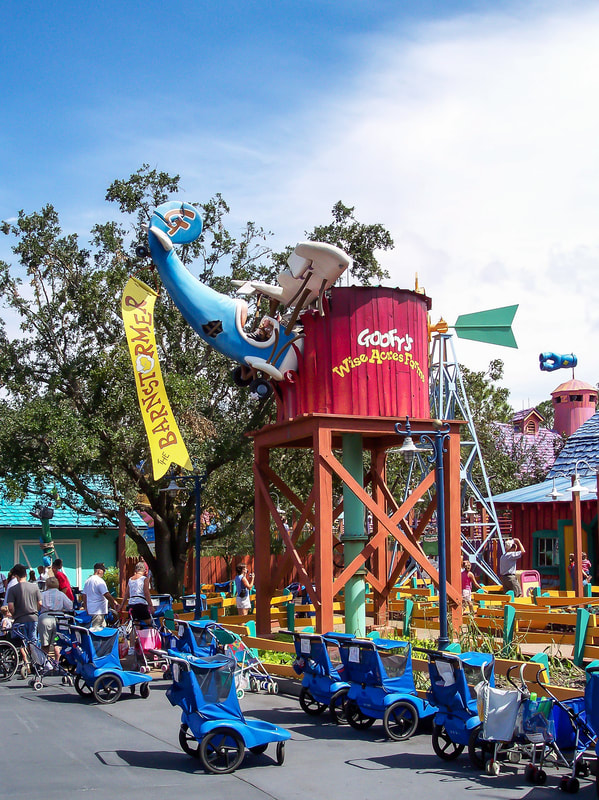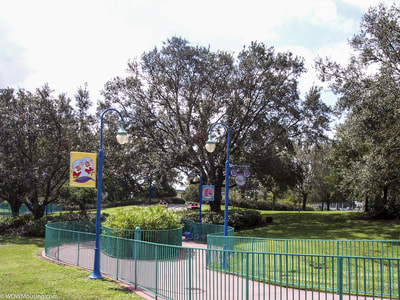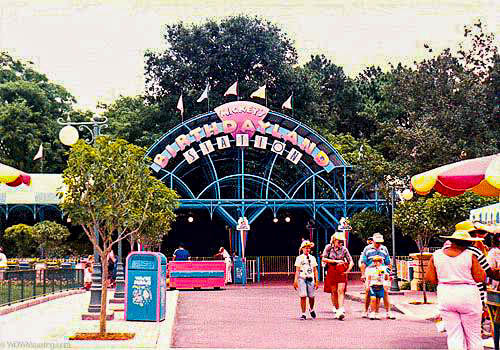Chapter 22 - Magic Kingdom - Fantasyland That Once Was posted 10/4/18
update 5/7/20
|
Snow White
Fantasyland Skyway Dumbo, the Flying Elephant 20,000 Leagues under the Sea Ariel’s Grotto Mr. Toad’s Wild Ride Mickey’s Birthdayland Mickey’s Starland Mickey’s Toontown Fair Walt Disney Railroad Fantasyland Station |
In this Chapter we are going to take a departure from our pictorial tour of the Magic Kingdom Fantasyland and take a short side tour of the Fantasyland 'That Once Was'. But bear with us are going to try to capture all of the major and most of the minor changes in Fantasyland. We ask take our readers provide us feedback on any noteworthy changes that should have been included or mentioned. |
On opening day at Walt Disney World on October 1, 1971 the following extinct attractions existed in Fantasyland:
Later additions, which are no longer there were:
The following are opening day attractions that are still with us:
The Walt Disney Railroad Fantasyland Station was added in 1988 and is still present, but it to has seen changes over the years. More on that later.
As Walt Disney said “All of this will Change over and over again”. And this has been true for Fantasyland and as well as Walt Disney World which has seen a number of changes in the attractions offered over the years.
In previous Chapters, we covered some of the changes and refurbishments. (see Chapters 20 &21)
- Mr. Toad’s Wild Ride (1971 – 1998)
- Skyway ride-Tomorrowland (1971 – 1999)
- Snow White’s Adventures (1971 – 1994)
- Snow White's Scary Adventures (1994 – 2012)
Later additions, which are no longer there were:
- 20,000 Leagues under the Sea (1971 - 1994)
- Mickey’s Birthdayland (1988 – 1990), then became Mickey’s Starland (1990 – 1995) and briefly Mickey’s Toyland (1995 – 1996) finally Mickey’s Toontown Fair (1996 – 2012)
- Storytime with Belle (1999–2010)
- Pooh's Playful Spot (September 1, 2005 – April 11, 2010)
The following are opening day attractions that are still with us:
- Dumbo, the Flying Elephant (1971 – moved in 2012 to New Fantasyland)
- Prince Charming Regal Carrousel (1971 called Cinderella's Golden Carrousel – 2010 changed to Prince Charming Regal Carrousel)
- Peter Pan’s Flight (1971 – present)
- Alice’s Mad Tea Party (1971 – present)
- “it’s a small world” (1971 – present)
The Walt Disney Railroad Fantasyland Station was added in 1988 and is still present, but it to has seen changes over the years. More on that later.
As Walt Disney said “All of this will Change over and over again”. And this has been true for Fantasyland and as well as Walt Disney World which has seen a number of changes in the attractions offered over the years.
In previous Chapters, we covered some of the changes and refurbishments. (see Chapters 20 &21)
- Addition of Tangled Tower rest area
- Peter Pan’s flight – addition of an interactive Queue in 2014
- Fantasyland Theater – presentation changes from Mickey Mouse Revue (1971 – 1980) to Magic Journeys (1987 – 1993) to The Legend of the Lion King (1994 – 2002) and now Mickey’s PhilharMagic (2003 – present)
- Storytime with Belle (1999–2010)
- Pooh's Playful Spot (September 1, 2005 – April 11, 2010)
- And the many changes of the Shoppes in Fantasyland
But in this chapter we’re going to tour through the most popular (or unpopular) changes in Fantasyland.
Snow White’s Scary Adventures
At opening day in 1971, located across from Cinderella’s Golden Carrousel was Snow White’s Adventures.
The attraction was based on Disney’s 1938 animated film Snow White and the Seven Dwarfs.
Note: in 2010 Cinderella’s Golden Carrousel was renamed to Prince Charming’s Carrousel (see Chapter 20).
The attraction was based on Disney’s 1938 animated film Snow White and the Seven Dwarfs.
Note: in 2010 Cinderella’s Golden Carrousel was renamed to Prince Charming’s Carrousel (see Chapter 20).
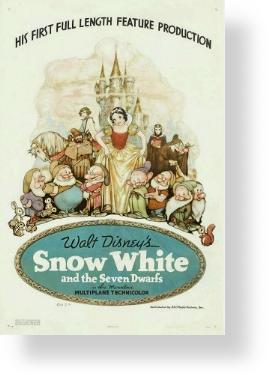 Original movie posters for the film
Original movie posters for the film
History
In 1937 Walt Disney was in major debt and making an animated full length feature film was a make or break decision. Snow White and the Seven Dwarfs, was Disney’s first animated full length feature film.
It is often claimed that “Snow White and the Seven Dwarfs” was the first full-length animated movie.
“Snow White and The Seven Dwarfs” became the most profitable movie in 1938.
So when Walt began planning Disneyland, Snow White was an obvious choice to be included in his park.
Rightfully so it should be one of the original Disneyland attractions on opening day in 1955, as well as, in Walt Disney World in 1971.
In both parks Snow White’s Adventure was the original name for the attraction. The original ride was scary--very scary—for young children. Snow White never appeared in the original ride, but the Evil Queen appeared more than a half dozen times. Like in the early version of Peter Pan's Flight, the Imagineers wanted the guests to see the adventure through her eyes. Few people understood this concept, and some wondered why Snow White was not featured in the ride.
The Disneyland version of the attraction was made less scary in 1983 and, the Walt Disney World version continued to be scarier until well into 1994. The Magic Kingdom’s less-scary ride reopened December 16, 1994 with the same name as its Disneyland counterpart: Snow White’s Scary Adventures.
Snow White now appeared throughout the ride; at the well with the doves, danced with the dwarfs, and got Love’s First Kiss by The Prince himself.
The Imagineers designed a castle-like structure for Snow White’s Scary Adventures to stay within the Fantasyland medieval theme.
Note: Claude Coats was responsible for the original design of Snow White’s Adventures. Claude Coats you’ll remember from his work on the Haunted Mansion – Chapter 17 & 19 and Peter Pan – Chapter 20
In 1937 Walt Disney was in major debt and making an animated full length feature film was a make or break decision. Snow White and the Seven Dwarfs, was Disney’s first animated full length feature film.
It is often claimed that “Snow White and the Seven Dwarfs” was the first full-length animated movie.
“Snow White and The Seven Dwarfs” became the most profitable movie in 1938.
So when Walt began planning Disneyland, Snow White was an obvious choice to be included in his park.
Rightfully so it should be one of the original Disneyland attractions on opening day in 1955, as well as, in Walt Disney World in 1971.
In both parks Snow White’s Adventure was the original name for the attraction. The original ride was scary--very scary—for young children. Snow White never appeared in the original ride, but the Evil Queen appeared more than a half dozen times. Like in the early version of Peter Pan's Flight, the Imagineers wanted the guests to see the adventure through her eyes. Few people understood this concept, and some wondered why Snow White was not featured in the ride.
The Disneyland version of the attraction was made less scary in 1983 and, the Walt Disney World version continued to be scarier until well into 1994. The Magic Kingdom’s less-scary ride reopened December 16, 1994 with the same name as its Disneyland counterpart: Snow White’s Scary Adventures.
Snow White now appeared throughout the ride; at the well with the doves, danced with the dwarfs, and got Love’s First Kiss by The Prince himself.
The Imagineers designed a castle-like structure for Snow White’s Scary Adventures to stay within the Fantasyland medieval theme.
Note: Claude Coats was responsible for the original design of Snow White’s Adventures. Claude Coats you’ll remember from his work on the Haunted Mansion – Chapter 17 & 19 and Peter Pan – Chapter 20
Snow White’s Adventures (1971-1994)
The original version of the attraction at Walt Disney World ran from 1971 to 1994.
Ride through the original attraction
The original version of the attraction at Walt Disney World ran from 1971 to 1994.
Ride through the original attraction
- The queue featured the Dwarfs' mine, with their cottage visible in the distance.
- The vehicles were designed to look like Diamond mine rail cars and each has the name of a Dwarf in the front. (Vehicles were engineered by Arrow – more on Arrow see Chapter 20)
- The ride began with the guests entering the castle in a scene; however, there was no Snow White seen cleaning. Instead, guests saw a side of the Dwarves' cottage as "I'm Wishing" played in the background.
- In a nearby window the queen was watch and the guests saw a mirror, but not the magic one.
|
|
- Guests would then exit the cottage, back into the woods, and pass by two ominous vultures.
- The final scene was the diamond mine, where the Witch appeared several more times.
- Her final appearance was on top of a doorway, pushing an enormous jewel onto the guests.
- Guests would then enter a room full of flashing cartoon-like strobe lights with the Witch's cackling echoing in their ears.
- Guests then exited the attraction.
Ginny Tyler did the voice of the Witch in this version, while Mel Blanc, Paul Frees, Hal Smith, Hans Conried and Dallas McKennon did the voices of the Dwarfs.
Notes:
References:
- Ginny Tyler is a Disney Legend who did voice works for dozens pf Disney cartoons. She was also one of the original Mouseketeers from the Mickey Mouse Club. She is also the voice of the Tiki Goddess in the pre-show at the Enchanted Tiki Room. (see Chapter 10 – Adventureland)
- Mel Blanc should need no introduction. He was best known for his voice work with Warner Bros., Hanna-Barbera, DiC Entertainment, and Walter Lantz Productions. (Bugs Bunny, Daffy Duck, Porky Pig, Tweety Bird, Sylvester the Cat, Yosemite Sam, Foghorn Leghorn, Marvin the Martian, Pepé Le Pew, Speedy Gonzales, Wile E. Coyote, Road Runner, the Tasmanian Devil and many of the other characters) Blanc also provided the voice of Cousin Orville in the Magic Kingdom attraction Carousel of Progress.
- Paul Frees also voiced "Ghost Host" in the Haunted Mansion and several audio-animatronic pirates, including the Auctioneer, in the Pirates of the Caribbean ride. (see Chapters 11 and 16)
- Hal Smith is best known for his role as Otis Campbell on the 1960's television series, The Andy Griffith Show. He also did many voice roles for Disney, including Goofy, Grumpy and Sleepy, Winnie the Pooh and Owl in the Winnie the Pooh films.
- Hans Conried voiced both Captain Hook and George Darling in Peter Pan.
- Dallas McKennon distinctive voice can be heard in movies such as Lady and the Tramp, Sleeping Beauty, Donald Duck and His Friends, 101 Dalmatians, Mary Poppins, and Bedknobs and Broomsticks. He also did voices for several Disney Attractions, such as the Big Thunder Mountain Railroad safety spiel (Chapter 12), the laughing hyenas in "it's a small world" (Chapter 20), Ben Franklin in Epcot's The American Adventure, and Zeke in Country Bear Jamboree (Chapter 14).
References:
Snow White’s Scary Adventures (1994-2012)
In 1994, Snow White's Adventures was redesigned to be more like the animated film, but the scenes are a slightly different order with a few new scenes added.
Ride through of the Snow White’s Scary Adventures attraction
In 1994, Snow White's Adventures was redesigned to be more like the animated film, but the scenes are a slightly different order with a few new scenes added.
Ride through of the Snow White’s Scary Adventures attraction
Notes:
|
|
In 2012 as part of the New Fantasyland Expansion, Imagineers redesigned the space as Princess Fairytale Hall to provide a venue for character meet-and-greets. (see Chapter 21)
|
An area themed to Disney's Snow White and the Seven Dwarfs was built. Some of the animatronics and the Dwarfs’ cottage from the attraction were repurposed for Seven Dwarf’s Mine Train
But Snow White’s Scary Adventures attraction still continues on in Disneyland. References:
|
|
Fantasyland Skyway
Another opening day attraction was the Skyway. The Skyway took guests from Fantasyland to Tomorrowland and also from Tomorrowland to Fantasyland. This alternative mode of transportation through the park offered a relaxing and beautiful way to travel. Guests would board bucket cars which then took to the skies for a leisurely journey across the park. The Skyway offered guests unique views of the park. The Skyway was different in that it did not travel in a straight line over the park. Gondolas descended to an L-shaped turn midway between the 20,000 Leagues under the Sea and Grand Prix Speedway attractions before ascending again and traveling on towards their destination. |
|
The Skyway was built by Von Roll of Bern, Switzerland, which built similar sky rides for over 100 amusement parks, theme parks, and exposition grounds. The first Von Roll sky ride in the United States was the Skyway at Disneyland in 1956. Each gondola in the original Disneyland version was round, had a center post, and held only two guests. These gondolas were often called “sky buckets” because of their appearance. In the 1960s, Disney Legend Bob Gurr designed new gondolas which doubled the guest capacity from two to four, eliminated the center post, and improved the appearance—all without raising the weight.
Note: Bob Gurr designed the ride system and vehicles used in the Haunted Mansion and most of the vehicles used in attractions at Disneyland and Walt Disney World. (see Chapter 18)
Click to enlarge
The Skyway was removed in 1999. During the renovation of Space Mountain, the Tomorrowland station was demolished in the summer of 2009, while the Fantasyland station was used for stroller parking. The Fantasyland station was later demolished for a Tangled-themed rest area in 2012. (see Chapter 20)
Source:
Note:
Disney plans to revive the classic Skyway in a modern-day take at the Walt Disney World Resort. The new 'Disney Skyliner' will connect Disney’s Art of Animation, Pop Century, and Caribbean Beach resorts, as well as the Disney Riviera Resort, with other locations such as Disney’s Hollywood Studios and the International Gateway at Epcot.
Source:
- http://www.disneydispatch.com/content/columns/disney-pi/2012/1-history-of-wdw/
- https://en.wikipedia.org/wiki/Skyway_(Disney)
- http://www.yesterland.com/skywaymk.html
Note:
Disney plans to revive the classic Skyway in a modern-day take at the Walt Disney World Resort. The new 'Disney Skyliner' will connect Disney’s Art of Animation, Pop Century, and Caribbean Beach resorts, as well as the Disney Riviera Resort, with other locations such as Disney’s Hollywood Studios and the International Gateway at Epcot.
Dumbo, the Flying Elephant
There are still 14 attractions remaining from the Magic Kingdom’s opening day, October 1, 1971 Dumbo the Flying Elephant is one. But the one currently in Fantasyland isn’t the original. It has been moved and has gone through a major overhaul. We will begin the tour of the original one in this Chapter and complete it in the New Fantasyland Chapter.
The others remaining originals are, note most have seen refurbishments, updates and changes over the years:
The attraction Dumbo the Flying Elephant is based on Disney’s 1941 animated classic feature film Dumbo.
There are still 14 attractions remaining from the Magic Kingdom’s opening day, October 1, 1971 Dumbo the Flying Elephant is one. But the one currently in Fantasyland isn’t the original. It has been moved and has gone through a major overhaul. We will begin the tour of the original one in this Chapter and complete it in the New Fantasyland Chapter.
The others remaining originals are, note most have seen refurbishments, updates and changes over the years:
- Cinderella’s Golden Carrousel (now Prince Charming Regal Carrousel)
- Country Bear Jamboree
- Frontierland Shootin’ Arcade
- Hall of Presidents
- Haunted Mansion
- “it’s a small world”
- Jungle Cruise
- Mad Tea Party
- Peter Pan’s Flight
- Swiss Family Treehouse
- Tropical Serenade (now Enchanted Tiki Room)
- Grand Prix Raceway (now Tomorrowland Speedway)
- Walt Disney World Railroad
The attraction Dumbo the Flying Elephant is based on Disney’s 1941 animated classic feature film Dumbo.
|
The story is about a young circus elephant born with comically large ears and given the cruel nickname Dumbo. One day at a show, he is taunted by a group of kids, inciting his mother into a rage that gets her locked up. After Dumbo's ears cause an accident that injures many of the other elephants, he is made to dress like a clown and perform dangerous stunts. Everything changes when Dumbo discovers that his enormous ears actually allow him to fly, and he astounds everyone at the circus with his new talent.
Dumbo the Flying Elephant has seen some major changes over the years. From opening day to 1993 the attraction was located in the center of Fantasyland next to Prince Charming Regal Carrousel. It also featured a single structure with 16 elephants. |
Originally Dumbo the Flying Elephant attraction was intended to feature ten pink elephants based on the film’s “Pink Elephants on Parade” segment that Dumbo and Timothy hallucinated about after accidentally drinking champagne in the film. It was intended to maintain with the story that there was only one Dumbo, not ten. But considering the befuddling nature of the pink elephants Walt Disney chose to bend the story and use 10 Dumbo’s.
The Walt Disney World attraction was modified from the Disneyland version, which had 10 elephants, to include 16 vehicles.
The Walt Disney World attraction was modified from the Disneyland version, which had 10 elephants, to include 16 vehicles.
|
On opening day, there was no Timothy Q. Mouse (Dumbo’s pal) and the elephants did not have hats. The hats were eventually added after a couple of months, but the Timothy Q. Mouse figure wasn’t added for about two years.
In 2012 it was moved to New Fantasyland in the Storybook Circus and now features two adjacent carrousels with 16 Flying Elephants apiece. We are going to cover Dumbo the Flying Elephant attraction more in depth in the next Chapter 23 – New Fantasyland. |
References:
- http://www.wdwinfo.com/disney-world/magic-kingdom/dumbo-the-flying-elephant.htm
- https://disneyworld.disney.go.com/attractions/magic-kingdom/dumbo-the-flying-elephant/
- https://www.themouseforless.com/walt-disney-world/parks/magic-kingdom/dumbo-the-flying-elephant/
- https://www.disneyfanatic.com/10-sensational-secrets-about-dumbo-the-flying-elephant-ride-in-walt-disney-worlds-magic-kingdom/
20,000 Leagues Under the Sea: Submarine Voyage
Another removed classic opening day attraction was the 20,000 Leagues Under the Sea: Submarine Voyage. It was located across from the former Mr. Toads Wild Ride attraction. (see above map)
The attraction took guests for a tour of the deep sea with Captain Nemo and his crew. The concept for the 20,000 Leagues Under the Sea: Submarine Voyage attraction was themed to the 1954 film of the same name with Captain Nemo himself was the guide.
To get you into a sea fairing mood here is the music loop that was played at the 20,000 Leagues Under the Sea Queue:
Another removed classic opening day attraction was the 20,000 Leagues Under the Sea: Submarine Voyage. It was located across from the former Mr. Toads Wild Ride attraction. (see above map)
The attraction took guests for a tour of the deep sea with Captain Nemo and his crew. The concept for the 20,000 Leagues Under the Sea: Submarine Voyage attraction was themed to the 1954 film of the same name with Captain Nemo himself was the guide.
To get you into a sea fairing mood here is the music loop that was played at the 20,000 Leagues Under the Sea Queue:
|
History
20,000 Leagues Under the Sea is a 1954 Disney adventure film and the first science fiction film shot in CinemaScope. The film was personally produced by Walt Disney through Walt Disney Productions, directed by Richard Fleischer, and stars Kirk Douglas, James Mason, Paul Lukas and Peter Lorre. It was also the first feature-length Disney film to be distributed by Buena Vista Distribution. The film is adapted from Jules Verne's 19th-century novel Twenty Thousand Leagues Under the Sea. It is considered an early precursor of the steampunk genre. (Steampunk is a subgenre of science fiction or science fantasy that incorporates technology and aesthetic designs inspired by 19th-century industrial steam-powered machinery.) Source: |
Note: Richard O. Fleischer was an American film director known for such movies as The Narrow Margin (1952), Fantastic Voyage (1966) and Soylent Green (1973). His father's was a former cartoon producer rival of Walt Disney. Fleisher Studios brought such animated characters as Koko the Clown, Betty Boop, and Popeye to the movie screen.
Attraction
The attraction was Walt Disney World's Imagineers most ambitious original attraction. They wanted to develop an attraction that was bigger and better. They expanded the scale of the attraction so that it could accommodate 12 submarines, with the tank spreading across a large area of Fantasyland. They adopted the 20,000 Leagues Under the Sea theme, providing a storyline recognizable to fans of Disney's 1954 film.
The attraction was Walt Disney World's Imagineers most ambitious original attraction. They wanted to develop an attraction that was bigger and better. They expanded the scale of the attraction so that it could accommodate 12 submarines, with the tank spreading across a large area of Fantasyland. They adopted the 20,000 Leagues Under the Sea theme, providing a storyline recognizable to fans of Disney's 1954 film.
Photos from Sharon Zahniser
20,000 Leagues Under the Sea used underwater animatronics, forced perspective, and bubble machines to make guests believe they were “diving” under the ocean. Once aboard, guests would hear the voice of Captain Nemo narrating, as well as, the film’s theme music in the background.
The Nautilus boats had 38 guests sitting below water level looking through portholes and traveling through coral reefs, dark caverns, and into unexpected danger below deadly ice caps. They saw real and mythical aquatic life, including eels, turtles, mermaids, and the lost city of Atlantis.
Guests would also see a recreation of an iconic scene from the film as they watched a smaller Nautilus in the grasps of the giant squid.
Note: Peter Renaday did the voice of Captain Nemo. Peter you’ll remember also voiced Abraham Lincoln in the Hall of Presidents (Chapter 16), Henry in Country Bear Jamboree (Chapter 14), Narrator in the Many Adventures of Winnie the Pooh (Chapter 21) and of course many animated films.
The Nautilus boats had 38 guests sitting below water level looking through portholes and traveling through coral reefs, dark caverns, and into unexpected danger below deadly ice caps. They saw real and mythical aquatic life, including eels, turtles, mermaids, and the lost city of Atlantis.
Guests would also see a recreation of an iconic scene from the film as they watched a smaller Nautilus in the grasps of the giant squid.
Note: Peter Renaday did the voice of Captain Nemo. Peter you’ll remember also voiced Abraham Lincoln in the Hall of Presidents (Chapter 16), Henry in Country Bear Jamboree (Chapter 14), Narrator in the Many Adventures of Winnie the Pooh (Chapter 21) and of course many animated films.
|
20,000 Leagues Under The Sea: Submarine Voyage was a guest favorite but proved to be expensive to maintain and had a low hourly capacity. The attraction was closed in 1994
In 2001, the previous queue area became a children play area with water jets and toward the back became Ariel's Grotto (Little Mermaid meet and greet). (more about Ariel’s Grotto below) Then in 2005 the former 20,000 League Lagoon, which was transformed into Pooh's Playful Spot. Conveniently located across from "The Many Adventure of Winnie the Pooh" attraction, this area gave children a place to find Pooh, Piglet, Tigger, Eeyore and others, have their picture taken. |
|
|
Pooh’s Playful Spot was closed in 2010 with the New Fantasyland expansion, but the large tree was moved over to the entrance of The Many Adventures of Winnie the Pooh. Since the tree survived its move, a tribute to 20,000 Leagues Under the Sea can still be found in it! Just inside the arch into the tree there is a small carved outline of the Nautilus from the film and previous attraction which used to exist there. (see Chapter 21 about Pooh’s Playful Spot) With the New Fantasyland expansion on the 20,000 Leagues Under the Sea location are Under the Sea: Journey of the Little Mermaid which opened in 2012 and Seven Dwarf’s Mine Train opened in 2014. But the underwater experiences still exists in Disneyland as Finding Nemo attraction which is an incarnation of this classic attraction and Tokyo DisneySea’s 20,000 Leagues Under the Sea. |
References:
- http://www.frontierlandstation.com/vintage-disney-20000-leagues-sea/
- http://www.uscitytraveler.com/21-things-that-are-gone-from-disney-world-forever/
- http://www.disneydispatch.com/content/columns/disney-pi/2012/1-history-of-wdw/
- https://en.wikipedia.org/wiki/Peter_Renaday
- http://allears.net/tp/mk/20000.htm
- https://www.themeparktourist.com/features/20151011/30593/20000-leagues-under-sea-why-disney-sunk-magic-kingdom-classic
Fantasy Faire
Fantasy Faire was used for outdoor stage shows in Fantasyland, later for it was used as additional seating for the Pinocchio Village Haus. The stage existed from 1971-1996. In 1994 it was renamed the Fantasyland Pavilion until it was closed in 1996
Fantasy Faire mostly used to host performing groups and stage shows until it was demolished to incorporate into Ariel’s Grotto.
Fantasy Faire was used for outdoor stage shows in Fantasyland, later for it was used as additional seating for the Pinocchio Village Haus. The stage existed from 1971-1996. In 1994 it was renamed the Fantasyland Pavilion until it was closed in 1996
Fantasy Faire mostly used to host performing groups and stage shows until it was demolished to incorporate into Ariel’s Grotto.
|
The name Fantasy Faire is now used for the store located just outside of the Mickey's Philharmagic exit. (See Chapter 20). Fantasy Faire features Mickey's PhilharMagic merchandise and Mickey ear hats.
References:
|
Ariel's Grotto
Ariel’s Grotto a meet and greet area for Ariel (The Little Mermaid) opened in 1996 at the edge of the former home of the 20,000 Leagues Under the Sea from 1971 to 1994.
Ariel’s Grotto a meet and greet area for Ariel (The Little Mermaid) opened in 1996 at the edge of the former home of the 20,000 Leagues Under the Sea from 1971 to 1994.
The area featured a waterfall from the top of Ariel’s Grotto poured into the lagoon. Which served as the backdrop for a bronze sculpture of Ariel’s father, King Triton, in the lagoon, with water squirting from his trident.
|
ATTRACTION
Ariel's Grotto was a colorful grotto decorated with starfish, coral, and waterfalls it was located near Cinderella's Golden Carrousel. Presented the opportunity to meet Ariel, the beautiful mermaid heroine of "The Little Mermaid," throughout the day. There's also a play area with a spongy flooring with squirting fountains. The inside of the Grotto was decorated with colorful sea stars, seaweed, and assorted found objects. Ariel in her mermaid appearance would greeted her guests, who were able to sit next to her or stand next to her for photo taking.
|
There was a bronze likeness of the mermaid watches over a play area for children.
In 2004 after the lagoon was removed. The Ariel’s Grotto remained in place, but without King Triton and the waterfall. The arcs of water in the play area were turned off.
Ariel's Grotto remained a meet and greet location for the princess until April of 2010 when the construction for the New Fantasyland expansion broke ground. Photos: https://www.yesterland.com/arielsgrotto.html |
When the New Fantasyland Expansion officially opened in 2012, there was a new Ariel’s Grotto, but in a new location.
|
The Imagineers redesigned the external to its interior, the new Ariel’s Grotto is a level of detail, quality, and “texture” that far exceeds the original version.
Under the Sea - Journey of The Little Mermaid Ariel’s New Grotto adjacent to Ariel’s new attraction Under the Sea - Journey of The Little Mermaid. (which we will discuss in the next Chapter) |
|
Mr. Toad’s Wild Ride
Mr. Toad’s Wild Ride is one of the few remaining 1955 opening day attractions still at Disneyland. It was also a 1971 opening day attraction in Walt Disney World but there it was closed in 1998 and replaced by The Many Adventures of Winnie the Pooh. While you reading you may as well listen to Mr. Toad’s Music Loop. Toward the end of the Chapter we have video loops from the Walt Disney World ride. History
Mr. Toad's Wild Ride was based on the 1949 Disney movie the Wind and the Willows. The attraction took guests on a wild, bouncy ride through London. Mr. Toad originated from The Wind in the Willows written by Kenneth Grahame and published in 1908. Inspired by his fondness of the River Thames near London, Mr. Grahame created a series of interrelated short stories of life on the Thames using animals commonly found along the River to tell the story by portraying human-like characteristics. |
|
It’s a witty tale of the adventures of four animals (Misters Toad, Rat, Badger, and Mole). It covers the stories of Mr. Rat and Mr. Mole, as Mr. Mole becomes accustomed to the trials and struggles of the wider world on the riverfront, as well as the curious realm of the Wild Wood. With the protective oversight of Mr. Badger, these four characters find themselves in troublesome situations, and they ultimately converge when it becomes necessary to come to the rescue of Mr. Toad.
Disney’s film makes great use of this story and focused on the antics of Mr. Toad. The Wind the Willows film was released in 1949, as the first half of The Adventures of Ichabod and Mr. Toad and is narrated by Basil Rathbone NOTE: Basil Rathbone is best known for his various portrayals of Sherlock Holmes |
The film centers on the wacky adventures of Mr. Toad, Esq. Mr. Toad is quite well-to-do, and has an obsession for adventure, unconcerned with the consequences, plus a bad habit of financial mismanagement. His recent attention has turned to the automobile, which further leads to Toad's peril. He eventually is caught stealing a car, jailed, escapes with the help of his friend. But Mr. Toad is in the end good-natured and benevolent.
Disney’s animated film, was an adaptation of The Wind in the Willows book and condensed to an approximately thirty-minute-long short, which was packaged with a second feature based on The Legend of Sleepy Hollow. This was the last Disney package of films and it was widely praised at the time.
Note: Package films were subgenre of films consisting of several different short films, often tied together by only a single theme, or premise.
The fact that Disney chose to build this ride in Disneyland or Walt Disney World had been a surprise to some people, since the characters involved in the attraction were not considered "classic" Disney characters and largely unknown to Disney Fans.
But the success at the box office made it a perfect candidate to draw attendance to the theme parks.
Imagineers were able to fit it with adventure, wackiness, and at a low cost of production.
Although the attraction was a hit, characters from the film and attraction did not appear elsewhere in Walt Disney World nor in Disneyland. Neither as character meet and greets, or even cameos in other attractions or shows. (The only 2 exceptions are statue of Mr. Toad in the cemetery at Haunted Mansion and 2 photos in Many Adventures of Winnie the Pooh - more about these later)
Disney’s animated film, was an adaptation of The Wind in the Willows book and condensed to an approximately thirty-minute-long short, which was packaged with a second feature based on The Legend of Sleepy Hollow. This was the last Disney package of films and it was widely praised at the time.
Note: Package films were subgenre of films consisting of several different short films, often tied together by only a single theme, or premise.
The fact that Disney chose to build this ride in Disneyland or Walt Disney World had been a surprise to some people, since the characters involved in the attraction were not considered "classic" Disney characters and largely unknown to Disney Fans.
But the success at the box office made it a perfect candidate to draw attendance to the theme parks.
Imagineers were able to fit it with adventure, wackiness, and at a low cost of production.
Although the attraction was a hit, characters from the film and attraction did not appear elsewhere in Walt Disney World nor in Disneyland. Neither as character meet and greets, or even cameos in other attractions or shows. (The only 2 exceptions are statue of Mr. Toad in the cemetery at Haunted Mansion and 2 photos in Many Adventures of Winnie the Pooh - more about these later)
|
Ride
Mr. Toad’s Wild Ride took guests on a whirlwind tour of The Wind in the Willows. The Magic Kingdom attraction had two distinct tracks, guests boarded cars being driven by Mr. Toad and got into all sorts of trouble along the way ultimately landing them in hell in the final scene. The vehicles were multi-colored motorcars. Each vehicle had a different name of one the characters, Mr. Toad, Toady, Ratty, Moley, Mac Badger, Cyril, Winky and Weasel. Throughout the ride the vehicles made sudden turns and would often move at full speed towards an obstacle, which would move out of the way at the last second. At one point, the ones on the different tracks would head directly towards each other, giving the sense of an oncoming collision. The ride was operated on two tracks, riders could view different scenes depending on the track they rode. Track One
The first track traveled
References:
|
Track Two
On the second track, guests
Voices
|
Since this attraction is lost to us in the Magic Kingdom, below are videos of both Tracks
|
|
|
|
Tracks A & B Track A Track B
Because of the increasing popularity of Winnie the Pooh, Mr. Toad’s Wild Ride attraction was closed in 1998 to make way for The Many Adventures of Winnie the Pooh attraction (see Chapter 21 Fantasyland Part 2).
However there are several tributes to Mr. Toad. At the pet cemetery outside The Haunted Mansion is a statue of Mr. Toad. Also, in The Many Adventures of Winnie the Pooh attraction there are paintings of characters from Mr. Toad's Wild Ride. In Owl’s house is a picture showing Mr. Toad give Owl the Deed to the property. And later in the ride there is a picture of Moley tipping his hat to Pooh.
However there are several tributes to Mr. Toad. At the pet cemetery outside The Haunted Mansion is a statue of Mr. Toad. Also, in The Many Adventures of Winnie the Pooh attraction there are paintings of characters from Mr. Toad's Wild Ride. In Owl’s house is a picture showing Mr. Toad give Owl the Deed to the property. And later in the ride there is a picture of Moley tipping his hat to Pooh.
References:
- http://disney.wikia.com/wiki/Mr._Toad%27s_Wild_Ride
- https://en.wikipedia.org/wiki/Corey_Burton#Theme_parks
- https://www.bestoforlando.com/articles/history-of-mr-toads-wild-ride-at-walt-disney-world/
- http://www.disneydispatch.com/content/columns/disney-pi/2012/1-history-of-wdw/
- https://insidethemagic.net/2018/04/the-wild-rides-of-mr-toad/2/
- http://www.omniluxe.net/wyw/wyw.htm
- https://www.celebrationspress.com/2017/09/04/five-facts-about-mr-toads-wild-ride/
- http://www.disneylists.com/2017/03/10-extinct-attractions-wed-love-see-disney-bring-back/?utm_source=DisneyList.com+Update&utm_campaign=80823bf809-DisneyLists_com_Update_1_6_18&utm_medium=email&utm_term=0_e09735652c-80823bf809-283624153
Mickey's Birthdayland
|
Before we get into the celebrations let’s take a stroll back in time to the brightly colored Duckburg, U.S.A
Duckburg was also home to Grandma Duck's farm and the home of a famous cow, Minnie Moo, who's left side featured a large "Hidden Mickey." In 1996 She was moved to Fort Wilderness.
In pastel colored Duckburg, there was a large Circus-style tent that where Mickey's Surprise party and show took place.
The show featured Mickey and the Gang surprising The Big Cheese with a 60th birthday party. Note: Cindy Williams from the 80's TV show, "Laverne & Shirley" - was on hand for the grand opening on June 18, 1988. Alongside First Lady Nancy Reagan, Cindy cut the ribbon, dedicating Mickey's Birthdayland. Once guests arrived in Birthdayland, they were invited to head on over to Mickey's house, where the surprise party was taking place. Mickey’s House was a walk-thru attraction similar to what it was in Toontown. As guests exited Mickey's house, they would see Pluto's' requisite doghouse, Mickey's clothesline and lawnmower, and well-manicured lawn. From there, guests would make their way into three large tents.
|
Duckburg had many toon-themed buildings and storefronts such as Goofy’s Clip Joint Barber Shop, McDuck’s Mansion, Daisy’s Café, Duck County School, McDuck’s Bank, the S.S. Donald Duck, and others.
A small square and fountain was dedicated to the founder of Duckburg, U.S.A., Cornelius Coot.
The statue would standing through the land changeovers into Mickey’s Starland in 1990, and Mickey’s Toontown Fair in 1996. |
The three large tents housed a waiting area with Disney cartoons, the show tent (set in Minnie’s kitchen), and a third, standing room only tent with another short show starring Disney characters.
The show, called "Minnie's Surprise Party," complete with a Birthday Cake, took place in her kitchen. It included the Guest of Honor “Mickey Mouse”, along with the rest of the Fab 5, Chip and Dale, and other Cast Member participants.
Birthdayland's was so popular that Disney decided to make it a permanent land at the Magic Kingdom. It closed in April of 1990 to be remodeled and re-themed as Mickey’s Starland in 1990, then Mickey’s Toyland in late 1995, and finally as Mickey’s Toontown Fair for the summer of 1996.
The show, called "Minnie's Surprise Party," complete with a Birthday Cake, took place in her kitchen. It included the Guest of Honor “Mickey Mouse”, along with the rest of the Fab 5, Chip and Dale, and other Cast Member participants.
Birthdayland's was so popular that Disney decided to make it a permanent land at the Magic Kingdom. It closed in April of 1990 to be remodeled and re-themed as Mickey’s Starland in 1990, then Mickey’s Toyland in late 1995, and finally as Mickey’s Toontown Fair for the summer of 1996.
References:
Mickey's Starland
|
For a brief period during the 1995 Holiday Season, Mickey's Starland was temporarily Mickey’s Toyland before closing.
In 1996, to celebrate the 25th Anniversary of Walt Disney World, the area was refurbished once again and renamed “Mickey’s Toontown Fair.” References:
|
In Spring of 1990, Mickey's Birthday Party celebration was officially over, and Mickey’s Birthdayland closed. But just a few weeks later the area reopened as Mickey's Starland.
When it opened, the temporary buildings were changed, and it looked very much more like a permanent town. Some of the attractions and shows changed as well. Minnie's Suprise Party became "Mickey's Magical TV World". This show featured the characters of the Disney Afternoon cartoons, such as Ducktales, Adventures of the Gummi Bears, Chip 'n' Dale's Rescue Rangers, and Tale Spin. The show's story involved Scrooge McDuck being trapped in a bank vault, with the heroic Disney characters coming to the rescue. The show and characters changed a bit each year to reflect the shows of the season. |
Mickey’s Toontown Fair
In 1996, after a massive refurbishment Mickey’s Toontown Fair opened. The backstory for Mickey’s Toontown was that it served as a holiday home for the characters who lived in Disneyland Mickey’s Toontown.
A little Background music for our tour of Toontown:
In 1996, after a massive refurbishment Mickey’s Toontown Fair opened. The backstory for Mickey’s Toontown was that it served as a holiday home for the characters who lived in Disneyland Mickey’s Toontown.
A little Background music for our tour of Toontown:
The refurbishment included upgrades to the buildings, as well as the addition of new attractions. Minnie moved next door into her own Country House, Donald got a new Boat, and Goofy took over Grandma's Duck Farm, Pete set up shop with his gas station and Goofy got his own Barnstormer at Goofy's Wiseacre Farm roller coaster.
Pete’s Service Station
“Trust Me With Your Car” motto could be found at Pete’s Garage at Toon Town Fair. In the old days, service stations would have slogans such as “You can Trust Your Car to the Man Who Wears the Stars”.
Source:
http://disneyatwork.com/do-you-remember-super-service/
“Trust Me With Your Car” motto could be found at Pete’s Garage at Toon Town Fair. In the old days, service stations would have slogans such as “You can Trust Your Car to the Man Who Wears the Stars”.
Source:
http://disneyatwork.com/do-you-remember-super-service/
Mickey’s Toontown Fair attractions were: Mickey’s Country House, the Toontown Hall of Fame Tent, the Judge’s Tent, Minnie’s Country House, Donald’s Boat, The Barnstormer at Goofy’s Wiseacre Farm , and the Walt Disney World Railroad. You could also get fresh fruit and snacks at the Toontown Market.
|
Mickey's Country House In the middle of Toontown was Mickey's Country House The House originally opened in 1988 as part of Mickey’s Birthdayland. Mickey's home was filled with "mouse-ified" details: the coat rack, the mirror. On his hall table were letters from Buzz Lightyear, Ariel, even Wendy and Peter Pan! Inside Mickey's bedroom, with his neatly arranged clothes were lots of the familiar white gloves and yellow shoes and his special judge's costume. On his bedside table, guests saw a photo of his sweetheart Minnie, as well as plenty of baby pictures of the young Mickey. |
Mickey's living room, guests could to hear a radio broadcast from Mickey's favorite football team, Duckburg University.
In the game room there were sports equipment of every kind, from a ping pong table with mouse-shaped paddles to a dart board to a golf club apparently bent in a fit of frustration. There was also mouse-shaped checkers for Mickey's quieter moments, and an array of books, including "Wuthering Mice."
In the game room there were sports equipment of every kind, from a ping pong table with mouse-shaped paddles to a dart board to a golf club apparently bent in a fit of frustration. There was also mouse-shaped checkers for Mickey's quieter moments, and an array of books, including "Wuthering Mice."
Down the hall, guests found Mickey's chaotic kitchen, which is in the process of being remodeled by his friends Donald and Goofy. The duo had clearly run amok, with splattered paint everywhere.
As guests exited the kitchen into the garden, they noted the flowers shaped in Mickey's silhouette, as well as oversized tomato plants, pumpkins (complete with Mouse Ears!) and cactus plants.
Pluto's doghouse is in the back yard, with his bone-shaped wind chimes! There are also lots of unusual odds and ends in the garage, which includes Mickey's workshop, complete with a "Last Aid" kit and "Craftsmouse" tools.
Click on photo to enlarge
Guests might have noticed Mickey's car's Florida license plate which read: "MIK MIN". A hopeless romantic.
|
Minnie's Country House
|
Minnie Mouse has taken up residence in Mickey's Toontown Fair in 1996, replacing Mickey's Hollywood Theatre, which opened as part of Mickey’s Birthdayland in 1988.
Minnie's Country House was a quaint lavender and baby pink bungalow decorated with hearts and flowers. Minnie's many interests could be seen as guests walked through the rooms: In the living room, guests saw Minnie's eclectic taste in furniture, as well as her family and friends' photographs. In her craft room, guests saw that Minnie is a very artistic person -- she sews, makes pottery, paints, and spins fabric! There was also a Norman Rockwell-esque self-portrait, and her prize-winning painting of Donald Duck as "Blue Boy."
Minnie is editor of Minnie's Cartoon Country Living Magazine, and as guests walked through her office, they could check the latest messages on her answering machine, and see how she's doing on checking off the tasks on her "To Do" List (many of which are "Call Mickey!"). In Minnie's kitchen -- there were lots of interactive activities here. Guests could bake a "quick-rising" cake at the touch of a button on her oven, or pop up a fresh batch of noisy microwave popcorn. Opening the door to Minnie's refrigerator and guests would feel a blast of icy cold air. Minnie always kept on hand lots of cheesy dairy products -- she even has cheese-flavored ice cream! After touring Minnie's house, guests could take a pleasant stroll in her garden, and around the purple and pink gazebo. |
Toontown Hall of Fame
The old party tents from Mickey’s Birthdayland became the "Hall of Fame", and its entrance was marked by "Cornelius Coot Commons." The town's founder, Cornelius Coot, is honored by a statue sitting atop ears of corn. Cornelius is part of the Scrooge McDuck Universe. He is Donald Duck's great-great-grandfather, and the founder of Duckburg, Calisota and Mickey's Toontown Fair. There was a dedication plaque at base of the statue, which told guests that all of Mickey's Toontown Fair is dedicated to that enterprising old farmer, "Cornelius Coot, who turned his corn crop into loot."
The old party tents from Mickey’s Birthdayland became the "Hall of Fame", and its entrance was marked by "Cornelius Coot Commons." The town's founder, Cornelius Coot, is honored by a statue sitting atop ears of corn. Cornelius is part of the Scrooge McDuck Universe. He is Donald Duck's great-great-grandfather, and the founder of Duckburg, Calisota and Mickey's Toontown Fair. There was a dedication plaque at base of the statue, which told guests that all of Mickey's Toontown Fair is dedicated to that enterprising old farmer, "Cornelius Coot, who turned his corn crop into loot."
click to enlarge
Inside Toontown Hall of Fame guest would find the County Bounty, which features plush animals and all kinds of Toontown souvenirs, as well as special Toontown Fair "blue ribbon-winners."
click to enlarge
Judge's Tent
|
The Judge's Tent -- Next door to the Hall of Fame, was the Toontown Fair Judge's Tent. Guest could have special meeting with Judge Mickey Mouse, surrounded by prize-winning fruits and vegetables. While guests waited, there was an entertaining video featuring all of Mickey's county fair adventures. Guests get to the Judge's Tent through Mickey's Country House.
|
Donald's Boat
|
In the middle of Toontown was Donald's wreck of a boat, the S.S. Miss Daisy, which opened in 1996, replacing Mickey's Hollywood Theatre. The boat was named after Donald's "lady friend", and was a water play area for children.
Donald Duck's Boat: The Miss Daisy was a Donald Duck's blue, yellow and red vessel that features Daisy Duck herself on the boat's bow. It feature a twisted smokestack, from which Donald's dripping sailor's suit dries. The boat's afloated on a foamy ocean with lily pads that spout jumping streams and spray without warning. Children could run around on the spongy ground, and venture inside to spin the Captain's Wheel, pull the ship's whistle (which causes water to spurt out the top of the boat), or clang Miss Daisy's loud boat bell. During the winter holidays, the play area was decorated like an old-fashioned Christmas tree sales lot, complete with live pine trees, poinsettias and price lists! |
Toon Park
|
Next door to Donald's Boat, was Toon Park, a playground area. There was a playhouse and slide, and a number of shaded benches for the waiting adults.
Reference: |
The Barnstormer at Goofy's Wiseacre Farm
|
Located as guests enterd Mickey's Toontown Fair, was the only roller coaster in Walt Disney World designed specifically for children.
The Barnstormer at Goofy's Wiseacres Farm: The Barnstormer opened October 1, 1996. Previously, the site was Grandma Duck’s Farm. Note: This area was the site for Grandma Duck’s Petting Zoo. In operation from 1988 to 1996, this petting zoo area was a part of what was then Mickey’s Birthday land and featured an array of animals, including the famous Holstein cow Minnie Moo, who was famous for sporting a Hidden Mickey on her side. As stated above, she was later moved to Fort Wilderness when the petting zoo area was disbanded to make way for Goofy’s Barnstormer at Wiseacre Farm. |
|
The queue for this roller coaster went through cornfields, past a Goofy scarecrow. As guests walked through the barn, they were surrounded by the clucking of animatronic roosters and scads of whimsical visuals There were boxes labeled "parts of parts" and "parts that don't fit." Posted was Fido's Fearless Flight School's class schedule.
The coaster itself was designed to look like a 1920s crop-duster, a biplane that took guests over red barns and farm buildings. In typical Goofy fashion, the ride finished by safely "crashing" into one of the barns. As part of the New Fantasyland Expansion the Goofy's Barnstormer was rethemed and became a twisting, turning roller coaster high above the circus fun featuring Goofy as The Great Goofini. In 2011 Mickey’s Toontown was closed to make way for the New Fantasyland Expansion which opened end of 2012.
References:
|
Click on photo to enlarge
Walt Disney Railroad Fantasyland Station
We’ve put the Walt Disney Railroad into this Chapter not because it’s a ‘Once Was’ attraction, but that the Fantasyland Station came into existence when Mickey’s Birthdayland opened in 1988.
Mickey’s Birthdayland and it’s replacement Mickey’s Toontown are no longer there, because of the New Fantasyland Expansion, however the Train Station is still there
We’ve put the Walt Disney Railroad into this Chapter not because it’s a ‘Once Was’ attraction, but that the Fantasyland Station came into existence when Mickey’s Birthdayland opened in 1988.
Mickey’s Birthdayland and it’s replacement Mickey’s Toontown are no longer there, because of the New Fantasyland Expansion, however the Train Station is still there
|
History
The Walt Disney World Railroad was an opening day attraction 1971, but at that time the only stop it made was Main Street U.S.A. On May 1, 1972 a second stop was opened in Frontierland. The third station didn’t open until June 18, 1988 with Celebration at Mickey's Birthdayland. . The Fantasyland station is located at the northeast edge of Fantasyland. The spur track to the roundhouse is located at this station, as well as the water tower for the trains. Then again in 1996 to Mickey’s Toontown Station.
In 2004, the station was demolished and completely rebuilt with an identical appearance to the original station. In 2011, the Mickey's Toontown Fair section closed to make way for the new Storybook Circus area, part of a new expansion of the Fantasyland section. The current Fantasyland Station, built on the site of the former Mickey's Toontown Fair Station, opened on March 12, 2012. (more about that in the next Chapter) References: |
During Mickey’s 60th Birthday Celebration the railroad was briefly renamed Mickey's Birthdayland Express to promote it.
From 1988 to 1990 the Fantasyland Station was named Mickey’s Birthdayland Station. Then in 1990 it was renamed Mickey’s Starland Station to match the new name of the area. |
End of Chapter 22 – Magic Kingdom – Fantasyland That Once Was
Over the years Walt Disney World has seen a number of shops open, close, change names or get relocated. We don’t intend to cover every one of them since the list is long, so below we provide references for those interested in finding out more about the 'What Once Was':
Resources:
In the next Chapter we'll move on to the New Fantasyland, this was one of the largest expansions that the Magic Kingdom ever had. There where a lot of new attractions added and some of the classics re-Imagineered.
|
Afterword:
WDWMousing.com is designed to be a tour of Walt Disney World through photos. We have been to Walt Disney World countless times over the past 25 years and accumulated a magnitude of photos in that time. This website is an intention to combine two of our favorite pastimes, Walt Disney World and photography, and provide an insightful pictorial tour. While doing so, we've done an extensive research of the internet and literary sources for background information on each area and atrraction. The information is available, but most bits and pieces are scattered all over. WDWMousing doesn't intend to rewrite the stories, legends or data, but to try and collect it into one location with reference and links to the original articles and authors. And giving rightful credit. We've stumbled through quite a bit of mis-information, most of which came to life by fans because the origins were lost, forgotten or no one seems to remember. Over the past 25 years we've also lost most of the great Imagineers that helped develop, design and build the original concepts of Walt Disney World. So we believe it's extremely important to make sure that their efforts, intentions, details and creativity in making this Happiest Place on Earth isn't lost. So we ask for feedback, insights, and suggestions. Thank you WDWMousing |
|


